The cost of traveling Europe: real budget numbers from 9+ years of travel

What is the real cost of traveling Europe?
How do you afford to do it full-time?
How much do I need to save if I want to travel in Europe for a year (or two years or a month or six months)?
As someone who has been traveling full time for nearly nine years, most of that time in Europe, these are probably the questions I get most often about my lifestyle.
Money, unsurprisingly, is the biggest obstacle people think they’ll face on the road. Because if vacations are so pricey, wouldn’t full-time travel be even more so?
(Psst. Here’s a full breakdown of why it’s not .)
This is why for the last 10+ years, while I’ve been traveling full-time, I’ve kept track of my budgets all over the world. Because the truth is that full-time travel can be expensive (just like staying put can be expensive), but it doesn’t have to be . And the only way I know to prove it is to share my own real budgets.
Today, I’m back to share more budget updates with you. More insights into how I travel full-time and what it costs to live and travel in Europe.
First, though, let’s talk about travel styles…


What full-time travel looks like for me
First, it’s important to say that there’s no right or wrong way to travel full time . There’s no standard. Every person I know who does it does it differently .
I have friends who circle back to their favorite places every single year. I have friends who are always chasing new adventures. I’ve met digital nomads who live out of hostels and move every few days and nomads who spend a year or more in one place.
So, before I dive into how I travel, I’ll caveat it by saying that my way is not the way . There are people who travel on a much lower budget than mine and people who travel on a higher budget than mine. There are people who travel faster and people who travel slower. This budget breakdown is based on my experiences and my experiences alone.
Okay, so what are my experiences ?

For the first few years, I traveled solo with my dog . For five years, I traveled as part of a couple (though my budgets here on the blog reflect my half of shared expenses + 100% of my personal expenses). And now I’m back to solo-girl-with-dog-takes-on-the-world. ( Here’s a comparison of costs solo vs. traveling with someone else .)
I mostly travel around Europe, though I’ve also done a bit of North and South America in the past few years (and before I hit the road full-time, I visited every continent except Antarctica).
I prefer to stay in one place for at least a month (and sometimes two or three) and I tend to rent comfortable apartments in local neighborhoods. If I’m staying in a hotel or hostel, it’s usually only for a weekend trip or a travel day.
I’m a foodie through and through, so I devote a large portion of my budget to good, fresh, usually organic food and I eat out pretty regularly, especially if I’m in a place known for its cuisine.
I work part-time (on writing books , content strategy and copywriting ). This means big chunks of my week are devoted to work, so someone retired or vacationing is likely to spend quite a bit more than I do.
And in my spare time, I love to cycle, hike, read, explore, and eat, most of which is cheap or free and keeps entertainment budgets on the low side. I rarely do museums or indoor attractions.

The cost of traveling Europe: monthly expense breakdown
Before we get into individual budgets around the world, here’s a breakdown of my general monthly expenses and how I approach them:
Housing : This was my biggest expense in the US, and it’s my biggest expense now. From 2012 to 2015, when I was traveling solo, I spent about $1,000 per month. In 2015 to 2021, my partner and I split the rent, so we could afford a nicer space and usually keep our individual spending on the lower side. I shot for under $800 per person per month and we often came in under $600 each. Now, solo again and with accommodation prices having risen over the years, I’m upping my housing budget to $1,500. I’ll still try to come in under when I can, but that’s my new ceiling.
So, what’s the secret to affordable accommodations while traveling in Europe? Traveling slow. Monthly rental costs are significantly lower than nightly or weekly rentals. On sites like Flatio and Airbnb, monthly discounts run anywhere from 20% – 70% .
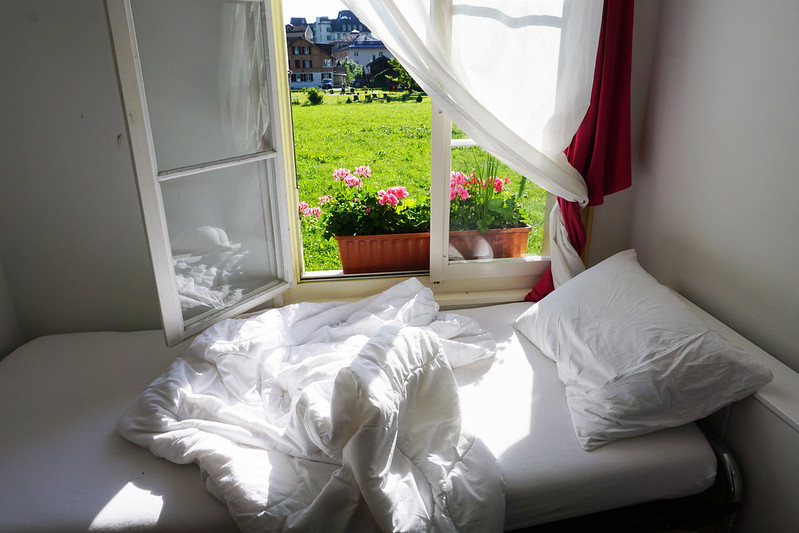
Food: Perhaps unsurprisingly, this foodie’s second highest expense is meals. I track my spending on groceries separately from my spending on eating out. I don’t put a budget ceiling on groceries because eating fresh, high-quality food is really important to me and I’d rather spend a bit more on groceries (and a bit less on other things) than take shortcuts with my health or joy.
In the states, I shopped at organic grocery stores and tried to buy healthier options, which were often a bit pricier. In Europe, I shop at fresh markets, local butchers, and tiny bakeries most of the time and stay away from imports that might have questionable chemicals or ingredients.
I always strive to only buy what I need and to buy it in the best quality, most local form I can. I mostly cook at home instead of eating out and when I do eat out I go for quality over quantity.
Recent grocery budgets have run about $393 ( Zagreb, Croatia ), $614 ( Thun, Switzerland ), $653 ( Bad Ischl, Austria ), and $429 ( Tartu, Estonia ). Eating out budgets in those same locations were around $257 (Zagreb), $0 (Thun), $41 (Bad Ischl), and $88 (Tartu). This means totals for those three places landed at $650 (Zagreb), $614 (Thun), $694 (Bad Ischl), and $517 (Tartu). As you can see, food spending varies, but not enormously. If you read my older budgets, you’ll also notice that the average has gone up over time (which makes sense, because inflation).

Transportation: Since I tend to stay longer in one place, transportation costs generally run pretty reasonable (e.g. far less than I spent when I owned a car). Every month or two, I buy a long-distance train ticket or two, and maybe once or twice a year I take a flight (though I try to fly as little as possible both because I hate flying and I try to be conscious of my environmental footprint).
In between big train journeys, I choose to walk whenever possible (which, in Europe, is nearly always) and only take buses and metros when the weather is walking-prohibitive, if the walk would be more than an hour long, if I’m carrying something heavy, or if I’m in a particularly busy city and the walk would be crowded or stressful.
These days, I spend anywhere from about $25 (Prague unlimited monthly transit pass) on a month where I’m staying put to $300ish (trains from Rennes, France, to Prague, Czech Republic) on a month when I’m moving from one base to another.
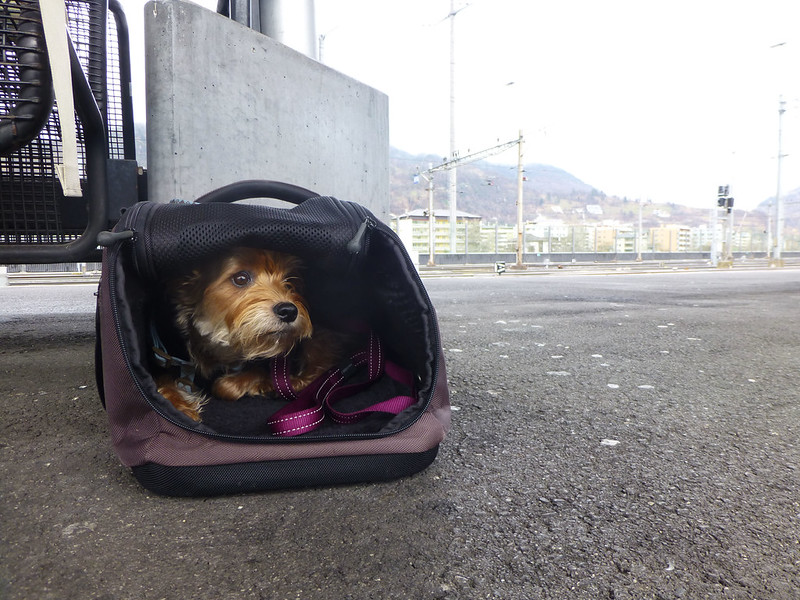
Luna the traveling pooch’s food and care: This varies a little from country to country, but rarely exceeds $200 per month. Luna eats a homemade diet primarily consisting of rabbit, fish, quinoa, and veggies (the diet was created with a veterinary nutritionist and if you decide to do the same, I highly recommend hiring one through your vet), and I’m not very strict about separating her food budget from mine, so expect that some of the grocery budget is actually going to Luna.
As with human health care, I’ve found vet care to be significantly more affordable in Europe (compared to the US). In Latvia, four injections, a blood test, two weeks of pancreatic enzyme pills, a vet consult, and an exam cost just over $100. In Dubrovnik, Croatia, in a similar vet emergency, the bill for the sedation, IV fluids, blood work, x-ray, exam, anti-nausea shot, and 100 days worth of pancreas pills was about $150. In the US, the cost would have been at least tripled in each of those cases. A single blood test in Colorado cost us upwards of $200 last time we were there.
Entertainment/fun money: When I’m traveling, most of my activities are free or cheap, so this line item is always pretty small compared to the others.
Supplies: These tend to run less abroad as well, in part because I am careful about what I buy, since I carry everything on my back, and, in part because I’m less bored and thus feel less of a need to shop. The ironic and wonderful thing about this is that the things I buy are often higher quality and more expensive, yet I generally spend less overall than I did in the states.

Health insurance and healthcare : Since I’m currently based in Portugal, I’m relying on the local health system. While traveling more extensively, I previously paid $268 per month for GeoBlue insurance that covered me anywhere in the world except the US. Before that, I tried travel insurance through World Nomads, which I found wildly frustrating (despite marketing themselves to travelers, they require you to jump through a LOT of paperwork hoops that require access to printers, scanners, and copy machines) and IMG Global, who ignored my emails and took months upon months to even acknowledge my claims after I was hospitalized on Malta. I would not recommend either company.
For anyone who’s used a healthcare system abroad, it’ll come as no surprise that pretty much everywhere in cheaper than the US. Pre-Obamacare, I paid $150 for three months of birth control pills in the US. A three-month supply (and a doctor visit to get the prescription) in Germany cost me under $100. In Switzerland, that number dropped to around $50. And in Vietnam, the same pills (same ingredients, different brand name) were $10 and available over the counter.
In all, I try to keep monthly spending under $2,500 (not including my business spending). And even with this as my budget ceiling, I often come in under. A few months ago, I did the math on the 30+ real Europe travel budgets linked below (scroll down for links) and the monthly average came in at $1,637 .
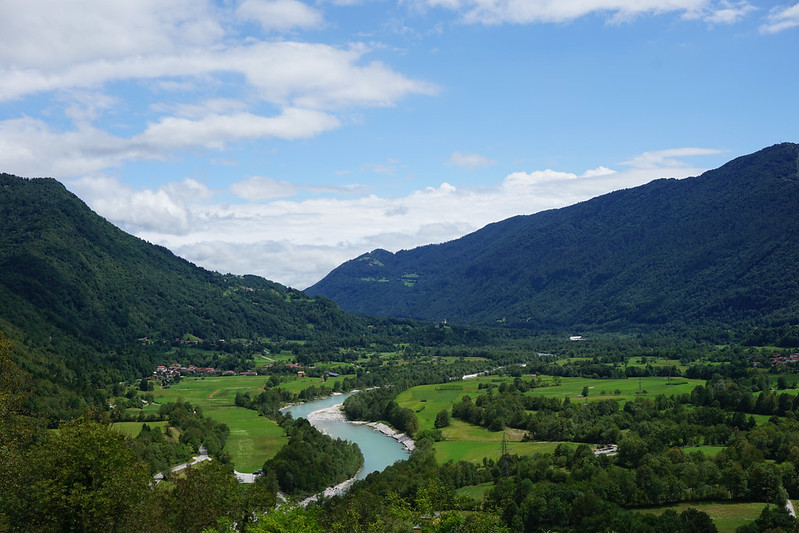
For those who’d like a more detailed look at my monthly budgets around the world, here they all are categorized by price range (click on the links for in-depth details on the budgets):
My real monthly budgets
From cheapest to most expensive monthly budget. Click on each location for a more detailed breakdown.
Non-European locations are marked with an *. My favorite places appear in bold. Cost is in parentheses. And I’ve indicated the year the budget is from (obviously account for some inflation when using budgets from 10 years ago) and whether the budget was solo travel or traveling with a partner/friend (partnered travel typically means lower housing costs).
Under $1350 per month:
Konjic, Bosnia and Herzegovina / one month ($1157) 2017 / partnered
Labin, Croatia / one month ($1175) 2021 / solo
Tartu, Estonia / one month ($1213) 2020 / partnered
Tulum, Mexico / one month ($1232)* 2018 / partnered
Kotor, Montenegro / one month ($1253) 2019 / partnered
Mostar, Bosnia and Herzegovina / one month ($1296) 2017 / partnered
Sayulita, Mexico / one month ($1301)* 2013 / solo
Riga, Latvia / one month ($1313) 2019 / partnered
Split, Croatia / one month ($1317 & $1241) 2019 & 2013 / partnered & solo
Zagreb, Croatia / one month ($1337) 2018 / solo
Playa del Carmen, Mexico / one month ($1350)* 2013 / solo

Under $1,500 per month:
Taormina, Italy / one month ($1364) 2017 / partnered
Porto, Portugal / one month ($1366) 2022 / solo, living full-time here
Kranjska Gora, Slovenia / one month ($1385) 2017 / partnered
Toledo, Spain / one month ($1388) 2015 / solo
Kobarid, Slovenia / one month ($1422) 2015 / solo
Brasov, Romania / one month ($1433) 2018 / partnered
Dubrovnik, Croatia / one month ($1443) 2017 / partnered
Tallinn, Estonia / one month ($1460) 2019 / partnered

Under $1,700 per month:
Interlaken, Switzerland / one month ($1558) 2019 / partnered
Ljubljana, Slovenia / two weeks ($808) 2015 / solo
Bad Ischl, Austria / one month ($1618) 2020 / partnered
Rennes, France / one month ($1648) 2018 / partnered
Nerja, Spain / one month ($1689) 2015 / solo
Edinburgh, Scotland / one month ($1697) 2012 / solo

Under $1,800 per month:
Ljubljana, Slovenia / second stay, one month ($1735) 2017 / partnered
Grenoble, France / one month ($1739) 2018 / partnered
Prague, Czechia / one month ($1752) 2018 / partnered

Under $2,000 per month:
Perugia, Italy / one month ($1882) 2013 / solo
Flagstaff, Arizona / one month ($1893)* 2016 / solo
Rome, Italy / one month ($1911) 2017 / partnered
Chamonix, France / two weeks ($962) 2015 / solo
Vancouver, Canada / one month ($1988)* 2016 / partnered
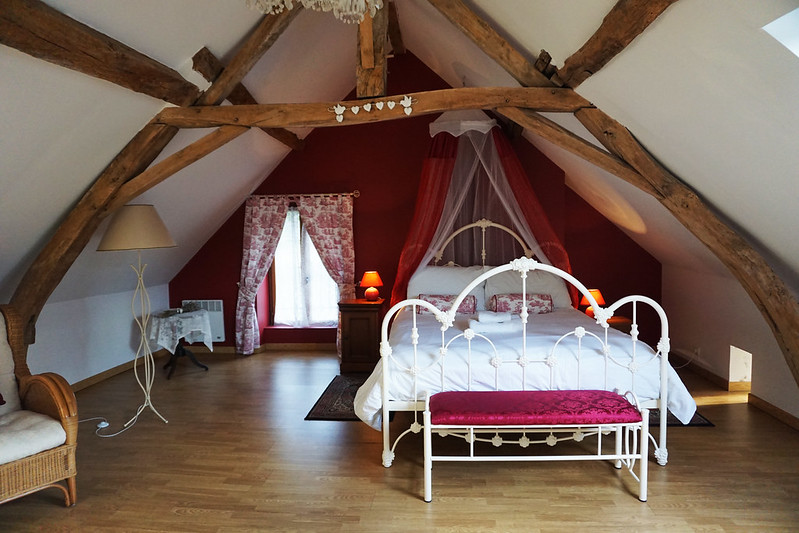
Over $2,000 per month:
Lauterbrunnen, Switzerland / three monthly budgets compared (varies) 2015 (and before) / solo
Amsterdam, Netherlands / two weeks ($1008) 2015 / partnered
Biarritz, France / one month ($2029) 2014 / solo
Innsbruck, Austria / one week ($511) 2018 / solo
Paris, France / one month ($2118) 2013 / solo
Thun, Switzerland / one month ($2124) 2021 / partnered
New York, New York, USA / one month ($2297)* 2018 / partnered
Zagreb, Croatia / one month splurge! ($2320) 2021 / solo
Opatija, Croatia / one month splurge! ($2897) 2021 / solo(ish)
Cycling across France / one month ($3091) 2015 / solo

My budgets for shorter trips
Now, what about short trips? Weekends, overnights, week-long vacations? I’ve got some real budgets on those too, though they’re fewer and farther between for me. Here are they, from cheapest to most expensive per-day:
Vrbovsko, Croatia / 3 days ($87 / $29 per day) 2021 / solo
Plitvice Lakes National Park, Croatia / 3 days ($184 / $62 per day) 2021 / solo
Denver to LA road trip / 2 days ($207 / $103 per day)* 2012 / solo
Tbilisi, Georgia / 10 days ($1050 / $105 per day)* 2019 / partnered
Colmar, France / 5 days ($539 / $108 per day) 2019 / partnered
Paris, France / 5 days ($663 / $133 per day) 2019 / partnered
Emilia Romagna, Italy / 5 days ($776 / $155 per day) 2014 / solo

Business costs
It’s worth noting that you won’t see any business costs in the above budgets. My business expenses vary greatly based on what I’m working on, how much active marketing/sales I’m doing, and what kind of side projects (blogs, self-published books, etc.) I’m taking on.
The few consistent things I pay for business-wise include:
Subscriptions for Microsoft Word, Adobe Photoshop, cloud storage, and a media subscription or two.
I now own a cell phone (turns out living full-time in Portugal requires one), but I also need a US number, so I use TextNow on my iPad for US calls/client calls. The basic number is free (because they serve up ads), but I pay a small fee in order to get a few extra benefits.
Business insurance , which runs me about $50 per month, and a yearly fee (about $100) for my registered agent to handle my LLC renewal and receive any business mail for me.
Once a year or once every few years, I also have expenses for web hosting and domain renewal for the website. This usually costs me less than $100 per year.

Taxes: Finally, a note on the most unavoidable of all expenses – taxes. In general (though not in every case), you are expected to pay taxes in the place you reside. If you live in the US, you pay in the US. If you live in Switzerland, you pay in Switzerland.
If you’re from the US, you’ll always have to file US taxes even if you’re a resident abroad, but you may be eligible for the FEIE , which is basically there to prevent you from paying double taxes. (Rather than get into it further here, I’ll suggest you book a consult with a US tax accountant. Many do free first consults and they will know so much more than I do about all the ins and outs of your particular situation.)
NOTE: If you’re paying in the states and self-employed, taxes are due quarterly, not yearly. This means when I’m paying in the States, I sit down every quarter and calculate the taxes I owe and send the government a check. At the end of the year, I hire a tax whiz (which generally runs me another $350 – $500) to help me make sure everything has been paid and filed properly.

Air travel expenses (& other big one-time costs)
There are a few things I don’t budget for monthly (or include in my monthly budget posts) because they are yearly or quarterly expenses and may vary greatly from month to month. One of these things is plane tickets .
I’m not a traveler who flies a lot, preferring to explore one continent thoroughly at a time and take trains where possible both because it’s simply a more pleasant way to travel, because it’s more environmentally responsible, and because the older I get the worse my motion-sickness gets, so flying has stopped being even a little bit fun.
So, since I’m not buying them monthly or even bi-monthly, I usually don’t track plane ticket costs monthly and instead factor them into my budget on a quarterly or yearly basis.
In 2021, I took four flights (one-way Switzerland to Croatia, one-way Croatia to Portugal, then round-trip Portugal – Croatia to collect my visa). In 2022, I only took one (one-way from Paris to Porto – I took trains in the other direction).
Replacing technology (my laptop or tablet), big one-time medical expenses, and other large one-time purchases (like my folding bike) are also something I look at quarterly or annually rather than monthly.

Saving money while traveling full-time
Finally, for me, part of feeling comfortable starting my business and then, a year or so later, leaving to travel full-time was having a decent financial buffer in the bank. I was advised while starting my business to have at least six months worth of expenses in the bank just in case. Being a bit neurotic about money, I waited until I had 10 months and enough clients that I was already almost breaking even.
Similarly, when I started traveling, even though I would be working normally and hopefully earning normally, part of feeling comfortable was the knowledge that I had a buffer. If all my clients ditched me in month one, I could live for a year without income (assuming I lived relatively frugally).

Everyone operates differently on this. When my aunt started her business, she quickly went into debt. Yet she was wildly successful over time. I’ve also heard stories of those who moved to a cheap part of Asia to start their business, which meant the limited funds they had could last them much longer while they got things off the ground. I know one man who told me it’s going to take $150,000 to start his business. Another woman told me a success story that started with just 3,000 euros in the bank. An old roommate told me she’s been traveling and working for years with just a few hundred euros to her name.
My income is variable , but I also try to set aside a decent percentage each month for the future –both to tackle unexpected expenses or emergencies, to be prepared for my yearly tax bills, and, of course, to create more security for myself in case I ever cannot or no longer want to work.

Any expenses you tend to have during travel that I haven’t mentioned? Any questions about travel expenses and budgeting? Toss them in the comments.
Share this post!
You may also like
Can you travel the world full-time & still be a responsible adult, how much does it cost to live in switzerland (three budgets compared), behind the scenes at my digital freelance business, august 2017, how to save money (or maybe even make money) on your next vacation, prices in croatia: two real budgets from travels in split, how much does it cost to spend a month in toledo, spain, leave a comment cancel reply.
Save my name, email, and website in this browser for the next time I comment.
17 comments
This is so cool. Thank you for this.
I’m living in a tiny house on a farm right now, but after my kid graduates high school I – or perhaps both of us – have considered living like this for a while. I’m building up my author/editor business, and it certainly would be nice to get around. I get really restless staying in one spot too long.
Glad you enjoyed it! And good luck!
Idnloke to know more about working abroad
If you are looking for info on my freelance career, here’s the skinny: https://gigigriffis.com/how-i-make-money-while-traveling-the-world-full-time-behind-the-scenes-with-a-location-independent-writer/
If you are looking for info on jobs abroad, I’m sorry to say I don’t have much info on that.
I’m not brave enough to try this with my husband and two kids, but I loved reading about how you do it! Kudos!!
Thanks for sharing your experience! This gives us an idea of how to budget for travel in Europe.
I am really enjoying following your adventures. I am waiting for a Portuguese residency permit and will be dipping my toe in the nomadic water soon. One question I am grappling with – what do you do for health insurance when you are back in the US?
For short trips, I get a temporary travel insurance plan (something like World Nomads even though their paperwork hassles are epic). But I think many European health plans also cover emergencies outside Europe, so might be worth looking into whether your Portuguese insurance will cover you once you’re resident there (I know in Switzerland the insurance we looked at covers US travel).
Amazing post!! Thanks for the detailed breakdowns. So happy to have found your site – it’s SO helpful and informative for slow travelers.
Great post! Thanks for sharing these insights with everyone. I wonder if you might answer a tax question. If one were to travel 1-3 months in each country, does that mean you need to file taxes in each of those countries plus the US?? I get if one were in the same country for over 6mo then that country would probably be considered the country of residence for tax filing purposes but what about when hoping county to county, never staying in any one country longer than 3mo??
Thanks in advance for any insights on my tax question!
Most countries don’t consider you a tax resident until you’ve been there more than 180 days in a year. Most tax accountants will do a free consult if you would like a professional perspective on your specific situation, though!
i’m a new dog owner (about 9 months) and also planning for a 6-month travel sabbatical in about 1.5 years. i’m still debating whether i should take my yoshi with me (he’s a 13 lb chiwienie). I’ve never flown with him before, and I’m wondering if you have any tips and tricks to help ease him into the process? you’re an inspiration!
Thanks! If you haven’t already, I’d read the Luna the traveling pooch section of the blog. https://gigigriffis.com/category/luna/ . There’s tons of stuff in there. The short answer is lots of treats and comfort toys inside the carrier (with the carrier open) in your house to get him used to and feeling safe in the carrier.
Thank you a million times over!
Thanks, Gigi. I needed this. It gives me courage as a single 55 yo American dude. I need some challenge in my life…something to conquer…something that will keep me on my toes. I’ve always suffered from bouts of wanderlust and I’m just plain DONE with corporate health/academic full time work. I did a back-of-the-envelope calculation on my expenses and came out around 2,200/mo traveling mostly in European Union with time in Serbia, Montenegro, B/H, SE Asia, Georgia and Turkey to mitigate the Schengen rules. Any reason you spent so little time in the Balkans? Is it a solo-female traveler thing? Sadly Russia appears off the list. I have spent a fair amount of time there before.
I have savings and a professional license (planning to do consulting over zoom). I plan to work part time (10-12 hours/wk) while honing film photography, reading for pleasure, learning about local history, and making friends. My budget is a bit lighter for accommodations (I don’t mind living in an Airbnb room) and heavier on LOCAL travel. I want to hike and spend time shooting landscapes in the areas I choose. This is a giant question mark in my mind. How to get to these places without a vehicle? I’m a bit reticent about using a scooter and don’t want to spend a fortune on taxi. I’m thinking there might be local bus service that gets me close in many places? Any insights here would be appreciated.
Your style is very much how I view my own journey. Stay in one place 1-2 months to maximize accommodation expenditures, minimize European touristy museums (been there done that—going to 1-2 local gems is my thought), mostly eat at home, and take rail day trips once a month with a night-over. Kudos for avoiding the BIG European cities. That is exactly my plan. I don’ think you could force me to spend time in Paris for more than 3 days, mirroring my aversion to New York, Chicago and LA. Lol.
Once again, thank you for the inspiration! Hit me up on email if you like. If you have any tips on making local friends in the places you traveled, I’m all ears. Stay safe and pleasant travels!
Hey! Glad it’s helpful and good luck!
To your questions:
1) I actually spent quite a lot of time in Croatia (in fact, got a visa for a year after living in Estonia 1.5 years during the whole covid fiasco). The Balkans outside Croatia are a touch trickier because of infrastructure (which goes to your second question, I suppose). There’s less train/bus access, so they are trickier to get to and trickier to get around without a car (and I detest driving). Croatia definitely has better infrastructure than some other spots, though I did enjoy my jaunt into Bosnia and Montenegro.
The other reason is the dog. They tend to be the less dog-friendly options in Europe. I felt fine as a woman traveling solo, but the dog complicates places like Bosnia (which I did spend some time in, despite this) and Albania.
2) The Schengen countries (for the most part, with a few exceptions) have great public transit, so I relied on that. For hiking/wilderness areas, I find that there is transit but it sometimes runs less frequently, so I just had to plan well and sometimes find myself a base very close to the wilderness areas to stay for at least a few days (I did this, for instance, for Bohemian Switzerland in Czechia). Other places (Switzerland, France) often have trails very integrated into every location and/or transit to even the remotest spots.
The places that are a bit more tricky tend to be places on the edges of Europe (the center is very well connected). So I had to get more creative in places like Portugal, Spain, and Estonia, which have somewhat less extensive public transit and more car culture. (Even so, I have never rented a car in any of those places and have relied on everything from infrequent buses to my bicycle to taxis or rideshares.)
Great! Thank you for the insights! I poked around your blog and found solid information on making friends. Funny, having a meal at home with a handful of people is definitely my style. :) I enjoyed many of the images on your blog. Particularly one from Italy with the path going along that turquoise river. Sublime! Excellent information on the hiking trails in different countries and your tip on staying close to trail systems for a handful of days. Lastly, your travels helped me to discover the inclusion of Portugal to the digital nomad parade! That’s particularly exciting to me as my younger brother and fam are planning a permanent move to Portugal (getting tired of Seattle/US health care/foods). Looks like potentially a more lengthy process? What an amazing time to see the world and work from anywhere! New DM visas are also popping up in SE Asia. Cheers!
This website uses cookies to improve your experience. Opt-out here if you wish! Accept Read more
Share on Mastodon

Europe Travel Guide
Last Updated: April 18, 2024

From beautiful Paris to smoke-filled coffeeshops in Amsterdam, Oktoberfest to La Tomatina, Europe is a massive, diverse continent with an unlimited assortment of things to see and do. You won’t have any problem filling your time, whether you’re backpacking Europe for a few months on a budget or just spending a few weeks there on a well-earned vacation.
The continent boasts wonderful beaches, historical architecture, amazing wine, and tons of world-class festivals. Every country is incredibly different from the next too, providing limitless variety in what you do during your trip.
I first backpacked Europe in 2006 and was hooked immediately. I’ve been visiting every year since, have run tours around the continent, and even wrote a book on traveling in Europe . It’s a destination I love and never get tired of exploring.
This guide will give you an overview of Europe and the tips and tricks you need to start planning your trip. I’ve also written extensive travel guides to each country on the continent (linked below in this post) so you can get more in-depth information for your specific itinerary too!
Table of Contents
- Things to See and Do
- Typical Costs
- Suggested Budget
- Money-Saving Tips
- Where to Stay
- How to Get Around
- How to Stay Safe
- Best Places to Book Your Trip
- Related Blogs on Europe
Click Here for Country Guides
Top 5 things to see and do in europe.

1. Tour the Greek Islands
These islands are the mecca of summer beach fun and each is unique in its own great way. There’s Ios (beach party central with archeological ruins and awesome boat tours); Kos (ancient ruins and nature); Crete (Bronze Age ruins of Knossos, hiking, beaches, and wine), Santorini (iconic blue water, white buildings, and local wineries); Mykonos , (the upscale party island with beautiful beaches, villages, and sunsets), Naxos (best island in the Cyclades). Plus, Milos, Corfu, Lemnos, Zakynthos, and so many more! With hundreds of islands in the country, you can always find what you are looking for!
2. Ride the rails
Europe is famous for its international rail system. Rail passes like the Eurail Pass have been around forever and still make it very easy to get from country to country on a relatively small budget (and with lots of flexibility). Europe has some of the fastest trains in the world that travel up to an incredible 217 mph (350 kph). The whole continent is connected by trains and there’s a growing push for even more connections and long-distance, high-speed trains in order to reduce flying and help combat climate change. There’s nothing more quintessential than riding the trains in Europe and I encourage you to take as many trains as possible. It’s one of the best ways to see the continent.
3. Get lost in Paris
The “City of Lights” is everything people say it is. I fell in love with it the first time I stepped foot in Paris . The city is just magical. You have a ton of museums, cafes, jazz clubs, famous art, and beautiful architecture. I love just strolling around the streets of the Quartier Latin (Latin Quarter) or Montmartre neighborhood as it makes for a breathtaking day. Another one of my favorite things to do here is just sit in the Jardin des Champs-Élysées park and picnic like the Parisians. For something a bit different, check out the famous Catacombs and Paris Sewer Museum. With so much to offer in the way of culture, history, and gastronomy, it would take years to see everything here but you can still get a good feel of the city in a few days.
4. Go city hopping
There are so many amazing cities in Europe that we’d need a top 100 to list them all. Here are some of my personal favorites and must-see cities: London is rich in history, culture, and the famous Big Ben clock; Edinburgh is a vibrant medieval city with cozy pubs and a famous castle with a huge New Year’s Eve Party; Amsterdam has cozy coffee shops and canopied tree-covered canals; Berlin has a wild party scene, street art, and the Berlin Wall; Barcelona has tapas, beach, and unique Gaudi architecture; coastal Lisbon has colorful tiles, old tramcars, cobblestone streets and plenty of fresh seafood; Prague has a beautiful intact Old Town, incredible architecture and eclectic bars; Tallinn Estonia has beautiful medieval buildings with colorful roofs. Florence is a mecca for Italian Renaissance architecture, art history, and gelato; Stockholm mixes medieval architecture and modern art and design. Crisscross the continent, take in the culture, and enjoy all the historic cities!
5. Hit the Alps
Whether you go skiing in the winter or hiking in the summer, the Alps hold some of the most breathtaking views in all the world. You don’t even need to be an expert hiker because there are mountain trails for all levels and crystal-clear Alpine lakes. Check out the spectacular Eibsee trail loop in Bavaria at the foot of Die Zugspitze, Germany’s tallest mountain, for the clearest, multi-colored, sparkling lake you’ve ever seen. Or the Männlichen Kleine Scheidegg Panorama trail in Switzerland’s stunning green and snow-capped Alps. Or visit Italy’s Dolomites in South Tyrol for the scenic Seceda trail. The Alps have trails for every fitness level and in every season.
Other Things to See and Do in Europe
1. tour amsterdam.
I love Amsterdam so much that I lived here for a short period of time in 2006. Here cobblestone and brick streets weave around lovely canals as people ride their bikes to and fro. My favorite things to enjoy here are Amsterdam’s vibrant art and music scene and there are also a ton of interesting museums here like the Anne Frank House, FOAM, the history museum, and the hemp museum. Be sure you get out of the center into Jordaan and Oost with their wonderful outdoor cafes and fewer tourists. Also, a visit to Amsterdam wouldn’t be complete without a canal cruise to visit the many islands and there are many to choose from that include snacks and drinks, sunset cruises, live guided tours, and more.
2. Hang out in Barcelona
Barcelona is a city that goes 24 hours a day, 7 days a week. It truly could give NYC a run for the “city that never sleeps” title. Be prepared for late-night dinners and parties until dawn. Besides a great food and nightlife scene, there is a wonderful beach, tons of Gaudi architecture (including the fairytale-like Parc Güell, as well as the iconic Sagrada Familia , which has been under construction for over 100 years!), incredible food tours, one of the best history museums in the country, and lots of outdoor spaces. What I love about Barcelona is that when you’re ready to chill, you can wander around Parc de la Ciutadella and marvel at the majestic fountains, plant life, and buildings created from an ornate military fortress.
3. Visit Berlin
Hip and trendy Berlin is an energetic destination. It is one of Europe’s most affordable capital cities, with a vibrant music and art scene and a growing foodie movement. Be sure to spend some time learning about the city’s darker history via the many excellent museums, memorials, and landmarks. The East Side Gallery, a section of the Berlin Wall that’s now painted with murals, and the Memorial to the Murdered Jews of Europe are two especially powerful reminders of Germany’s past. For all periods of German history, don’t miss the Deutsches Historisches Museum (German Historical Museum) – it’s one of the best history museums in the world. Once you’ve had your fill of history, relax in Berlin’s many green spaces, from Tempelhof Field, the site of a former airfield and popular local hangout spot, to Tiergarten, a tree-covered former hunting ground for 17th-century aristocrats.
4. Drink beer at Oktoberfest
Oktoberfest is a must for anyone going to Germany at the end of September. While not a budget option since beers now cost 15 € a maß, I love the energy and friendly camaraderie this event inspires. For two weeks, millions of people from all over the world gather for lots of beer, excitement, music, and wild fun. Watching thousands of people sing together, raising quart-sized beer mugs for endless toasts, and enjoying the general party atmosphere makes you feel good about the world. (Or maybe that’s just the beer?) Just be sure to book your accommodation well in advance and be prepared to pay top prices for them. If you don’t have an outfit, don’t worry, there are plenty of shops even at the main train station where you can buy a Bavarian dirndl dress and men’s lederhosen.
5. Experience London
Get a taste of English culture in diverse London . The museums here are some of the best in the world (most are free) and include the Tate, the British Museum, the City Museum, the National Gallery, the Historical Museum. There’s no shortage of iconic sights here as well, with Big Ben, the House of Parliament, the London Eye, the Tower of London, Tower Bridge, and of course, Buckingham Palace. I love London’s diversity because of the countless international eateries with great food and wonderful pub culture, perfect for after a long day seeing the sights. Head to Brick Lane on the weekends for some amazing food and craft markets. I prefer Paris to London, but there is something sophisticated and fun about London. Just watch those pints — London is not a cheap destination!
6. Get outdoors in Scandinavia
My favorite region in Europe is Scandinavia. The quality of life here is high, the people are beautiful and friendly, and the cities are clean and historic. Cycling the cities, taking canal tours, hiking the vast forested areas, archipelago hopping, enjoying fika (a Swedish coffee break), and warming up in saunas are just a few of the popular activities that await you here. True, this area of Europe is not cheap, but there are plenty of ways to reduce your expenses. Don’t let the high prices scare you away. Highlights for me include Copenhagen , Stockholm , Gotland, Norway’s fjords, and Lapland in Finland .
7. Get enchanted in Prague
Prague has an amazing history and is one of the most beautiful and picturesque cities I’ve ever seen. Highlights include the 9th-century Prague Castle, the magnificent Charles Bridge (built in the 14th century and one of the oldest standing bridges in the world), the 10th-century old square with its iconic astronomical clock, and the winding Jewish Quarter. Even if you only have a few days there don’t miss the free walking tour which is one of my favorites in Europe and the best way to learn about the Old Town and the tragic history of the city that went from thriving Bohemian capital of art, music, and literature to part of the Iron Curtain after WWII. Some of my favorite gems here include the fantastic black light theater shows in 4D and the one-of-a-kind medieval dinner show in an old tavern complete with musicians and jugglers not to mention hearty food and drinks. During the weekends it heaves with people enjoying the bars, cheap beer, and delicious food so try to visit during the week (and in the spring or fall) to beat the crowds.
8. Relax on the French Riviera
Here, you can pretend to live the high life for a little bit. Have fun in the sun, relax on the beach, swim in azure blue water, hobnob with the rich and famous, and sail on (or gaze at) gigantic yachts. As for cities, Nice is nice with its palm-tree-lined promenade, old town, and many art museums. If you want to go see how the rich and famous live, spend an afternoon checking out Cannes to soak up some glamorous vibes on La Croisette where they hold the famous Cannes Film Festival. The kingdom of Monaco with its tiny streets, beautiful buildings, and world-famous casino is just a skip away too.
9. Enjoy the great outdoors in Interlaken
Located in the beautiful mountains of Switzerland, Interlaken is a gorgeous place to unwind with fantastic hiking, delicious hot chocolate, and plenty of outdoor sports. The area is full of natural attractions to explore, including the St. Beatus Caves (complete with a legendary dragon), the cascading 500-meter-high (1,640 feet) Giessbach Waterfalls, the Jungfraujoch mountain railway (which leads to the highest train station on the continent), and a plethora of lakes (hence the town’s name). It’s a good alternative to all the cities and museums. Interlaken is also a popular party destination for backpackers and other young travelers. By far, my favorite scenic and visually stunning trail was the Oberberghorn panoramic hike, where you can wander the green mountain ridge ogling the amazing views and the turquoise-blue Brienzersee.
10. Experience history in Rome
In this thriving historical city, you can’t walk two feet without stumbling over a ruin, making Rome a history buff’s dream. Its tiny streets are perfect for wandering as you explore the Colosseum, see the Forum and Palatine Hill, visit the Pantheon, spend time in Vatican City, admire the Spanish Steps, and toss coins into the famous Trevi Fountain. The skip-the-line tickets can definitely be worth it so you don’t waste time waiting outside attractions. Rome also has amazing food (it’s Italy, after all) and nightlife. Visit the Trastevere area for a taste of “local” Rome and chill bars. It’s my favorite area in the city because you feel like you’re in a small village in the middle of a big city.
11. Hike around the Cinque Terre
Cinque Terre is my favorite part of Italy. These five beautiful cliffside towns are perched near warm waters and beautiful olive and grape groves. There are wondrous and strenuous hikes in these hills; for a real challenge, take trail #8. Or just walk the coastline for something less difficult. Many activities here revolve around the coastline: kayaking, swimming, having a beach picnic or visiting the Technical Naval Museum. If you happen to be here in December or January, don’t miss the Nativity Manarola, the world’s biggest lighted nativity scene.
12. Tour Krakow
Krakow looks like it stepped out of a medieval postcard. It’s a hip, trendy, and youthful city that’s the center of education in Poland, meaning there are a lot of university students here. Most travelers come to party here (the vodka is cheap) but try to enjoy the city’s history and food besides just the bars. Walk the Royal Road through the Old Town to the 13th-century Wawel Castle, tour Schindler’s Factory (where Schindler saved over 1,200 Jews during World War II), and visit the sobering Auschwitz-Birkenau concentration camp. You can also take a fascinating day trip to the UNESCO World Heritage Wieliczka Salt Mine, a 13th-century mine with cavernous chambers, statues, chapels, chandeliers, and cathedrals all carved out of salt.
13. Visit the ruin bars in Budapest
The coolest nightlife in all of Europe is found in Budapest . Built in abandoned buildings, ruin bars feature funky art installations, repurposed furniture, and quirky decor. They are amazing, fun, and great places to meet locals, as people of all ages flock here. Open since 2001, Szimpla Kert is the original ruin bar and one of my favorites, along with Instant-Fogas Complex, which takes up an entire building and is actually many different bars in one. Don’t skip the ruin bars — they’re one of the most unique things about the city!
14. Explore Cornwall
The best part of England is outside London, yet unfortunately, not a lot of travelers leave London. Head west to the area of Cornwall for cheaper prices, welcoming locals, natural beauty, great hiking, rolling hills, plenty of medieval castles, and picturesque small towns. If you like biking, the Camel Trail from Bodmin to Padstow is worth the trip and you even pass by a local vineyard. It’s an easy way to spend a day (and it’s pretty flat so it’s not too hard to do.) Plus, I had the best fish and chips in Cornwall! Overall, it’s what you think of as “traditional England.”
15. Walk the Camino
El Camino de Santiago (The Way of Saint James) is an ancient pilgrimage route that stretches from France all the way across northern Spain. It is a 500 mile (800 km) trail that winds through incredible terrain, ending in Santiago de Compostela at the cathedral where St. James is supposedly buried. As a pilgrim, you get a “pilgrim’s passport” which allows you to stay in affordable pilgrim-only hostels, making this a surprisingly budget-friendly adventure. While it usually takes over a month to complete, you can just walk a section if you don’t have the time. To receive a “Compostela” (certificate of completion), you just need to walk the last 62 miles (100 km), which generally takes 4-5 days.
16. Throw tomatoes during La Tomatina
By far my favorite festival, the largest food fight in the world happens during the last Wednesday of August in Bunol, Spain. What started in 1945 as a local brawl has turned into a massive event drawing tens of thousands of people from all over the world. For about an hour, everyone throws tomatoes at each other, leaving streets ankle-deep in tomato juice. Afterward, everyone walks down to the river, cleans off, and then heads to the town square for sangria and music.
17. Find Dracula in Romania
Not a lot of people visit Romania but this underrated country in Eastern Europe has undiscovered yet picturesque medieval towns like Brasov (home to “Dracula’s castle”), Sighisoara, and Sibiu; gorgeous beaches on the Black Sea; and incredible hiking in the Fagaras Mountains — all at dirt-cheap prices. Other major sights include frescoed Byzantine monasteries, the steepled wooden churches of Transylvania, the hip university town Cluj-Napoca, the post-communist capital of Bucharest, and the Danube Delta, a huge nature reserve.
18. Drink whisky in Islay
Whisky has a long history on Islay , an island off Scotland’s west coast. It’s been made there since the 16th-century — first in backyards and then, starting in the 19th-century, in large distilleries. Over the years, whisky from the island came to be considered a specialty and was used to flavor a lot of other blends on the mainland. There are currently nine working distilleries on the island, all located along the island’s shores, with Laphroaig, Ardbeg, and Lagavulin being the most famous. Most distilleries here make single-malt Scotch, meaning that only one type of grain (barley) is used. My visit here was amazing and, even if you don’t like whisky, there are tons of good hikes and walks throughout this magnificent island.
19. Explore Iceland
Iceland is a magical country with majestic waterfalls, hidden hot springs around every corner, and sweeping vistas unlike anywhere else in the world. After my first visit, the country quickly became one of my favorite countries. With whale watching in the summer, the northern lights in the winter, and geothermal baths for soaking in year-round, there really is no bad time to visit! While Iceland’s main draw is the epic natural landscapes, it’s worth spending a couple of days in Reykjavik with its café culture, artsy feel, and brightly colored wooden row houses.
20. Sail the Croatian coast
With calm winds, short distances, a coastline littered with over 1,000 islands, and countless historical sites, Croatia is one of the world’s best sailing destinations. If you can, go during the shoulder season when you can find some great deals. Plan to stay at least a couple of days on one of the islands, with the most popular being Brac, Hvar, Krk, Cres, and Lošinj. However, don’t be afraid to get off the beaten path and explore some of the lesser-known islands such as Silba, Vis, and Lastovo. If you want to splash out and spend a week partying on a yacht, check out The Yacht Week, which hosts week-long parties, complete with DJs, from May-September. You can book a full boat to share with friends or just a cabin if you’re traveling solo. Prices start at 5,250 HRK per person and go up to 9,300 HRK.
21. Explore the Balkans
While the Balkans have become more popular with backpackers in recent years, it’s still largely overlooked by most budget travelers, despite being an extremely budget-friendly region. The Balkan peninsula is home to great (and again, overlooked) wine, beautiful medieval towns like Kotor and Mostar, stunning mountainous landscapes, beautiful pebble beaches, coffee culture, fresh, hearty yet inexpensive food, and museums covering the area’s history, including the most recent turbulent events of the early 1990s. I especially loved my time in Albania . Don’t miss the beautiful beaches in Ksamil, nicknamed the “Maldives of Europe’ as well as the mountain village of Gjirokastër, which was occupied by Romans, Byzantines, and Ottomans. The Balkans have so much to offer for every budget and every country has its unique cultural flavor.
22. Take a wine tour in the Loire Valley
Located in central France, the picturesque Loire Valley is a UNESCO World Heritage site and stretches 280 kilometers (174 miles) along the Loire River. One of the major wine-producing regions of France, the area is home to some of the best wines in the world, with over 1,000 vineyards open to the public. Even those who don’t drink wine will enjoy the beautiful small towns, great food, and the region’s over 300 impressive chateaux. I loved the medieval Chenonceau Castle and Chateau Villandry and the small villages like Saint-Florent-le-Vieil. Spring and Autumn are my favorite times to visit because you can go biking and do outdoor activities when it’s not too hot and there are fewer people. It’s an area not to be missed.
23. See Fado in Portugal
Fado is an important musical tradition in Portugal , originating in Lisbon and stretching back some 200 years. The word “fado” likely stems from the Latin word for fate, and it’s very haunting, poetic, and emotional music. Most of the songs follow themes of loss and mourning, and the music was popular with the working class (especially sailors). Performances normally take place in restaurants during dinner. In Lisbon, head to Clube de Fado, Tasca do Chico, Parreirinha de Alfama, or Senhor Vinho.
24. Tour green Slovenia
Slovenia is one of Europe’s least-visited destinations, which is mind-blowing to me because it’s an amazing place to visit. Slovenia offers all the beauty of Western Europe but at a fraction of the cost and with a fraction of the crowds. Perfect for outdoor adventure lovers, Slovenia offers rugged mountains, untouched landscapes, fantastic ski resorts, plentiful wine, sprawling cave systems, incredible food, and postcard-perfect lakes, such as the famous Lake Bled with its castle on an island. I loved Piran, Slovenia’s often overlooked coastal Venetian-style harbor town that was actually founded 3000 years ago. Stroll around its beautiful windy cobble-stoned streets, beautiful plazas, and take advantage of the many affordable restaurants right on the water. Make sure to also spend a few days in the country’s capital, Ljubljana, known as one of the continent’s greenest and most livable cities. Take a river cruise to see the city and enjoy the friendliness of the locals.
For more information on specific countries in Europe, check out the guides below:
- Albania Travel Guide
- Austria Travel Guide
- Belgium Travel Guide
- Belarus Travel Guide
- Bosnia & Herzegovina Travel Guide
- Bulgaria Travel Guide
- Czechia Travel Guide
- Croatia Travel Guide
- Denmark Travel Guide
- England Travel Guide
- Estonia Travel Guide
- Finland Travel Guide
- France Travel Guide
- Germany Travel Guide
- Greece Travel Guide
- Hungary Travel Guide
- Iceland Travel Guide
- Ireland Travel Guide
- Italy Travel Guide
- Latvia Travel Guide
- Lithuania Travel Guide
- Malta Travel Guide
- Moldova Travel Guide
- Montenegro Travel Guide
- Netherlands Travel Guide
- Norway Travel Guide
- Portugal Travel Guide
- Poland Travel Guide
- Romania Travel Guide
- Scotland Travel Guide
- Slovakia Travel Guide
- Slovenia Travel Guide
- Spain Travel Guide
- Sweden Travel Guide
- Switzerland Travel Guide
- Ukraine Travel Guide
Europe Travel Costs

Accommodation – Accommodation prices vary greatly by region. In Western Europe, hostel dorm rooms cost between 25-45 EUR per night, depending on the room’s size and the popularity of the hostel. I stayed in a 6-bed dorm in Berlin for 20 EUR, while the same one would have cost me around 45 EUR in Paris. A room in Paris costs on the higher end and a room in cheaper Athens costs on the lower end.
In Eastern Europe, hostel dorm rooms cost between 10-15 EUR per night depending on the size of the dorm room and the popularity of the hostel. The further east you go, the cheaper it gets. Expect to pay around 30-60 EUR per night for a private room that sleeps two.
In Scandinavia, hostel dorm beds cost around 25-45 EUR, while private rooms are 65-80 EUR. Budget hotels start around 85 EUR.
Most accommodations offer free linens, free Wi-Fi, and a lot offer free breakfast, but it’s important to check specific websites for exact amenities.
Campsites cost between 10-15 EUR per night for a basic plot for two without electricity.
Food – Food traditions in Europe run deep, stretching back centuries to become integral parts of each country’s culture. From baguettes in France to tapas in Spain, from hearty Eastern European stews and goulash to the fresh vegetables and olive oils of the Mediterranean, European cuisine varies as much as the countries themselves. Food prices differ greatly across the continent, so check individual country guides for specifics.
But no matter where you are, even in the more expensive countries, finding places to eat within your budget is easier than you might think. Throughout Western Europe, you can find small shops, street food stalls, or food trucks where you can get sandwiches, gyros, kebabs, slices of pizza, or sausages for between 3-7 EUR. These shops are most often found in train stations, bus stations, and main pedestrian areas, and offer cheap food alternatives that can have you eating on 12-17 EUR per day. Fast food (think McDonald’s) costs around 7-10 EUR for a combo meal.
Turkish, Middle Eastern, and Vietnamese eateries abound in Germany, while Indian food is incredible and everywhere in the United Kingdom. Meals at these restaurants usually cost between 8-12 EUR.
Restaurant meals in casual, traditional eateries generally cost around 13-25 EUR for a main dish and drink. Food is much cheaper in the east than in the west, and in the west, northern regions like Scandinavia and the UK are more expensive than southern countries like Spain, Portugal, and Italy.
In Eastern Europe, even if you are eating out for all your meals, you can still get by on a food budget of as little as 15 EUR per day.
For drinks, a pint of beer is 2-5 EUR, a glass of wine is 2-7 EUR, a cappuccino is 2-5 EUR, and cocktails range from 6-14 EUR.
If you eat out, do so at lunch and get the prix-fixe menu (two-course or three-course set menu). Restaurants offer this set menu during lunch, and with prices between 10-20 EUR, it’s a way better deal than the regular dinner menu. You can also get affordable lunches at outdoor markets. So many European cities have huge fresh food markets throughout town.
You can cook your own food for around 45-65 EUR per week. This gets you basic staples like rice, pasta, seasonal produce, bread, and some meat. You can save money by shopping at discount supermarkets like Profi, Lidl, Aldi, and Penny Market.
If you want to save big money on meals, head to one of the markets, pick up some cheese, wine, bread, meats, or anything else, and go to the park for a picnic. (Or grab a sandwich for later!) You’ll find the locals doing the same thing, and it’s one of the cheaper ways to get a true taste of local food.
Backpacking Europe Suggested Budgets
Prices for travel in Europe vary greatly depending on how far north, east, south, or west you travel. If you stick to the budget accommodations, food, and tours listed here and use all my tips on saving money, you need about 65-110 EUR per day in Western Europe, 40-50 EUR in Eastern Europe, and about 85-130 EUR in Scandinavia.
Those numbers reflect a traveler who stays in hostels, cooks some meals and eats out cheaply, enjoys a few drinks, and sticks to free and cheap activities like hiking, walking tours, and enjoying nature. This is your typical backpacker budget. You aren’t going to have a fancy time, but you aren’t going to want for anything either.
However, by getting tourist cards and rail passes, avoiding flights, occasionally Couchsurfing or camping, cooking all your meals, and not drinking, you can travel a lot cheaper. On this budget, you could do Western Europe on 35-45 EUR per day, Eastern Europe on 20-25 EUR, and Scandinavia on 50-65 EUR. That would require you to take a train or a bus or hitchhike everywhere, skip most museums, and limit how often you go out.
Generally, the suggested daily budget for Europe is 80-120 EUR. You can use the chart below to get an idea of how much you need to budget daily. Keep in mind these are daily averages – some days you’ll spend more, some days you’ll spend less (you might spend less every day). We just want to give you a general idea of how to make your budget. Prices are in EUR.
Europe Travel Guide: Money-Saving Tips
Individual country guides have more specific information on how to save money in them but here are some general tips on cutting your costs while you explore Europe:
- Picnic – This continent has a lot of little shops where you can buy pre-made sandwiches or ingredients to make your own. Many supermarkets have delis as well where you can get food to go. Buy some food, eat outside, and watch the city and its people go by. It’s a much more enjoyable and cheaper way to eat.
- Eat local and cheap – Not into picnicking? Eat at local sandwich shops, pizza parlors, Maoz, Wok to Walks, and outdoor street vendors. Avoiding restaurants and eating at a lot of the local “grab n’ go” places gives you a taste of the local cuisine at a much cheaper price. If you’re really on a budget, use your creative cooking skills to prepare meals at the hostel as well.
- Stay with a local – Hostels can add up really quickly. If you don’t have any friends with whom you can stay, consider using Couchsurfing , which connects you with locals who let you stay with them for free. Plus, they tend to also have meetups to meet other locals and travelers. It’s a great way to save on accommodation and meet a local who can share their insider tips and advice.
- Camp in a garden – A very good camping service specific to Europe is Campspace , which allows you to pitch a tent in someone’s backyard for free or for a small fee (around 10-20 EUR). All of the garden owners have profiles that tell you what services and facilities they offer. Also, many countries allow wild camping (like Sweden), which can save you a fortune if you have a tent.
- Take the bus – Budget bus companies like Flixbus can take you across the continent for cheap. I personally feel it’s best for day travel as sitting up for an overnight bus isn’t really ideal for sleeping. It isn’t glamorous, but with tickets starting at 5 EUR, you really can’t complain!
- Get a Rail Pass – Eurail Passes have saved me hundreds of dollars. If you are traveling far distances and through many countries, they are a great deal.
- Take the free city tours – One of the great things about Europe is that you can find free walking tours in all the major cities. They can be a great way to see the city attractions, take in some history, and learn your bearings without spending any money. Just make sure to tip your guide at the end!
- Plan accordingly – Plan your trip around Europe so you avoid doubling back. Transportation is a big expense so proper planning can save you a lot of money (and time). Go in a straight line or a loop. Booking your accommodation ahead helps you save as well since cheap, good places unsurprisingly get reserved first. One thing I’ve learned is that waiting until the last minute means you get stuck with expensive places or cheap places no one wants.
- Fly cheap – If you know where you are going and a train won’t do, try to book flights early. You can often get round trip fares for as little as 5 EUR from many of the European discount airlines like Ryanair or Wizz. Many capital cities have smaller airports farther from the city with ‘inconvenient’ times but cheaper fares. Keep in mind you might need to factor in an early morning Uber or taxi if the busses aren’t running and you have an early flight!
- Drink less – Those 5 EUR beers add up. Hit happy hours or pick and choose when you party. Hostel bars are a good place to get cheap drinks or buy your alcohol at the supermarket. Plus, in Europe, it’s legal to drink outside in parks, plazas, by the lakes or rivers. You’ll find you can save a lot of money by not going to bars and clubs. Partying your way across the continent will destroy your bank balance in no time.
- Get a city tourist card – Many local tourism offices sell a tourism card for all their attractions, tours, and restaurants. This card gives you free entry and substantial discounts on all the attractions and tours in a city, free local public transportation (a huge plus), and discounts at a few restaurants and shopping malls. They save a ton of money. If you plan on doing a lot of sightseeing, get one of these cards.
- Rideshare – If you’re flexible in your schedule, use the ridesharing service BlaBlaCar to catch rides with locals between cities (or countries) by paying a small fee. It’s like Airbnb but for rides. I used this service in Switzerland and, not only did I save a lot of money, but I got to meet interesting people and learn about local culture and life. Drivers are verified and it’s perfectly safe, though sometimes rides cancel at the last minute (which is why you need to be flexible). Check their ratings first and try to use rides where the person has done many trips.
- Bring a water bottle – The tap water is safe to drink in most of Europe, so bring a reusable water bottle to save money and reduce your plastic use. LifeStraw is my go-to brand as their bottles have built-in filters to ensure your water is always clean and safe.
- Get a HostelPass – HostelPass is a discount membership for hostels in Europe. Members get 10-20% off select hostels around Europe, as well as perks like free breakfast or free drinks. There are discounts on tours and activities too. It’s a great way to save money if you’re bouncing around Europe as they have hostels in 18 countries around the continent.
Where to Stay in Europe
Europe has a ton of budget accommodation options. The individual country and city guides have tons of recommendations but here’s a short list of some of my favorite budget hostels and hotels around Europe:
- The Flying Pig (Amsterdam, The Netherlands)
- Hotel 54 (Barcelona, Spain)
- Generator Hostel (Copenhagen, Denmark)
- Harcourt Hotel (Dublin, Ireland)
- Castle Rock (Edinburgh, Scotland)
- Ios Palm Pansion (Ios, Greece)
- Greg and Tom’s Party Hostel (Krakow, Poland)
- Largo da Sé Guest House (Lisbon, Portugal)
- Sophie’s Hostel (Prague, Czech Republic)
- The Yellow (Rome, Italy)
- City Backpackers (Stockholm, Sweden)
How to Get Around Europe

Public transportation – Transportation around most European cities is by tram, subway, or bus. Prices are typically around 2 EUR for a one-way ticket in Western Europe and closer to 1 EUR in Eastern Europe. Most large cities also have day passes available that offer unlimited public transportation. These passes are usually 5-12 EUR per day.
In large cities with international airports, there is usually a bus or train available that ferries travelers from the downtown core to the airport. Expect to pay around 5-15 EUR to get to/from the airport.
Bus – Buses are not quite as comfortable as Europe’s trains, although certain lines do have great amenities (like roomy seats and Wi-Fi). While buses are not the most efficient way to travel around the continent, they’re certainly dependable, reliable, and cheap. You can find last-minute rides for as little as 5 EUR. A route from Berlin to Munich is about 25 EUR, while Paris to Bordeaux can be as low as 10 EUR. Longer routes, like Amsterdam to Copenhagen, start at around 47 EUR.
Each country has its own national bus service, but some lines also take you long distances internationally. Megabus and Flixbus (which now owns Eurolines) are the most popular companies.
Train – Train travel is a great way to see Europe. Intercity train prices vary wildly from country to country, depending on whether you take the slow train or a high-speed train and how far in advance you book. For example, a high-speed train from Berlin to Munich costs around 38-60 EUR, Bordeaux to Paris is about 50-85 EUR, and Madrid to Barcelona ranges from 45-85 EUR. Non-high-speed trains and other intercity lines are a lot cheaper, generally costing about 40-50% of the price of high-speed trains. Eastern Europe inter-country trains usually cost between 45-100 EUR when the ticket is booked last minute. Short train rides of 2-3 hours within countries cost about 27 EUR.
To find routes and prices for trains around Europe, use Trainline .
You may also want to consider getting a Eurail Pass , which allows travelers to explore Europe by providing a set number of stops in a specific time period. These passes are continent-wide, country-specific, or regional. It can potentially save you hundreds of dollars.
Ridesharing/Car sharing – If your schedule is flexible, use a ridesharing service and catch rides with locals between cities (or countries). Drivers are verified and it’s perfectly safe. BlaBlaCar is the most popular.
If you’d rather rent a car yourself and find passengers to share a ride with, use Discover Cars to find the best car rental prices.
Flying – Budget airlines are so prolific that competition helps keep fares low. You can often find tickets where the fare is just 5 EUR round-trip! Companies like EasyJet, Ryanair, Wizz, and Vueling offer mind-blowingly cheap flights throughout Europe. Book at least a month early to scoop up great deals.
Make sure that the airport they fly into isn’t too far out of your way (transportation from the secondary airport sometimes negates the savings from using the budget airline itself).
Keep in mind that you’ll have to pay to check your baggage on these cheap flights. It costs about 25-39 EUR for one checked bag. If you wait to pay for your luggage at the gate, you end up paying almost double. Travel carry-on only to avoid this added cost.
Hitchhiking – Hitchhiking in Europe is very safe, but it’s not for everyone. Hitching is quite common around the continent and I’ve met a number of travelers who have done it (I, myself, traveled this way in Bulgaria and Iceland). Some countries are very supportive (Romania, Iceland, Germany) while others may be a bit more time-consuming (Italy, Spain). HitchWiki is the best website for hitchhiking info.
Here are my suggested articles for how to get around Europe:
- 7 Cheap Ways to Travel Across Europe
- Are Eurail Passes a Giant Scam or Do They Save You Money?
- The Ultimate Guide to Finding Cheap Flights
When to Go to Europe
There’s no wrong time to visit Europe. Peak season is summer, when Europe gets crowded and August is the time most European families are at the beach so everything becomes more crowded and expensive. But the overall atmosphere and weather are great during this time, so it’s still worth visiting during peak season (just book your accommodation in advance — especially in August). Keep in mind it’s much hotter in summer so if you like AC, be sure to check that your hostel or hotel has it before you book. You can expect the most crowds in Western Europe. For this reason, I feel summer is a great time to visit the Balkans and the Baltics because many people head to the beaches in Spain, France, Italy, Croatia, and Greece.
Shoulder season is spring and fall (April-May and September-October). It’s still warm during this time but there aren’t as many crowds and prices are cheaper. This is my favorite time to visit hotspot places like Spain, Croatia and Greece, where it’s still hot enough to swim in the sea but you have way more room on the beach. It’s also a good time to go hiking in the Alps in Germany, northern Italy, Slovenia and Switzerland because it’s cooler during the day so you’re much less sweaty on the mountain without shade. The weather is good, the crowds are smaller, and the prices lower.
Winter is from November to February but in much of Central Europe, it’s wet and cold until March or April. It gets cold, even as far south as it gets (like Greece). On the other hand, the Christmas season has Christmas markets and festivals galore! Even if it’s cold, this is a cultural tradition you can’t miss and why I love Europe in December. There is hot mulled wine, sweets, and plenty of hot snacks, which vary by country. One of my favorites is Prague because the Old Town Square is lit up with a gigantic tree with aromas of crispy cinnamon pastries and mulled wine. Berlin takes their Christmas markets very seriously, so there are around 80 different markets with special themes.
Winter is fantastic in Europe for skiing and snowboarding but it doesn’t have to break the bank if you plan carefully. While Switzerland and France are probably the most famous, they are also expensive, but there are plenty of budget winter options.
How to Stay Safe in Europe
Europe is very safe for backpacking and solo traveling, even if you’re traveling solo, and even as a solo female traveler. Violent crimes against tourists are very rare. In fact, some of the safest countries in the world are in Europe. (I wrote a whole article about how Europe is safe to visit right now .)
That said, there are scams and petty crimes you should watch out for, especially around popular tourist landmarks. The most important thing to be aware of is pickpockets in crowds and on public transportation. Zip your bags and don’t put your mobile phone in a jacket pocket where someone could quickly take it. This should be obvious but don’t flash your money to let everyone know you have a huge wad of cash.
When choosing a hostel, look for ones with lockers. It’s always a good idea to carry around a padlock or combination lock. Most hostels are safe and travelers respect each other and I’ve rarely seen things happen to people’s valuables. Nevertheless, I always think that prevention is better.
As anywhere, the standard precautions apply (never leave your drink unattended at the bar, never walk home alone intoxicated, etc.). When at the bar, always keep an eye on your drink. Avoid walking home alone at night if you’re intoxicated.
For female travelers in particular, it’s always a good idea to have a bit of extra money on you just in case you need to take an Uber or taxi back by yourself so you don’t take unnecessary risks to save money. If you’re using apps to date people while traveling, please use common sense and meet in public places. Since I’m not a female traveler, please check out the numerous female bloggers who have first hand knowledge of this.
If you’re worried about scams, you can read about common travel scams to avoid here.
If you rent a vehicle, don’t leave any valuables in it overnight. Break-ins are rare, but it’s always better to be safe than sorry. Be aware that the UK drives on the left and that most rental cars in Europe will have manual transmissions unless you request otherwise.
When hiking, always bring water, sunscreen, and bandaids or foot plasters. There is nothing worse than being halfway up the mountain with a blister and nothing you can do about it!
Likewise, when at the coast, don’t forget not only to wear sunscreen! I can’t tell you how many times I’ve seen people get burnt to a crisp the first day. Be sure to check the weather before you depart and dress accordingly.
If you do experience an emergency, dial 112 for assistance.
Always trust your gut instinct. Make copies of your personal documents, including your passport and ID. Forward your itinerary to loved ones so they know where you are.
The most important piece of advice I can offer is to purchase good travel insurance. Travel insurance will protect you against illness, injury, theft, and cancellations. It’s comprehensive protection in case anything goes wrong. I never go on a trip without it as I’ve had to use it many times in the past. You can use the widget below to find the policy right for you:
Europe Travel Guide: The Best Booking Resources
These are my favorite companies to use when I travel. They consistently have the best deals, offer world-class customer service and great value, and overall, are better than their competitors. They are the companies I use the most and are always the starting point in my search for travel deals.
- Skyscanner – Skyscanner is my favorite flight search engine. They search small websites and budget airlines that larger search sites tend to miss. They are hands down the number one place to start.
- Hostelworld – This is the best hostel accommodation site out there with the largest inventory, best search interface, and widest availability.
- Booking.com – The best all around booking site that constantly provides the cheapest and lowest rates. They have the widest selection of budget accommodation. In all my tests, they’ve always had the cheapest rates out of all the booking websites.
- HostelPass – This new card gives you up to 20% off hostels throughout Europe. It’s a great way to save money. They’re constantly adding new hostels too. I’ve always wanted something like this and glad it finallt exists.
- Get Your Guide – Get Your Guide is a huge online marketplace for tours and excursions. They have tons of tour options available in cities all around the world, including everything from cooking classes, walking tours, street art lessons, and more!
- The Man in Seat 61 – This website is the ultimate guide to train travel anywhere in the world. They have the most comprehensive information on routes, times, prices, and train conditions. If you are planning a long train journey or some epic train trip, consult this site.
- Rome2Rio – This website allows you to see how to get from point A to point B the best and cheapest way possible. It will give you all the bus, train, plane, or boat routes that can get you there as well as how much they cost.
- FlixBus – Flixbus has routes between 20 European countries with prices starting as low 5 EUR! Their buses include WiFi, electrical outlets, a free checked bag.
- SafetyWing – Safety Wing offers convenient and affordable plans tailored to digital nomads and long-term travelers. They have cheap monthly plans, great customer service, and an easy-to-use claims process that makes it perfect for those on the road.
- LifeStraw – My go-to company for reusable water bottles with built-in filters so you can ensure your drinking water is always clean and safe.
- Unbound Merino – They make lightweight, durable, easy-to-clean travel clothing.
- Top Travel Credit Cards – Points are the best way to cut down travel expenses. Here’s my favorite point earning credit cards so you can get free travel!
GO DEEPER: Nomadic Matt’s In-Depth Budget Guide to Europe!

While I have a lot of free tips on Europe, I also wrote an entire book that goes into great detail on everything you need to plan a trip here on a budget! You’ll get suggested itineraries, budgets, even more ways to save money, my favorite restaurants, prices, practical information (i.e. phone numbers, websites, prices, safety advice, etc etc), and cultural tips.
I’ll give the insider view of Europe that I got from years of traveling and living here! The downloadable guide can be used on your Kindle, iPad, phone, or computer so you can have it with you when you go. Click here to learn more about my book on Europe!
Europe Travel Guide: Related Articles
Want more tips for your trip? Check out all the articles I’ve written on Europe travel and continue planning your trip:

The 7 Best Hotels in London

10 Scotland Road Trip Tips You Need to Know Before You Go

The Perfect 7-Day Croatia Itinerary

The 6 Best Hotels in Copenhagen

The 6 Best Hotels in Florence

The 7 Best Hotels in Madrid
Get your free travel starter kit.
Enter your email and get planning cheatsheets including a step by step checklist, packing list, tips cheat sheet, and more so you can plan like a pro!

- Where To Stay
- Transportation
- Booking Resources
- Related Blogs
You are here
How much money do i need to travel europe.
For some people, setting a budget is just one more exciting thing to do when planning their European holiday. Mainly because it gives them an opportunity to dream about the castles and banquets they’ll be spending their euros on.
Then there are others who dread the whole ordeal – probably the same people who haven’t visited the dentist in a year.
Knowing things is hard. And who’s got time for calculations?*
Allow me to introduce you to the amazing Holiday Budget robot planner 3000! (Well, it’s not really called that). Planning a budget is hard, it’s not like you just know the cost of a bratwurst and a 1L jug of beer in Munich off the top of your head is it? That’s impressive if you do, but our Holiday Budget Planner actually does know that kind of stuff. Try it out below!
*Ain’t nobody got time for that.
Try our fancy new budget calculator (above) now!
How to plan a trip to Europe with a budget
First up, you need to figure out what you need to budget for.
To work out your rough costs, you’ll need to know:
- Where you’re going – for flight costs.
- How long you’ll be away – for nightly accommodation costs.
- How you want to get around – for transport costs.
It also helps to budget with those you’ll be travelling with, so you can work out what costs are solely yours and what you can share. It’s also a good way to set out what type of holiday you want to have. If you’re a budget traveller who wants to hostel-hop your way through Europe, your budget will be very different to the traveller that wants 5-star, all-inclusive, buffet breakfast, city-view, luxury hotels.
I_DemiQuinn_Mykonos-770x578_90kb.jpg
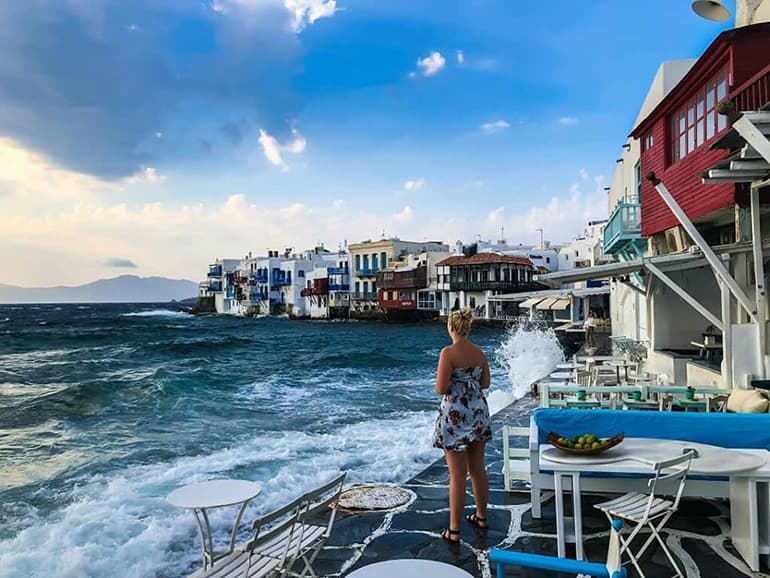
How much does a Europe trip cost?
Let’s take a look at a few examples of different kinds of holidays you could have in Europe, and address some of those big-ticket costs that need to be budgeted for.
The lovey-dovey couple
This romantic pair is travelling through London for 2 weeks during its beautiful, warm summer. Between them, they’ll need just under $10,000 AUD for flights, accommodation and daily transport.
The solo backpacker
This lucky vagabond is travelling Solo (not even Chewbacca is invited). They’re hitting up France , Spain , Italy and Greece for a whole month of adventure. Depending on how frugal they decide to be, they’ll need about $4,000AUD for flights, accommodation and public transport. Don’t forget to budget your meals and adventures though!
The fun family
This wonderful family of 2 adults and 2 kids (under age 11) is going on a cruise to visit Barcelona during the school holidays – lucky kids… The parents will need to save around $13,000AUD worth of pennies to afford the flights, cruise and accommodation for this trip.
Note that these are your core expenses. Other costs from travel insurance, daily expenses like food and drinks, sightseeing, activities and all those shopping trips aren’t taken into account.
Costs of travelling Europe per day
We’ve looked at the big stuff, now let’s get into the intricate expenses.
First of all, a good holiday budget will keep in mind where you can tighten up on expenses – and where you can splurge! Having this type of flexible holiday budget is essential because you never know when an opportunity might come up that you don’t want to miss out on.
For a middle-of-the-road holiday (neither budget nor luxury living) we recommend from:
AU$100 to AU$150 per person, per day.
This will cover sightseeing, food and drinks, shopping and other nitty-gritties. But of course, there are heaps of ways to cut down on this cost – or add to it – to create your preferred budget.
Travel Money Oz Infographics_14_Blog.jpg
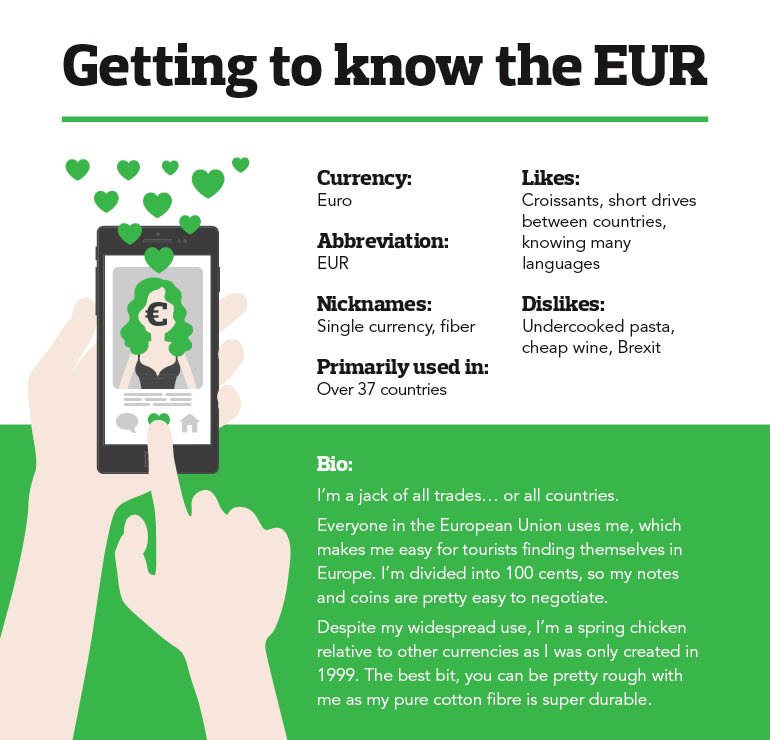
Consider your bookings
It helps knowing exactly what’s included in what you’ve booked. Does your hotel include breakfast in the per night cost? If it does, then that’s one less thing you need to budget for. Or does your accommodation have kitchen facilities? That gives you a cheap’n’easy, DIY meal option.
You can also look for other ways to save. Can you purchase a public transport pass, rather than buying single tickets (as usually, this will offer some savings)? Or can you purchase a sightseeing pass that includes entry costs and public transport? If you can, why not go for it and save.
Final words on budgeting
Well, that was probably a lot to take in, so let’s finish up with some easy-peasy dot points.
- It can help to have a pre-agreed cost for things (pre-agreed with yourself, or your travel companions if you’re splitting costs). This avoids arguments, stress and overspending.
- Put time and research into your ‘per day’ budget and include the things you really want to do. Once you know the costs, you have a goal to save for.
- It pays to book things in advance, but sometimes you might be able to find a cheaper price when you are in the country
- Don’t forget to factor in your pre-travel costs (e.g. travel insurance, immunisations and visas).
- Budget for cheap eats some days so you can gorge other days. From enjoying a glass of champagne at the top of the Eiffel Tower to devouring food at Germany’s food stalls.
- Don’t forget those sneaky costs (e.g. transfers, tours and tipping).
If you still need help with setting a holiday budget, our travel money experts have a handy budgeting tool available in any of our 165 stores across Australia and New Zealand.
*Flight costs based on search from www.flightcentre.com.au and are indicative costs only, based on prices available on 10 August 2018. ^Accommodation costs are based on an average per night price for budget , moderate or luxury hotels, as indicated in the table. ~Cruise cost is based on search from www.ncl.com for a 7 night Western Mediterranean cruise onboard Norwegian Epic, departing Barcelona in May 2019, and is an indicative cost only, based on prices available on 10 August 2018. **Rail Pass cost is based on search from http://www.eurail.com and is an indicative cost only. COST COMPARISON TABLE: All costs are based on estimated approximate costs from major metropolitan cities in each country. “From” costs indicate costs that start from the indicated price and may be higher than shown. Average prices indicate a typical estimated cost you would pay for the indicated item. Prices may vary from time to time, and in different cities and towns within each country. Cities included are: London, United Kingdom; Rome, Italy; Paris, France; Berlin, Germany; Barcelona, Spain; Athens, Greece; Budapest, Hungary; Prague, Czech Republic; Amsterdam, The Netherlands. This blog is provided for information only and does not take into consideration your objectives, financial situation or needs. You should consider whether the information and suggestions contained in any blog entry are appropriate for you, having regard to your own objectives, financial situation and needs. While we take reasonable care in providing the blog, we give no warranties or representations that it is complete or accurate, or is appropriate for you. We are not liable for any loss caused, whether due to negligence or otherwise, arising from use of, or reliance on, the information and/or suggestions contained in this blog.
AUD News: Global growth concerns continue to put a cap on Aussie dollars performance
Travel hacks: halloween hotspots around the world, more like this.


Wondering How Much a Trip to Europe Costs? Find Out What to Expect in 2024
When I first starting taking my family to Europe, I got a lot of side eye from other parents. You could almost see the thought bubble that says, “you must be rich.” There were also a lot of off-hand comments about how they couldn’t afford to go to Europe (from families that frequently dropped a few thousand dollars on trips to Disney.) TL;DR, we aren’t rich, but we do prioritize spending money on travel. The fact is, there are some misconceptions around how much a trip to Europe costs.
There were actually times when we decided to go to Europe because the flight was cheaper than getting to Florida! Of course, when, where, and how you travel can greatly impact your European trip budget. But after visiting 14 European countries, many multiple times, I’ve learned a lot about how much a trip to Europe costs.
Now I won’t lie, it can get REALLY expensive, especially if you are traveling with a family and need two or more rooms (this is why we have used Airbnb ), prefer private tours (worth it with kids!), or if you can only travel during the expensive summer months.
But, I have some tips to help you lower those costs and choose more affordable destinations. I’ll also walk you through average costs for a European vacation , including airfare, accommodations, activities, food, and transportation .

First, if you are interested in a specific country, I have very detailed cost breakdowns for:
- Iceland trip cost
- Ireland trip cost
- Scotland trip cost
- London trip cost
- Amsterdam trip cost
- Paris trip cost
- Portugal trip cost
- Italy trip cost
- Greece trip cost
Ways to Save on Your European Trip Cost
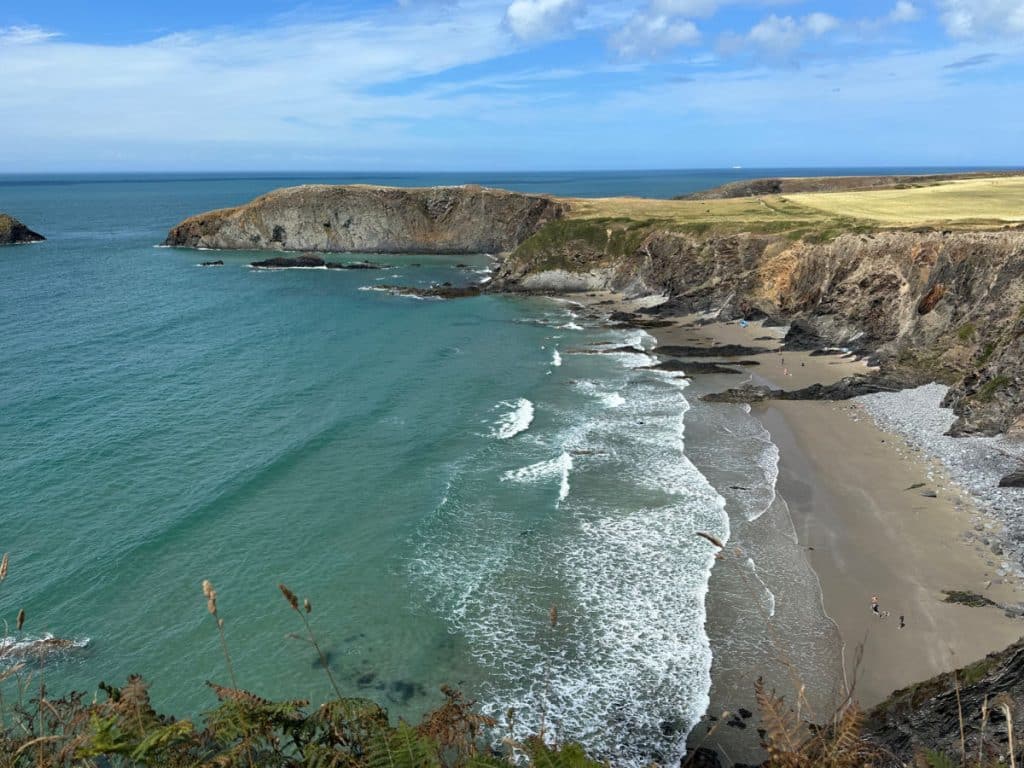
f you are looking for ways to save some money on your trip to Europe cost, here are some ideas;
Visit Less Expensive Countries
If you want to go to Iceland or Scandinavia, you are going to need a healthy budget. Even places that used to be considered budget-friendly, such as Portugal, have gotten pricier in the last few years as tourism has increased (although it is still cheaper than other Western European countries.).
However, if you go the bit off-the-beaten path, you can find great deals, it may just be a bit trickier to find direct flights. Look at destinations like Scotland , Wales , and Eastern European countries like Hungary or Slovenia.
Avoid Big Cities
Everyone wants to visit Paris , London , and Rome , but the less time you spend in these large European capitals, the better it is for your budget. Sevilla is going to be cheaper than Barcelona, and so on.
You can also stay in less-popular countryside destinations, like Piedmont or Umbria instead of Tuscany in Italy or Languedoc instead of Provence in France. We have stayed in gorgeous chateaus in the Languedoc region of France for half the cost of our hotel in Paris.
Stay in Rentals
If you are visiting Europe with kids , one way to save money is to find an apartment or villa rental through Airbnb, vrbo, or other vacation rental alternatives . Since it is hard to find family rooms in Europe that sleep four or more, often the cost of a two or three-bedroom apartment is cheaper than renting two hotel rooms or an expensive hotel suite.
Even couples will benefit from staying in agriturismos, which are farms that offer accommodations on-site in Italy, or something similar.
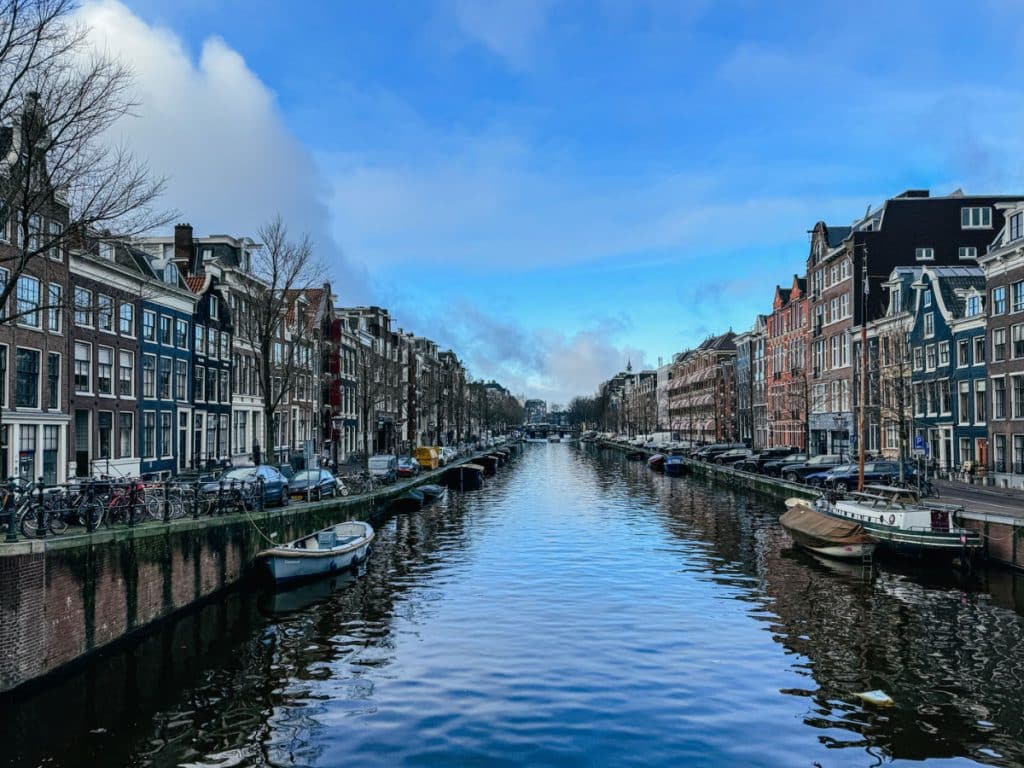
Travel Outside of Peak Season
I know it is hard to travel during shoulder season or low season if you have kids, but remember that Europe has different holidays and school schedules. You can find great deals around our U.S. Thanksgiving. And, if your kids get out of school early, you can still find better deals and availability in June than July or August, when European schools have summer break.
If you have more flexibility, traveling in late October through May (outside of holiday weeks) will save you some money. Just do some research about half-term or school break weeks.
Use Points and Miles or Low-Cost Carriers
There are a lot of ways to hack your way to free flights to Europe using sign up bonuses and flexible points transfers if you can easily meet the minimum spend amounts with your current spending. However, even if that isn’t an option, you can often find great deals on flights to Europe.
We have flown to London and Vienna for under $500 each. I highly recommend signing up for a flight deal subscription service such as Going . With the premium level you can set up your preferred airports and dream destinations and receive alerts on airfare sales and even points deals.
There are also a number of low cost carriers that offer flights from the United States including Norse Atlantic Airways, Condor, and French Bee. You can also use Play Airlines, which connects through Iceland.
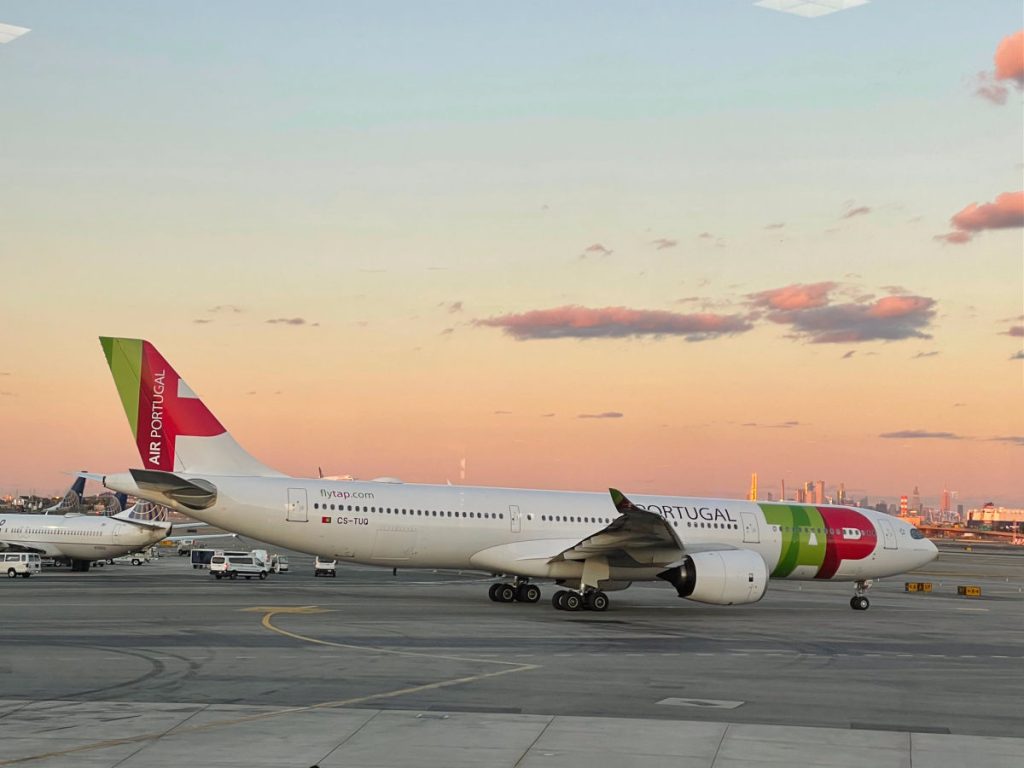
Fly to a Hub and Then Use a Low Cost Carrier
If you find a great flight deal to a major European city, you can then use a low-cost carrier such as Ryan Air, EasyJet, Vueling, or others to connect to your final destination. These flights are typically under $100 per person, but make sure you are aware of the luggage restrictions on weight and size, which are different from U.S. carriers.
Trains are also another option, but don’t assume they will be cheap, especially if you book first class with assigned seats and luggage storage. Be sure to research your options before you book.
How Much Does a Trip to Europe Cost
Note: This post contains affiliate links. If you click a link and make a purchase, I may receive a small commission at no cost to you.
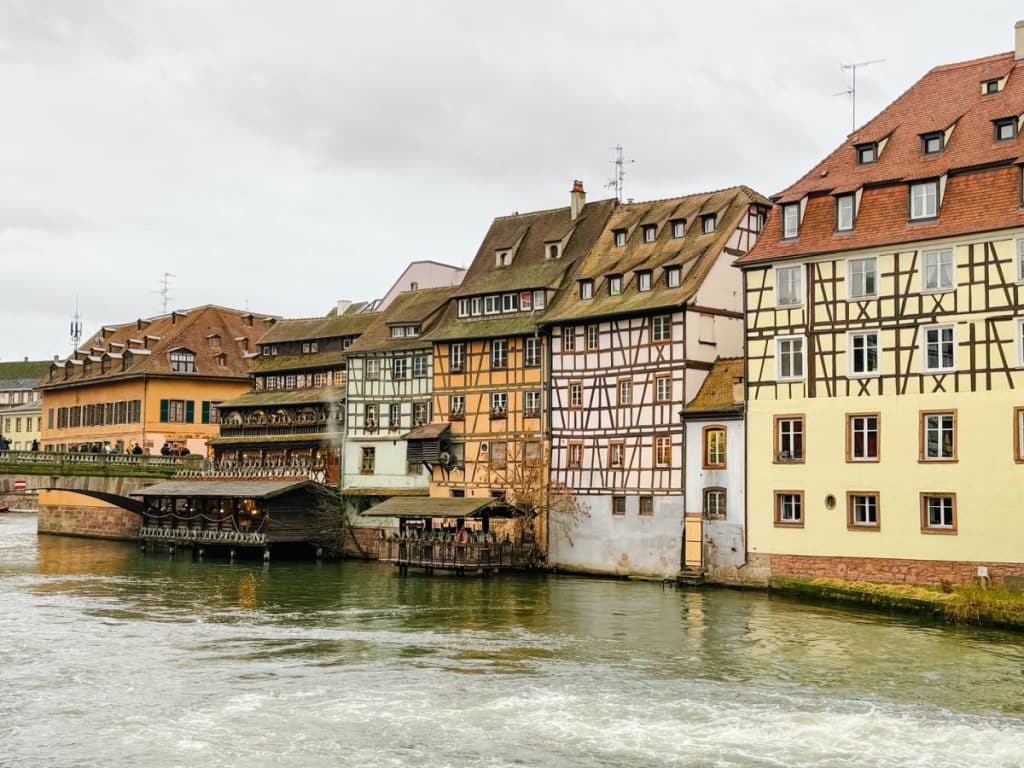
Now let’s look at some average costs for a trip to Europe. I’ve based these on two people traveling to Europe from the United States for a one week (7 night) trip.
Airfare to Europe Cost
Airfare from the United States to Europe can range from $500 per person (if you find a great deal) to over $2,000 (if you book late and travel during high season on a standard carrier.) As I mentioned above, you can save money by looking for flight deals, traveling off-season, or using low-cost carriers or connecting flights.
However, you can assume an average cost of $1,000 per person.
Total Airfare Cost = $2,000 ($1,000 x 2 people)
European Accommodations Cost
Accommodation costs can vary greatly depending on if you are staying in a big city or elsewhere, or if you are in a luxury hotel or a rustic rental. You will usually want to split your trip between a city and somewhere in the countryside. If you only have a week, I’d suggest three nights in the city and four nights elsewhere. Think Rome or Florence + Tuscany, Milan + Piedmont, Paris + Burgundy, Edinburgh + Highlands, London + Wales, etc.
In the city, expect to spend $250-500 per night and $150-350 per night in another location. Remember, you can refer to each of my detailed cost breakdowns for specific hotel and itinerary recommendations for those various destinations.
Total Accommodations Cost = $2,050 ($350 x 3 nights + $250 x 4 nights)
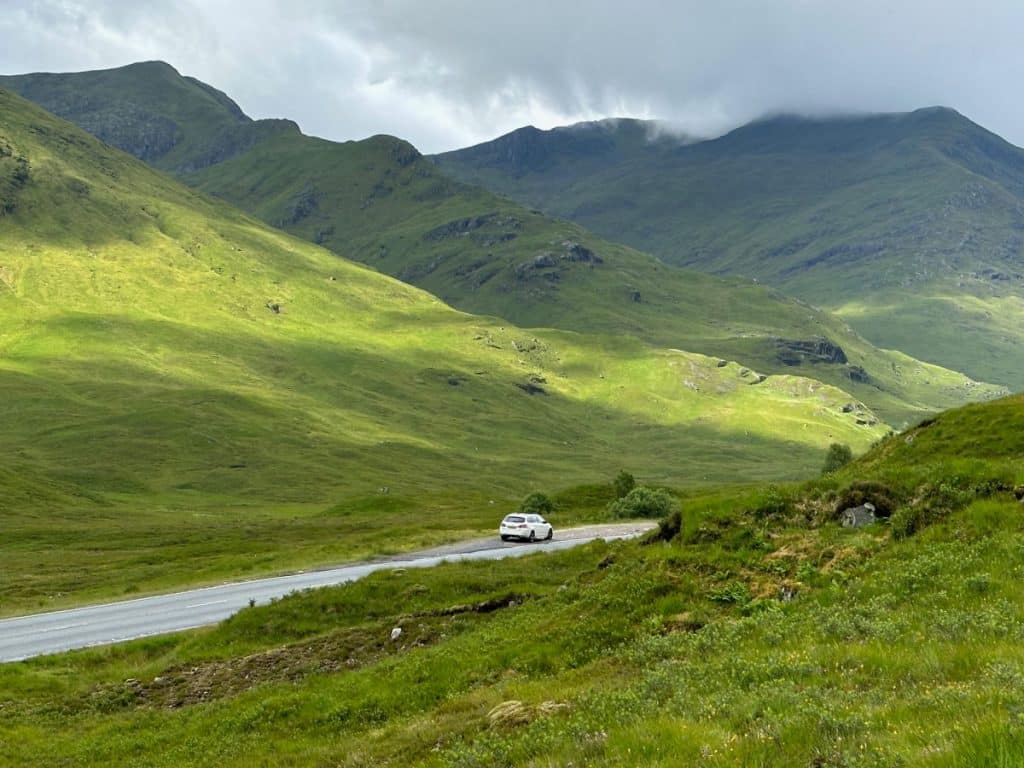
European Transportation Cost
Even if you plan to stay in one city for your entire trip to Europe, you will still need to spend some money on transportation. For example, when we went to Amsterdam for three days, we walked all over the city but we still took a transfer to and from the airport. So whether it is Uber, taxis, public transportation, or private transfers, you will need to budget for transportation expenses.
More likely, you will need to also either rent a car or take a train between destinations. If you are renting a car, be sure to book it early as the prices go up the closer you get to your arrival. Automatic transmission cars are also more expensive than manual transmission. Try to pack in carry on suitcases if possible so that you can rent a small to mid-size car. Driving in some countries (especially Ireland, the UK, and parts of Italy) can be challenging on small roads so you will appreciate it for more than the price point! Also keep in mind that gas is more expensive in Europe than the United States.
Total transportation cost = $800 (estimated)
European Activities Cost
Your activity costs vary greatly depending on where you go in Europe. For example, if you are visiting Scotland or Wales and you just want to spend a lot of time in the outdoors and maybe visit a few castles, your expenses will be minimal. But if you are going to Paris or Rome and you want to explore historic sites and museums and get the most of the experience, you will want to take a tour.
When in Greece, you can spend your days by the pool or the beach, but you will probably want to at least take a sunset sail and maybe a food or wine tour. I know it can get expensive, but don’t skimp on your activities. This is what you will remember most about your trip. More than your hotel. More than your airplane ride. It is also what matters the most when visiting a foreign country. After all, you want to experience the local culture. You want to learn more about the destination’s history. And you will want to see what makes a place unique.
Total Activities Cost = $1000

European Food Costs
It used to be that food in Europe was more expensive than in the United States but in the last couple of years, I have not found that to be the case. You can still spend a bundle on food if you elect for hotel breakfasts or fancy chef’s tasting menus. But in general, you can find affordable meals especially in destinations like Scotland, Wales, Portugal, and Italy.
You can also save money by preparing some of your own meals if you rent an apartment or stay in an aparthotel with a kitchenette. Remember, you don’t need to tip as much in Europe (or sometimes at all) and the alcohol is usually a lot cheaper because it isn’t marked up as much. These factors can make a big difference in your bottom line.
As a rule of thumb, plan to spend:
- $10 per person for breakfast (stop at a bakery for pastry and coffee or juice)
- $15-20 per person for lunch (think pizza, sandwiches, or street food)
- $25-50 per person for dinner (maybe plan for one splurge dinner too of up to $100 pp)
Total Food Cost = $1150
You may also want to budget some money for souvenirs and travel insurance.
Total Trip to Europe Cost
A seven-night trip to Europe for two people will cost an average of $7,900, or $564 per person, per day.
Save this to Pinterest
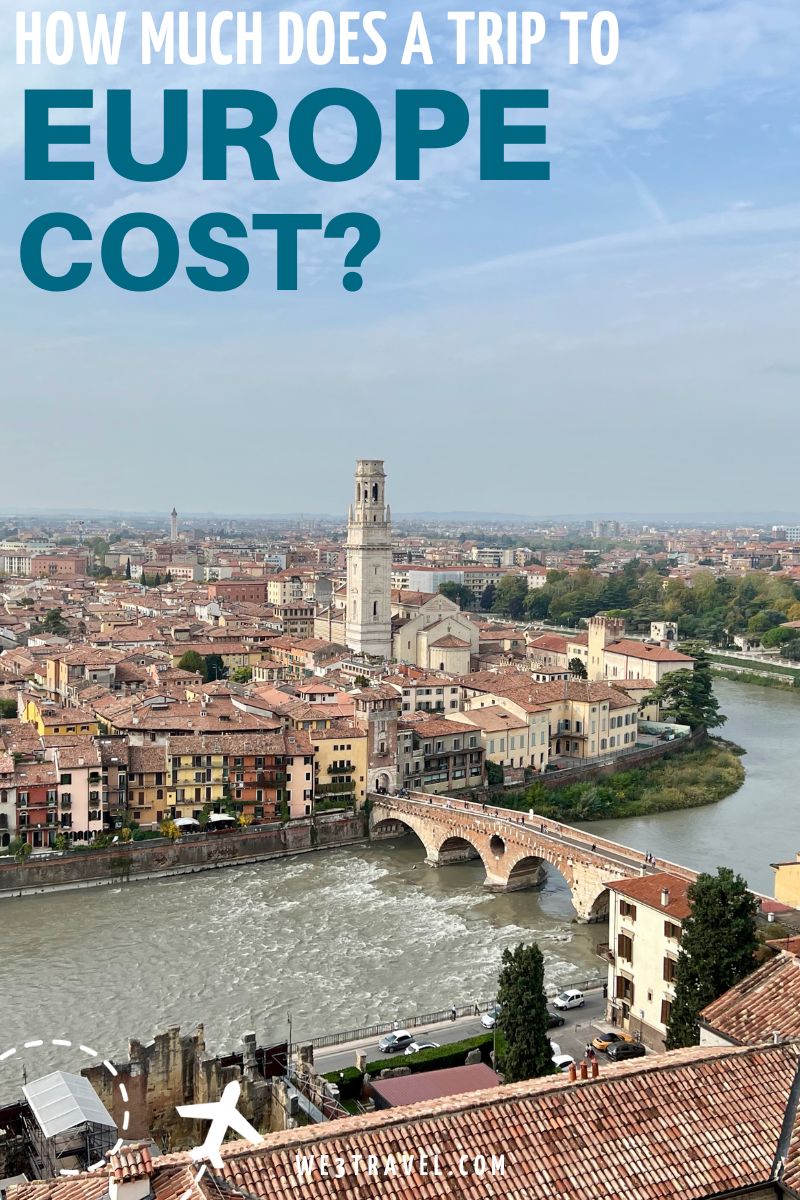
Tamara Gruber is the Founder and Publisher of We3Travel. A former marketing executive and travel advisor, Tamara is an award-winning travel writer and recognized expert in family travel. Tamara is a member of SATW and the Adventure Travel Trade Association, and serves on the Board of the Family Travel Association. She is also the publisher of YourTimetoFly.com and the co-host of the Vacation Mavens travel podcast.
Find this useful? Share it!
Publish Date: March 12, 2024

SIGN UP FOR OUR NEWSLETTER & RECEIVE A FAMILY VACATION PLANNING KIT!
We3Travel.com will use the information you provide on this form to send you newsletters. You can unsubscribe at any time by clicking the link in the footer of any email you receive from us, or by contacting [email protected] . By clicking below, you agree that we may process your information in accordance with these terms.

Start typing and press enter to search

- January 19, 2022
Budget for a trip to Europe: How much do i need?

Table of Contents
That Europe is one of the most sought after destinations for tourism travel everyone already knows, we even have a list of 5 most visited countries in Europe and their incredible sights that certainly corroborates this conclusion! However, planning this trip can be a difficult task, since there are so many things to think, research and organize that can leave you lost, even more with the high costs that are a big problem for your plans, right? That’s exactly why we are here! We can help you with the basics or, if you prefer, you can start by taking a look at how to plan a trip to Europe during the pandemic and then come back here to create your budget for a trip .
So, have you gone and come back? Or did you prefer to stick around here? Well, roll your mouse over and find out all you need to know about how to make a cheap trip to Europe !
ON THE POINT: Writing down expenses
To plan a trip you should go through a basic itinerary of where you want to go, how many days you intend to stay, which places to visit and make reservations . This will all be part of your budget. As we are here to help you we recommend that you take into account two very important things: the external conditions and the standard expenses .
External conditions
When we talk about external conditions, we talk about a tip that can change everything! This is because each one of them greatly influences your pocket when it comes to buying and booking. They are:
- The country : some countries are cheaper than others and the difference can be quite significant, as you can check in Little Money: 3 countries to visit in Europe with little money ,
- The period : times with less tourist movement is called low season, and this term, like its name, is synonymous with low prices, ranging from tickets to accommodation and attractions.
- The European currency quote : the value of each currency is constantly changing and it is important to be aware of its current value to catch its best times.
Standard spending
The standard expenses are the essential costs of the trip – or at least the basics of a complete and still economical trip – that you should write down considering the above conditions and the time you intend to stay abroad:
- Return air tickets;
- Travel insurance;
- Accommodation;
- Tourist attractions.
Now that your expenses are organised, open your browser, take out your pencil, paper and calculator and get to work!
WHAT TO DO TO SAVE MONEY?

Before starting the calculations, it is best to follow a few steps thinking about the external conditions of your trip, so you will have an overview of the expenses, besides finding the cheapest prices for when you calculate the rest of your budget for a trip.
Step one: plan everything in advance!
- When it comes to planning, even more so when you want low prices, you have to be willing to be flexible with dates and times , plus the earlier you book the better it is!
- So the first step for your planning and subsequently your budget is to choose dates well ahead, such as booking tickets 2 to 6 months in advance .
Step two: look for a cheap city!
- The cities located in Eastern Europe are a bargain! With a list that includes Budapest , Krakow , Istanbul , Prague and Sofia and prices of up to 40 euros per day .
- Others between Greece, Italy, Spain and Portugal have a cheap average spend, between 50 and 60 euros per day .
- And there are still some very popular tourist destinations such as Berlin , in Germany, London , in England, Paris, in France, and Rome , in Italy, as well as Amsterdam , Barcelona , Brussels and Lisbon , with average prices ranging from 60 to 70 euros per day .
Step three : choose the best time!
- The period of your trip matters a lot, after all you can catch the low season at the right times, besides, of course, less suffocating with queues and crowds.
- In most places it occurs in the winter period as seen in some countries mentioned in 5 incredible places to visit in the European winter , starting in late autumn . From November to March are the months with the lowest prices .
- Spring is also a good time. In general, the landscapes in the season of dry leaves and flowers in bloom are beautiful and unite natural beauty with good prices.
Step four: keep an eye on the European currency!
- The value of the European currency changes constantly and even small amounts make a big difference when it comes to paying.
- Many hostels and locations only accept European currency.
- Therefore, you have 2 options: one is to convert it when calculating the expenses, always keeping in mind a margin of error; and the second and more practical option is to exchange the currency of your country for the Euro, so you reduce the difficulties of your trip.
- As the currency can overvalue or depreciate depending on the weather, it is good to exchange in advance.
- Also bear in mind that although the Euro is the official European currency, some regions make use of other currencies such as England with the Pound Sterling and the Swedish Krona and Czech Koruna , respectively of Sweden and the Czech Republic.
Step five: search for reliable sources and websites!
- Once you find it, you can search and book (in advance) your tickets and accommodation.
Lean more at How Much Does it Cost to go to Europe?
PRE-TRIP EXPENSES
After following the recommended steps, start to really calculate each of the standard expenses, starting with those that must be done in advance, because then it is less of a worry and it is enough to save for when the day of the trip comes.
As the item that should be purchased the furthest in advance, tickets should be your priority, and remember:
- As the goal is cheap tickets, we will follow the previous tips aiming at the low season period;
Flights booked in December with a date in March of the following year, that is 3 months, 4 days of stay in the city, being the time that interchanges the outward and return trip, and for 1 adult in economy travel, stay around
- Flight with (1) connection NY – Lisbon: from 181,22 euros;
- Direct flight NY – London: from €257.73;
- Direct flight NY – Paris: from 250.83 euros
- Direct flight NY – Rome: from 316.04 euros
* These cities were just some examples, the values may change depending on the place of embarkation and disembarkation.
Ps: don’t forget to look for flexible airlines! So, if necessary you can change the date of your trip without problems or having to pay extra for it.
Travel insurance
I’ m sure you’re already tired of hearing about travel insurance when it comes to Europe, right? But that just goes to show how essential it is. And if you’re lost about it, we recommend you check out how to travel safely to Europe during the pandemic in 2023 to learn how important it is. But to put you in context, this obligation is a guarantee that, in case you have an accident or something similar happens, you will be able to pay for the medical-hospital expenses.
So what do you need to know about them for your budget for a trip?
- Which countries require travel insurance . Not all of them, but many countries do, including the member countries of the Schengen Treaty (if you haven’t seen the first article mentioned, take the opportunity to check it out now, there is a list of all of them);
- What insurance covers . Of the main services offered from travel insurance, medical-hospital and pharmaceutical costs are top of the list, however insurance still covers other issues such as:
- Flight cancellation due to medical emergency or otherwise;
- Tracking and compensation in case of lost luggage;
- Compensation for disability or accidental death, as well as funeral assistance;
- Legal costs and bail bonds;
- The best plan for you . Depending on the length of your trip or what collateral you find most essential, you can choose an insurance plan that covers what you want, for the most affordable price. You can do this using simulators.
- The price of insurance is from 2,35 euros per day;
- From 13,80 euros per day without luggage insurance;
- And a more complete plan around 20 euros per day.
Ah, keep an eye on the European Travel Visa! Soon the Schengen Visa Waiver will come into effect, which will have a fee for the service, but its cost-benefit is also great, as it will be valid for 3 years. You can see more in United States and Europe: will you need a visa in 2023 ?
Accommodation
As well as the time of year, the country and the location of the accommodation you choose will also influence the price of the accommodation you choose, whether it is a simpler or more elegant hostel, budget hotels or flats for rent, always keeping the focus on the low price.
Best hostel options
- Lisbon (daily rate – 1 person): from 12,49 to 78,47 euros;
- London (daily rate – 1 person): from 12.24 to 70.39 euros;
- Paris (daily rate – 1 person): from 21,81 to 39,08 euros;
- Rome (daily rate – 1 person): from 12.56 to 53.52 euros.
Best options for flats
- Lisbon (daily rate – 1 person): around 53.83 to 152.86 euros;
- London (daily rate – 1 person): from around 47.87 to 166.67;
- Paris (daily rate – 1 person): from 45.36 to 137.64 euros;
- Rome (daily rate 1 person): from about 55,40 to 180,80 euros;
Best hotel options
- Lisbon (daily rate – 1 person): from 12 euros;
- London (daily rate – 1 person): from 18,05 euros;
- Paris (daily rate – 1 person): from 24.48 euros;
- Rome (daily rate – 1 person): from 33,27 euros.
Expenses during the trip
Now that you have seen the expenses before the trip, you need to know how much you will spend during the trip, which on average is around 50 euros per day for one person. Let’s break this down?
Sightseeing and tourist attractions
When talking about saving money, you have to be aware that it requires a lot of searching. Attractions are no different. They can vary a lot, from attractions that cost nothing or have very low prices , as is the case of Serra da Estrela, in the Portuguese winter period, or can be quite high, depending on its fame and how much is demanded.
However, on average the cat cost with attractions is 20 euros per day for a person, enough to visit the main sights. Even because, with the incredible landscapes
that there are, walking a little bit through the streets enjoying the view, is one of the best experiences and doesn’t cost anything! Of course you don’t have to miss out on an attraction you like because of the price, just make sure you control how many you go to so you don’t lose your hand on the budget and a lot of money in your pocket.
Transport when travelling is essential, especially if you don’t want to get lost in unknown lands. And it is even possible to go from city to city only with train rides , so it is a very interesting expense, don’t you agree? But you have to think well about the cost-benefit before spending. So, decide if you want to stay in one city only or travel between several.
- If you choose to stay in only one city, bus or train rides are very cheap, ranging from 1 to 3 euros . You can also buy 24 to 72 hour passes.
- From Lisbon to Madrid: 16 euros;
- From Madrid to Rome: 26 euros;
- From Rome to Paris: 23 euros;
- From Paris to London: 38 euros.
If you are interested, read more about how to travel by train in Europe: the best itineraries!
The cost of food to be cheap just depends on you! There are many famous restaurants in Europe, but the price can be discouraging. However, you can still choose a good option, get to know the cuisine and culture you want without having to spend too much!
- The first tip is: book hotels or hostels with breakfast included ! Even if it doesn’t, opt for the cheapest, so you can spend between 3 and 5 euros .
- The same tip goes for lunch; if possible, eat at the hotel . Or just leave lunch as your “out of town” meal. A simple meal will cost you around 12,56 euros .
- For dinner, you can eat at the hotel, which is much cheaper, or you can try the fast food at those times, which are always cheaper, and can be as low as 5 euros !
- Another cheap option is the “ Tourist Menu “, going for 9 euros .
- And then there are the markets, with excellent prices and a great alternative for buying meals.
- On average, opting for good quality and still economical, your meal will be around 20 to 25 euros per day.
SUMING IT ALL UP: How much does a cheap trip to Europe cost altogether?
After writing down all the expenses before and after the trip, choosing the best periods and following the tips for an economical trip, and taking the average of tickets and hotel accommodation for 4 days, the expense that a person would have to visit Europe for four days is 500 euros . Very economical, isn’t it? With this you can even spend a little more, since it is impossible to do a tour like this and not buy anything or take souvenirs home – which by the way are an expense of about 30 euros a day! And now, do you know everything to plan a budget for a trip and start your journey?
If not, we have a complete budget for a trip: Holidays in Portugal: how much money do I need?
If so, how about doing some more extensive planning and a 10-day trip to Europe?
Want to keep up with our blog?
Get our most valuable tips right inside your inbox, once per month!
- budget for a trip , Europe , travel cheap , travel cheaply , Travel in 2022
Related Posts

Madeira Expedition: Sunrise at Pico Ruivo and Camping in Encumeada
I woke up early, around 6:30 am, my goal there was to capture the best

Madeira Expedition: Lunch at Pico do Areeiro and camp on Pico Ruivo
I woke up there in Pico Alto, it was cold, it was 8 am, I

Madeira Camping Expedition: Funchal to Pico Alto
This is the article number 1 of this series I left work on a Friday

Exploring Lauterbrunnen: A Day in the Swiss Paradise
This was a special Saturday. It was a cloudy morning, rainy weather in Switzerland, and

Swiss Hiking Adventure: Lucerne to Mount Pilatus
That day I had arranged with my cousin to go to a lake near Estavayer-le-lac.

Venice to Lucerne: Exploring Swiss Beauty and Italian Flair
We got up early in Venice to catch the flixbus to Milan. We went from
LATEST ARTICLES
© all rights reserved. 2021.


Europe in 3 Weeks: 6 Itineraries
DISCLAIMER: This post might have links to travel services and products that we enjoy. We might make a commission from it at no extra cost to you.
I am confident many people have Europe on their bucket list of places to visit. This continent is filled with preserved historical sites, famous landmarks, UNESCO-certified heritage sites, various natural scenery, and diverse cultures from people of different nationalities.
There are tons of activities that you can do here as well. However, if you plan to stay a little longer than the usual vacation duration, it might cost you a lot, especially if you aren’t familiar with places to go without spending too much.
This guide is for people planning to travel around Europe in 3 weeks . Whether you are on a budget or looking to splurge a little, there’s something for everyone. In this guide, I am covering central and southern Europe – both have famous destinations. I also have itineraries for the eastern region for affordable, nordic areas for unique culture, and off-the-beaten path of Europe.
I want to ensure you spend the 3-week holiday that suits you. If you are new to travelling on a budget, check out these tips for budget travel . You can also read in below our estimate of how much a 3-week in Europe trip might cost.
THINGS TO KNOW BEFORE GOING TO EUROPE
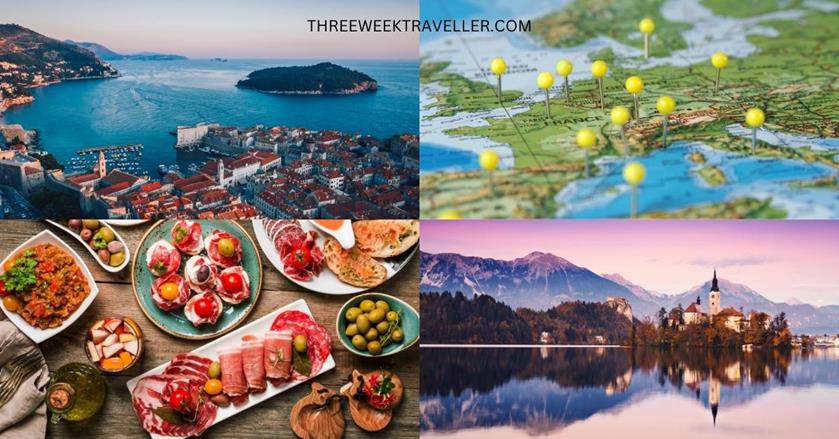
If you plan a trip for 3 weeks in Europe, stay with me as I lay down tips on travelling there on a budget. Decide where you want to go, when, how much you will spend, and what you plan to do once you go there.
I created a detailed outline to help you plan your 3-week Europe trip or you can also consider a 3-week cruise around Europe.
Where to go in Europe for 3 weeks
If you want a hassle-free trip, y ou could visit countries that share land borders or are near each other. You can also limit your visit to 3 countries to spend at least a week in each.
For example, France, Italy, and Spain are super popular and are easy to get from one to another. The same goes for Norway, Denmark, and Sweden. The Baltics (Lithuania, Latvia, and Estonia) is another example of Hungary, Croatia, and Greece/
That way, you could experience what each country offers without rushing. You wouldn’t be overwhelmed by the new cultural experiences and frequent environmental changes. You should check our compilation of 3-week travel itineraries for different (each) European countries .
When to go to Europe
This actually depends on what activities you want to do. For instance, summer would be perfect if you like swimming , various water activities, open-air concerts, and museums. If you’re going to try skiing, ice skating, sledging and see frozen waterfalls and snow in general, you should go during winter.
You can go hiking in spring and discover diverse flora and fauna along the way, as most flowers bloom during springtime. Europe also has various music and cooking festivals, while during fall, you can attend their world-famous festivals, enjoy the changing of the tree colours, and do lots of hiking and museum visits.
However, if you ask me, I like visiting Europe during late spring or late autumn, from March to April or September to October. These are shoulder seasons; the weather is neither too hot nor too cold, there are fewer tourists, and accommodation prices are a bit lower.
Check our list of best destinations to go for a beach trip and t op places to spend winter for 3 weeks .
You don’t have to write your itinerary from start to finish, day by day, but writing some sort of guideline will help you visualise your trip. You can check which destinations you can afford to book a private room and which places you have to book dorm rooms.
Y ou can join free walking tours in Europe, which are widespread . The great thing about this is that you only need to give a tip to the tour guide according to your satisfaction. You can also take local transportation such as trains, buses, or subways (they call them metro in Europe).
You can also check if you can rent bicycles. This means of transportation is enjoyable, and you would be able to appreciate the places you visit more when riding a bike.
Another way to save money when taking public transportation is by booking a shared ride (either from your hotel to the airport or the following city/country).
Pack lightweight
There are so many cheap flights across Europe, but the catch is that the baggage cost on flights often doubles the ticket costs.
That’s why you need only to bring the essentials and pack light. In this way, you also could move faster because you don’t need to rearranging your belongings or drag a heavy suitcase or backpack.
We have an amazing packing list for general travel , which comes with a free printable checklist. You can also check our packing list for summer or the packing list for winter .
Basic travel tools and sites
When planning your trip, check different sites for the most affordable and budget-friendly travel services, such as flights, accommodations, and even travel insurance. If your trip is not final, look for sites that offer flexible cancellations if anything changes.
For those sure of their trip, booking your hotels and flights in advance is best to have more options, especially affordable ones.
These are the websites and tools I personally use when booking my trip. The ones I book right away are flights (for international/intercontinental), hotels (to find the best deals), and car rentals.
3 WEEKS IN EUROPE AVERAGE COST
On average, one person should plan around $2,000 for 20 days in Europe . You should be able to stay in a private room and eat out most of the time. But that still depends on where you plan to go.
If you’re on a backpacker’s budget, you should be able to do it for $1,500 . Plan to stay in dorm rooms and cook when you can.
If you want to splurge, $4,500 for 3 weeks in Europe is very comfortable. You can book five-star hotels, eat at fancier restaurants, and book private tours.
Pro tip: Don’t include your airfare when computing your budget because airfares change drastically . You can also try to book during non-peak seasons to save more or wait for promos.
When computing how much a 3-week Europe trip costs, you should consider food, accommodation, and tours. Last-minute bookings are the most expensive. Hence if possible, book as early as three months before your planned trip.
How much is it really to travel to Europe for 3 weeks? It depends on the person, of course. However, personally, I spent about $1,200 on one summer. I also visited during winter, where I paid $1,000 in 3 weeks, mostly because I decided to head to East Europe . I also backpacked around for three months and spent about $2000.
In my opinion, Europe is not that expensive compared to North America or even Oceania. But it would help if you had a good plan and were okay with not always eating in fancy places. The great thing about Europe is the hostel community, it’s affordable and a great way to socialise.
I mainly stayed in hostels around Europe, took public transportation, walked a lot, ate street food and went to local grocery stores. I also made sure to see as many places as possible and enjoy some “luxury” here and there.
You can also book this 7-day tour of central Europe , which covers Germany, Czechia, Slovakia, Hungary, Austria, and Switzerland. Transportation, accommodation, tour manager, and breakfast are all included.
PINNED MAP OF DIFFERENT ITINERARIES
Click the enlarge button on the top right corner. Credit: map data: Google
EUROPE IN 3 WEEKS ITINERARIES
I created a list of various destinations according to season and budget preference. I included itemised lists of how much a 3-week Europe trip costs so you could know what you could do with specific budget ranges. Please note that this budget is for one person only, and you can adjust the cost according to the number of people.
>> We also have an article on affordable destinations to spend your 3-week vacation
Most Affordable Winter Destination – Portugal, Spain, Italy
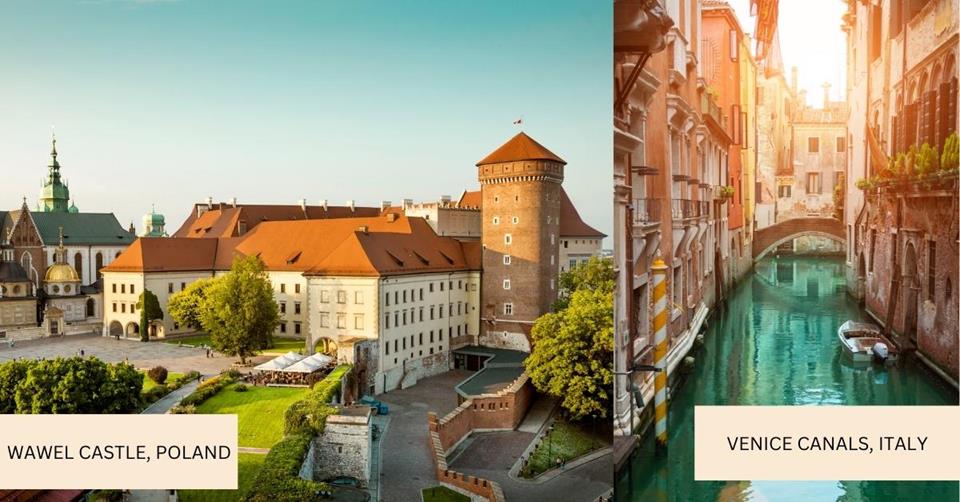
If you want to visit Europe during winter, consider visiting Portugal, Spain and Italy. These three are close to each other. They also have affordable accommodations and generally have fewer tourists during this season.
In Italy, you can enjoy the Colosseum without crowds , explore the mountains, and spend time in museums. You will also have the luxury of spending the entire 3 weeks in Italy , covering north to south. From mountains, vineyards, and historical places, to Mediterranean beaches. If you are foody, you definitely have to try these best Italian desserts .
On the other hand, Portugal doesn’t suffer from freezing temperatures even in the middle of the winter season, so you can still enjoy the sunlight and do various outdoor activities such as hiking. There are popular Instagrammable spots in Portugal that are worth a visit, and of course, wine and food.
You want to see Porto and Lisbon, especially if you want to hike the popular Santiago de Compostela route. Once you get to Porto, stay near a bus or metro stop, both budget-friendly ways to move around. If you don’t know where to stay in Porto, near the historic centre of Ribeira District, both offer affordable options.
Don’t forget Lagos; it offers such wonderful water activities. This is an incredible destination if you plan to visit during summer. Lagos is located in the Algarve region, a popular area for its coastal features. If the water is too cold during winter in the Algarve, there are other things you can do, such as hiking, visiting chapels, enjoy a road trip.
If you are heading to the capital, decide on the activities, from museums, beaches, hiking, and even night-out parties. Knowing what to pack for Lisbon will ensure you don’t waste your time and money. Check our itinerary for 3 weeks in Portugal .
Lastly, Spain holds some of the best festivals on the continent during this season . During winter, the best places to visit in Spain are Seville, Barcelona, Madrid, Granada, the Canary Islands, and Costa del Sol.
There are so many places to see in Madrid, and probably a good 5 days here is the perfect spot. At the same time, Barcelona for 2 days will allow you to cover too many attractions.
But please, do not miss the Canary Islands – like no other in Europe. We have 3 weeks in Spain. Below are the budget ranges you should allocate for food, guided tours and accommodation. You can also check out our 3 weeks in France, Italy, and Spain itinerary .
- food budget per day: $20
- guided tours cost per day: $15-$30
- accommodation cost per day: $25-$45 as a backpacker or $70+ for mid-range
- 3-week budget: $1,200-$1,800 (excluding flights to and back)
Mid-range – UK, France, Germany
If you want to spend more, visit the UK, France and Germany. These countries are rich in history and are close to each other, so much so that you can take trains to cross borders. They also have great wine and beers, so this option is perfect for wine and beer enthusiasts.
Check out our 3 weeks in Central Europe itinerary, which features Germany, Poland, Czechia, Switzerland, Austria, Slovakia, and Hungary. But if you prefer the West, we also have an itinerary for 3 weeks in Western Europe or a sole 3 weeks in Germany post.
If this is the region you want to visit, it’s best to come during the off-season, which is either from March to May or September to November. The prices are lower, and there are fewer crowds.
If you visit the UK, you can finally see Big Ben in London and London Bridge . You can spend your holiday in England, which hosts festive Christmas markets and drink hot chocolate while wandering about or seeing the world-famous Isle of Skye in Scotland.
There are many ways to explore the UK. We have a guide for 3 weeks in England only, or you can also explore the entire country and do 3 weeks in the UK .
However, if you have been to the UK before, you probably want to visit Ireland this tim e. You can combine Scotland, Northern Ireland, and Ireland. Please look at our 3 weeks in the UK and Ireland itinerary .
In France, you can take a picture of the Eiffel Tower or visit the Louvre if you’re a museum enthusiast. You can also try out their seasonal cuisines and go on a shopping spree as they have a government-mandated citywide sale during this season, also known as “soldes”. And yes, we have an itinerary for 3 weeks in France .
In Germany, you can go to thermal bathhouses to experience their outdoor pools and saunas . You can also ride their historic cable car, Merkurbergbahn, to see the snow-covered pine trees. Here are the daily price ranges for food, accommodation and tours.
- food budget per day: $25-$35
- guided tours cost per day: $30-$50
- accommodation cost per day: $35-$50 for backpackers or $80+ for mid-range
- 3-week budget: $1,900-$2,800 (excluding flights to and back)
Affordable Summer Destination – Italy, Croatia, Greece
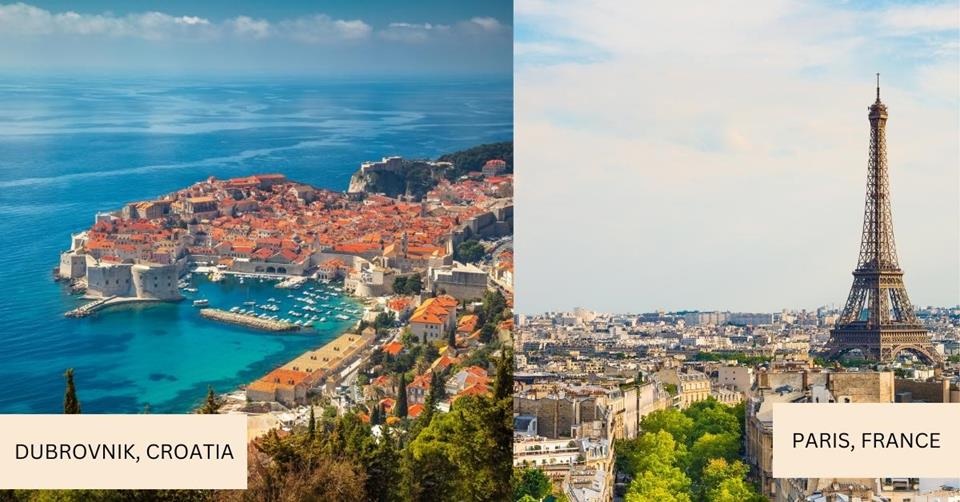
For affordable summer destinations, Italy, Croatia, and Greece are must-visits. They are not necessarily next to each other or affordable. Italy is expensive, but Greece and Croatia are a bit more affordable so that balances it out.
Another thing is that flights between these three countries are affordable. Plus, it’s in Southern Europe ; there’s no better place for a beach vacation in this region.
These 3 destinations serve great food, wine, and beer and are rich in natural scenic spots like beaches and mountains. Personally, I would say this is the best way to explore Europe in 3 weeks on a budget.
Italy is known for their fantastic food. You can go on a gondola ride in Venice and have wine tastings in Sorrento, which sounds like a perfect summer getaway. Venice is not really a budget-friendly destination.
But, if you want to make this trip affordable, check out the coastal cities on the southeast side of Italy. Not only are they cheaper for vacation in this expensive country, but they are also less crowded.
Greece is a famous summer spot as well. You can visit Mycenae, an ageless arch made with monumental stones that was once a dwelling place of some of the most famous people in Grecian history, including Agamemnon, Electra, and Orestes. You can also have a road trip with your friends around Pelion or just chill and have a slow day in Hydra.
This country is an excellent choice if you want to experience the Mediterranean Sea but want to do Europe in 3 weeks on a budget. 3 weeks in Greece is a little more affordable than Spain, France, and Italy.
Croatia is now known for its location in Game of Thrones, but it has more to offer. You can go coral diving during the summer season. You can also avail yourself of a boat trip, hike, swim, cycle or sail; honestly, the sky’s the limit with the number of things you could do here.
It’s another more affordable destination but located ion on the Mediterranean Sea. You can check our 3 weeks in Croatia itinerary too.
- accommodation cost per day: $25-$35 or $50 and up for mid-range
- 3-week budget: $1,000-$1,800(excluding flights to and back)
Drinks and Beach – France, Poland, Greece
If you are the type of person who wants to lounge along the beach while drinking wine or beer, then this triad is perfect for you . Aside from that, these countries are rich in historical artefacts and landmarks, and flight tickets are cheap.
One of the most famous beaches in France is Plage de la Cote des Basques in Biarritz, which you’ve probably read about in Hemingway’s The Sun Also Rises . Another famous beach is the Deauville beach in Normandy, where Coco Chanel opened her first clothing store and held historical value .
Sopot is one of the most famous beaches in Poland , especially for the locals, because aside from chilling and sipping wine along the bay, you can also take boat rides, and there are spas and saunas nearby.
Swinoujscie Beach is famous for its water sports because of the constant wind and waves. It also has a windmill nearby which is considered its most famous landmark. Greece has the most beautiful beaches in Europe, so you won’t have difficulty looking for a great beach there. Some of the most beautiful beaches are Mykonos, Crete and Santorini.
- accommodation cost per day: $25-$50
- 3-week budget: $1,700-$2,800 (excluding flights to and back)
CHECK-OUT: Best itineraries for 3 weeks in East Europe
A bit of splurge – Iceland, Norway, Denmark
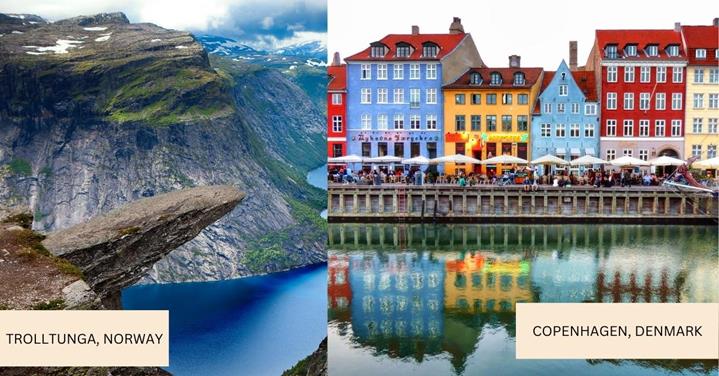
I know Scandinavia or the Nordic region doesn’t scream Europe in 3 weeks on a budget. But if you have a larger budget and want to splurge a little, Iceland, Norway, and Denmark are the perfect places to visit. The best way to make this plan affordable is to rent a car rather than relying on domestic flights, trains, or even buses.
Not super cheap, but it can be affordable if you plan and look for great deals. Remember these tips for visiting Iceland and travelling to Scandinavia for first-time travellers to this region.
You should look at flights and book accommodations 4-6 months in advance . Travelling in the northern hemisphere during the off-season, fall or winter, would be best.
Book hotels in advance to save money and also use local transportation. For instance, if you plan to go during the summer, flights are cheaper if you book them during the winter.
You can enjoy many free or affordable activities like hiking, sightseeing, or road-tripping. You can also enjoy their street foods at a lower price than at their restaurants.
If you are curious, some of the most famous places in Iceland include the Blue Lagoon in Grindavik, a geothermal spa and Strokkur Geysir, where spectacular geysers are found. You can also witness the northern lights if you’re lucky, as the time of their appearance is quite unpredictable.
Meanwhile, in Norway, you can visit the Lofoten Islands or the scenic city of Bergen, which form an archipelago and go to the Lofoten War Memorial Museum. Bygdoy Peninsula is also home to some of Oslo’s top tourist attractions.
In Denmark, you can visit the Tivoli Gardens found in Copenhagen and Nyhavn, the model of most postcards and can also be found in Copenhagen. Here, you will also see the statue of the Little Mermaid, yep, that story was written by the Danish writer, Hans Christian Andersen.
Do you know that you can spend 3 weeks in Scandinavia and cover Norway, Denmark, and Sweden on the same trip? We also have 3 weeks in Iceland itinerary if that’s something you have in mind and a Norway itinerary .
- food budget per day: $30-$50
- guided tours cost per day: $50-$70
- accommodation cost per day: $45-$60 for backpackers or $100+ for mid-range
- 3-week budget: $2,400-$3,500 (excluding flights to and back)
The Baltics – Lithuania, Latvia, Estonia
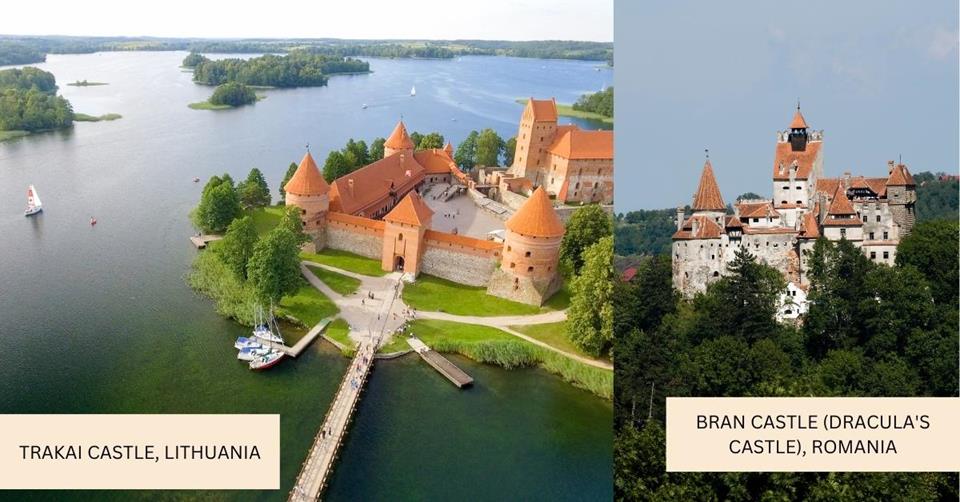
If I’m on a budget, these three countries are my favourite European destinations for Europe in 3 weeks . These places offer a calm and relaxing vibe, from beaches to hiking, to castles, without spending too much.
You can cross the borders via train or bus, saving you money instead of flying. I’m not going to lie. The Baltic beaches are not stunning, but they offer a tranquil scene and few tourists.
I recommend you enter either through Vilnius or Tallinn and make your way north or south. Don’t forget to try cider from this region. It’s one of the best in Europe. Few do this, but road-tripping through the Baltics is the best way to explore this area. It’s more affordable and gives you so much more freedom.
In Lithuania, make sure to visit Vilnius, Kaunas, and Klaipeda. These two cities offer different activities from one another. Vilnius for the cultural and historical experiences and the best nightlife in Lithuania. In comparison, Kaunas is known for its creative and street arts.
Even though it’s a small city, many things to do in Kaunas are related to art. Last but not least, Klaipeda for the beach and other water activities. Make sure to visit Trakai Castle and Uzupis.
From there, make your way to Riga, the coastal capital of Latvia. Enjoy museums, castles, fortresses, and the beach during summer. You can also visit Rezekne, where Raznas National Park is located. Here, you can enjoy hiking, fishing, and even canoeing.
And lastly, Tallinn. A vibrant and modern city, Estonia’s capital and known for being the leading digital powerhouse of the Baltics. Estonia is the pioneer of digital residencies and the first country to welcome digital nomads. Many museums show Estonia’s history and culture. Being on the coast, you can enjoy the beach during warm weather and other water activities.
- food budget per day: $15-$30
- accommodation cost per day: $35-$50 for backpackers and $60+ for mid-range hotels
- 3-week budget: $1,400-$2,300 (excluding flights to and back)
SUMMARY OF EUROPE IN 3 WEEKS
Europe might be expensive in general, but with enough planning and research, you should be able to create a travel plan for Europe without spending too much.
Our own guide to Europe in 3 weeks on a budget, consists of our personal list of places that I visited and perhaps you can visit them as well depending on your budget, season and activity preference.
These budget ranges are for participating in group tours and eating in bazaars, holiday fairs or mobile food carts instead of going to fancy restaurants.
Next summer, I plan to be in Europe for 3 weeks visiting Italy (can never get enough!, Slovenia, and Czechia.
We hope reading this has been enjoyable and informative for you as much as compiling this list has been delightful. We also hope you would consider going to Europe because there are many famous scenic spots and hidden gems just waiting to be visited.
SAVE THIS TRAVEL ITINERARY ON YOUR PINTEREST:
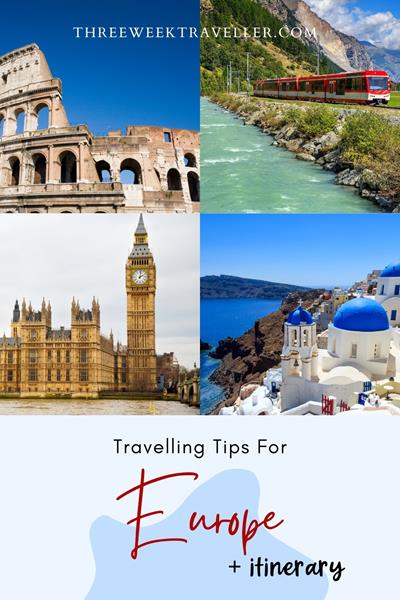
Winter is here! Check out the winter wonderlands at these 5 amazing winter destinations in Montana
- Plan Your Trip
- Budget Travel
How To Budget A Trip To Europe
Published: December 6, 2023
Modified: December 28, 2023
by Rozele Kuo
- Travel Essentials & Accessories
- Travel Guide
- Travel Tips
Introduction
Planning a trip to Europe can be an exciting and fulfilling experience, but it’s crucial to have a well-structured budget in place to ensure a stress-free journey. With proper planning and careful consideration, you can make the most of your limited funds and still have an incredible adventure exploring the diverse landscapes, rich history, and vibrant cultures that Europe has to offer.
In this comprehensive guide, we will take you through the essential steps to effectively budget your trip to Europe. From determining your travel dates to estimating transportation costs, accommodation expenses, meals, sightseeing, and other daily expenses, we’ll cover it all so you can plan your trip with ease and confidence.
Whether you’re a solo traveler, a couple, or a group of friends, these budgeting tips will help you make the most of your resources while giving you the freedom to indulge in wonderful experiences along the way.
Remember, budgeting requires careful consideration and flexibility. As you dive into the planning process, keep an open mind and be prepared to adjust your plans as you discover new opportunities or unforeseen expenses. This article aims to provide you with a solid foundation to start your budgeting journey and help you make the most of your trip to Europe.
So, let’s get started with step one: determining your travel dates.
Step 1: Determine your travel dates
The first step in planning a budget trip to Europe is to determine your travel dates. This will help you set a timeline for your trip and allow you to plan your budget accordingly.
Consider the time of year you want to travel. Europe experiences different seasons, each with its own advantages and drawbacks. The peak tourist season typically falls during the summer months when the weather is warm and the days are long. However, this also means that popular destinations will be crowded, and prices for accommodation and flights will be higher. On the other hand, traveling during the shoulder seasons (spring and fall) can provide pleasant weather, fewer crowds, and more affordable rates.
Once you have a general idea of your preferred travel dates, do some research to find out if there are any major events, holidays, or festivals happening in the destinations you plan to visit. These occasions might affect the availability and prices of accommodations and transportation. If you have specific events or festivals on your bucket list, make sure to factor them into your itinerary and budget.
Another important factor to consider when determining your travel dates is your personal schedule and commitments. Check with your employer, school, or any other relevant parties to ensure that your chosen dates won’t clash with any important obligations.
Lastly, be flexible with your travel dates if possible. Flights and accommodations tend to be more expensive during weekends and holidays. By adjusting your travel dates by a day or two, you may be able to save some money.
Once you have finalized your travel dates, you can move on to the next step: researching destinations and creating an itinerary.
Step 2: Research destinations and create an itinerary
Researching destinations and creating an itinerary is a crucial step in planning your budget trip to Europe. Having a well-planned itinerary will not only help you stay organized but also optimize your time and budget.
Start by making a list of the countries or cities you wish to visit during your trip. Consider factors such as your interests, must-see landmarks, and cultural experiences you want to have. Look for destinations that offer a variety of attractions and activities that align with your preferences.
Once you have your list, conduct in-depth research on each destination. Look for information on popular tourist spots, local customs, transportation options, and budget-friendly attractions. Take note of any entrance fees, transportation costs, and the availability of free or discounted passes like city cards or museum passes.
Consider the geographical proximity of the destinations you plan to visit. Exploring neighboring countries or cities can significantly reduce travel time and costs. Take advantage of Europe’s excellent train and bus networks, which often offer affordable and convenient intercity travel options.
When creating your itinerary, strike a balance between popular tourist destinations and off-the-beaten-path gems. While iconic landmarks are worth visiting, they are often more crowded and expensive. Discovering hidden gems and lesser-known attractions can offer a more authentic and budget-friendly experience.
Be flexible with your itinerary. Allow some open days in your schedule for spontaneity or to include any recommendations you receive from locals or fellow travelers along the way.
Consider the length of your stay in each destination. Allotting sufficient time in each city or country will allow you to explore at a leisurely pace without feeling rushed. Avoid overpacking your itinerary, as this can lead to exhaustion and unnecessary expenses.
Use online travel resources, guidebooks, and travel forums to gather information and gain insights from fellow travelers who have visited the destinations on your list.
By thoroughly researching destinations and creating a well-balanced itinerary, you can make the most of your budget and ensure a memorable trip to Europe.
Step 3: Calculate transportation costs
Transportation costs can significantly impact your budget when planning a trip to Europe. To effectively manage your expenses, it’s important to calculate and budget for transportation costs in advance.
Start by determining the most suitable mode of transportation for your trip. In Europe, you have a variety of options including flights, trains, buses, and even ferries. Each mode has its own advantages and price range, so consider factors such as travel time, convenience, and cost.
If you are traveling long distances between countries or cities, compare flight prices from budget airlines. Be sure to factor in any additional fees for baggage, seat selection, or priority boarding. Keep in mind that flights can be cheaper when booked in advance, and midweek or early morning flights often have lower fares.
Trains are a popular and convenient mode of transportation in Europe, offering scenic routes and easy access to city centers. Research the train networks and compare ticket prices, especially if you plan to travel extensively within a specific country or region. Look for discounted rail passes or regional tickets for additional savings.
Buses are another affordable option, especially for short to medium-distance travel. Many bus companies offer budget-friendly fares, and some even have overnight options that can save you money on accommodation for one night.
If you’re considering visiting multiple countries or regions, look into Eurail passes or intercountry travel deals. These can provide significant savings on transportation costs, especially for frequent travelers.
Once you have identified the modes of transportation that best suit your needs, create a transportation budget by estimating the costs for each leg of your journey. Don’t forget to account for transportation to and from airports or train stations, as well as any local public transportation you may need to use within cities.
Keep in mind that prices can fluctuate depending on the time of year and travel demand. Be flexible with your travel dates if possible, as this can help you secure lower fares.
It’s also a good idea to monitor travel booking websites or sign up for fare alerts to stay informed of any discounts or promotions. Consider using travel apps that compare prices across different modes of transportation to find the best deals.
By carefully calculating and budgeting for transportation costs, you can ensure that you have enough funds allocated to get you from one destination to the next without breaking the bank.
Step 4: Estimate accommodation expenses
When planning a budget trip to Europe, estimating accommodation expenses is a vital step. Accommodation costs can vary significantly depending on the destination, type of accommodation, and the time of year you plan to visit.
Start by determining your preferred type of accommodation. Europe offers a wide range of options, from budget hostels and guesthouses to mid-range hotels and luxurious resorts. Hostels are a popular choice for budget travelers, providing affordable dormitory-style rooms or private rooms at a lower cost. Guesthouses or bed and breakfasts can offer a more local and affordable experience. If you prefer more privacy and comfort, consider budget-friendly hotels or apartments.
Research the average cost of accommodation in your desired destinations. Use online booking platforms and hotel comparison websites to get an idea of the price range for different types of accommodations. Keep in mind that accommodation prices can vary depending on the city, neighborhood, and proximity to tourist attractions.
Consider the location of your accommodation. Staying in the city center or popular tourist areas tends to be more expensive. However, opting for accommodations in the outskirts or in lesser-known neighborhoods can often save you money without sacrificing convenience or safety.
Look for deals, discounts, and promotions. Many hotels and booking platforms offer early-bird discounts, last-minute deals, or discounted rates for longer stays. Additionally, consider using websites or apps that offer alternative accommodations like homestays, guesthouses, or vacation rentals.
Another option to lower accommodation costs is to consider sharing your room or apartment with other travelers. This can be done through websites or apps that connect travelers looking for roommates or complete apartments to rent together.
Be sure to read reviews and ratings of accommodations before booking. Look for honest feedback from previous guests to ensure that you are getting good value for your money.
Factor in additional costs such as taxes, city taxes, resort fees, or any required deposits. Some accommodations may also provide complimentary breakfast or amenities, so consider these perks when comparing prices.
As a budget traveler, don’t be afraid to opt for more affordable accommodations. Remember, you will be spending most of your time exploring the destinations and soaking up the local culture, so a comfortable and budget-friendly place to rest is often sufficient.
By estimating accommodation expenses and allocating a reasonable amount within your budget, you can ensure that you have suitable and affordable lodging throughout your trip to Europe.
Step 5: Plan for meals and daily expenses
Planning for meals and daily expenses is a crucial aspect of budgeting for your trip to Europe. By being mindful of your spending on food and other daily necessities, you can make your budget stretch further, allowing for more memorable experiences.
Start by setting a daily budget for meals. Research the typical cost of meals in your chosen destinations. Keep in mind that eating out at restaurants can be more expensive compared to grabbing a quick bite from local street food stalls or markets. Take advantage of the diverse culinary scene in Europe by sampling affordable yet delicious local dishes.
Consider cooking some of your own meals. If you have access to a kitchenette or are staying in an apartment-style accommodation, grocery shopping and preparing your own meals can save you a significant amount of money. Visit local supermarkets or farmers’ markets to buy fresh ingredients and experience a more authentic taste of the local cuisine.
Stay hydrated with tap water whenever possible. In many European countries, tap water is safe to drink and readily available. Avoid purchasing bottled water to save money and reduce plastic waste. Carry a reusable water bottle that you can refill throughout the day.
Plan for other daily expenses such as public transportation, sightseeing fees, and miscellaneous items like toiletries, souvenirs, and laundry. Research the cost of public transportation passes, such as day passes or weekly cards, as these can often provide better value compared to individual tickets. Look for free or discounted days at museums and attractions, and prioritize visiting budget-friendly or free attractions.
Keep track of your daily expenses and adjust your spending accordingly. Use budgeting apps or keep a journal to record your expenses, making it easier to identify areas where you might be overspending. By being conscious of your financial habits, you can make informed decisions and stay within your budget.
Consider purchasing a local SIM card or a portable Wi-Fi device to stay connected without incurring high roaming charges. This will allow you to access maps, translation apps, and travel information that can help you navigate and make informed choices while on the go.
Lastly, be open to experiencing the local culture without breaking the bank. Take advantage of free activities such as walking tours, exploring public parks, or attending local festivals and events. Engage with locals and fellow travelers for recommendations on hidden gems or budget-friendly activities.
By planning for meals and daily expenses in advance, you can ensure that you have sufficient funds allocated for essential needs while still embracing the local culture and enjoying your trip to Europe within your budget.
Step 6: Budget for sightseeing and activities
As you plan your budget trip to Europe, it’s essential to budget for sightseeing and activities. Europe offers a wealth of cultural, historical, and natural attractions that can enhance your travel experience.
Start by researching the popular landmarks and attractions in your chosen destinations. Look for entrance fees and any additional costs, such as audio guides or guided tours. Check if there are discounted tickets for students, seniors, or specific time slots with lower prices. Take note of any free or low-cost attractions as well.
Prioritize the attractions that interest you the most and allocate a budget for them. Determine the must-see sights and experiences that you don’t want to miss, and set aside a portion of your budget for these activities. Be realistic about what you can afford and create a list of alternative attractions in case some are beyond your budget.
Consider exploring the local culture and history through free or low-cost activities. Visit local markets, parks, and neighborhoods to get a sense of the local lifestyle. Attend free events or festivals that showcase the traditions and customs of the region you’re visiting.
Be open to alternative ways of experiencing attractions. For example, instead of purchasing a ticket to enter a museum, explore the exterior and gardens, or find free guided tours or audio guides online that offer insightful information. Take advantage of walking tours or self-guided tours available for free or at a lower cost.
Seek out local recommendations for hidden gems or off-the-beaten-path attractions that are often less crowded and more budget-friendly.
Utilize city tourist cards or sightseeing passes that offer discounted or bundled admission to multiple attractions. These cards can also include free public transportation, providing additional savings.
Remember to factor in any additional costs such as transportation to and from the attractions, meals, and souvenirs. It’s important to have a clear understanding of the total cost associated with each activity to avoid any surprises.
Lastly, be open to spontaneous discoveries and experiences. Some of the most memorable moments during your trip may come from unexpected encounters and hidden gems that aren’t necessarily part of your initial itinerary.
By budgeting wisely for sightseeing and activities, you can enjoy a fulfilling and enriching travel experience in Europe without stretching your budget too thin.
Step 7: Consider travel insurance and visa fees
When planning your budget trip to Europe, it is important to consider two crucial aspects: travel insurance and visa fees. These are essential components to ensure a smooth and worry-free journey.
Firstly, research and evaluate the importance of travel insurance for your trip. While it may seem like an additional cost, it provides protection and peace of mind in case of unexpected events such as trip cancellations, medical emergencies, or lost belongings. Determine the level of coverage you need, considering factors such as the length of your trip, the activities you plan to engage in, and the value of your belongings. Compare different travel insurance providers to find a policy that fits your needs and budget.
Be aware that some credit cards might offer limited travel insurance coverage. However, it is essential to carefully review the terms of the coverage to ensure it meets your specific requirements. If necessary, consider purchasing additional coverage through a dedicated travel insurance provider.
Secondly, check the visa requirements for the countries you plan to visit in Europe. The visa fees can vary depending on your nationality and the duration of your stay. Research the specific requirements for each country you plan to visit and find out if you need to apply for a visa in advance or if you can obtain one upon arrival.
Calculate the total cost of visa fees for all the countries you plan to visit and include this as part of your budget. It’s crucial to factor in the processing time for visa applications and any additional costs such as passport photos or transportation to the visa application centers.
It’s important to note that some countries in Europe are part of the Schengen Area, which allows for visa-free travel for certain nationalities. However, even if you are visa-exempt, you may still be required to fulfill specific entry requirements, such as having a valid passport and providing proof of sufficient funds for your stay.
By considering travel insurance and visa fees as part of your budget, you can ensure that you are adequately prepared for any unforeseen circumstances and meet the necessary requirements for your travel to Europe.
Step 8: Allocate funds for miscellaneous expenses
When budgeting for your trip to Europe, it’s important to allocate funds for miscellaneous expenses. These expenses are often overlooked but can arise unexpectedly during your travels. By setting aside a portion of your budget for miscellaneous expenses, you can ensure you are prepared for any unforeseen costs that may arise along the way.
Start by considering transportation to and from the airport or train station in your home country. This can include taxi fares, airport shuttles, or public transportation costs. Additionally, be prepared for any transportation-related expenses within Europe, such as local buses, trams, or taxis.
Be mindful of baggage fees charged by airlines if you plan to check in luggage. Some budget airlines have strict baggage weight and size restrictions, and exceeding these limits can result in expensive fees.
Keep some funds aside for emergencies or unexpected situations that may occur during your trip. This can include medical expenses not covered by travel insurance, unforeseen transportation changes, or last-minute accommodation needs. It’s better to have some extra money set aside as a safety net, just in case.
Factor in costs for communication, such as purchasing a local SIM card or using data roaming services. Staying connected while traveling can be essential for navigation, staying in touch with loved ones, and accessing important information. Research the various options available and budget accordingly.
Consider any tipping customs in the countries you plan to visit. In some European countries, tipping is customary, while in others, it may not be expected or required. Familiarize yourself with the local customs to avoid any confusion or awkward situations.
Allocate funds for souvenirs and gifts. Europe is known for its unique crafts, artisanal products, and local specialties, making it tempting to bring back souvenirs for yourself or loved ones. Determine a reasonable budget for souvenirs to avoid overspending.
Lastly, keep in mind any bank fees or currency exchange charges. Research the fees associated with using your debit or credit cards abroad and budget for any necessary currency exchanges. Consider utilizing options such as prepaid travel cards or online currency exchanges to minimize fees.
By allocating funds for miscellaneous expenses, you can have peace of mind knowing that you have prepared for the unexpected and have the necessary resources to handle any unforeseen costs that may arise during your trip to Europe.
Step 9: Track and adjust your budget throughout the trip
Tracking and adjusting your budget throughout your trip to Europe is crucial to stay on top of your expenses and ensure that you are making the most of your allocated funds. By monitoring your spending and making necessary adjustments, you can prevent overspending and maintain control over your budget.
Start by keeping a record of your daily expenses. Use a notebook, budgeting app, or spreadsheet to track all the money you spend, whether it’s on accommodation, transportation, meals, activities, or miscellaneous items. Make it a habit to record your expenses every day, noting the amount spent, the category, and any relevant details.
Regularly review your budget against your actual spending. Take a moment to analyze where you are over or under budget. Identify any patterns or areas where you may be spending more than anticipated. This will help you make informed decisions and adjust your spending habits accordingly.
Look for opportunities to save money without sacrificing your travel experience. Can you find more affordable eateries or cook some of your meals? Can you take advantage of free attractions or public transportation instead of paying for expensive tours or taxis? Consider making adjustments wherever possible to align your spending with your budget.
Stay informed of any currency exchange rates, as they can impact your budget. Monitor fluctuations in exchange rates and choose the most favorable time to convert your money. Use currency conversion apps or websites to ensure you are getting the best value for your money.
Be flexible with your itinerary and budget. As you explore Europe, unexpected opportunities may arise, such as special events or recommendations from locals. Don’t be afraid to adjust your plans or allocate additional funds for worthwhile experiences.
Take advantage of discounts and promotions that may become available during your trip. Look for discounted tickets, meal deals, or special offers at attractions, restaurants, or local shops. Stay updated with travel newsletters, apps, or local tourist information centers to learn about any current deals.
Lastly, remember that a budget is a tool to guide your spending, but it should not restrict your enjoyment of the trip. Find a balance between staying within your limits and allowing yourself to indulge in memorable experiences or once-in-a-lifetime opportunities. It’s important to prioritize the experiences that truly align with your interests and make your trip to Europe unforgettable.
By consistently tracking your expenses and being mindful of your budget, you can make educated decisions about your spending, ensure financial stability throughout your trip, and make the most of your time in Europe.
Congratulations, you have successfully navigated the steps to budget your trip to Europe! By following these guidelines, you have taken essential measures to ensure a well-planned and financially responsible adventure. From determining your travel dates and researching destinations to calculating transportation costs, estimating accommodation expenses, planning for meals and daily expenses, budgeting for sightseeing and activities, considering travel insurance and visa fees, allocating funds for miscellaneous expenses, and tracking and adjusting your budget throughout your trip, you have covered all the crucial aspects of budget travel planning.
Remember, budgeting for your trip to Europe is not just about saving money, but also about making smart choices and prioritizing your preferences. It’s about finding a balance between experiencing the iconic attractions and discovering hidden gems, indulging in local cuisines while making cost-effective meal choices, and creating a personalized itinerary that reflects your interests and budget.
As you embark on your European adventure, stay open-minded and be willing to embrace unexpected opportunities along the way. Immerse yourself in the diverse cultures, fascinating history, and breathtaking landscapes that Europe has to offer. Connect with locals, fellow travelers, and the vibrant atmosphere of the places you visit. Remember, some of the most memorable experiences are often the ones that cannot be planned in advance.
Throughout your journey, keep your budget in mind and track your expenses to ensure you are staying within your limits. Be adaptable and open to adjusting your plans when necessary, allowing room for spontaneity and unexpected discoveries that could enhance your overall experience.
By effectively budgeting your trip to Europe, you have empowered yourself to make the most of your resources and create unforgettable memories without compromising on financial stability. Whether you’re exploring the charming streets of Paris, marveling at the historical landmarks of Rome, or immersing yourself in the vibrant nightlife of Berlin, your budget travel skills will guide you towards an incredible European adventure.
So go forth, explore, and enjoy your budget-friendly journey through the wonders of Europe!

- Privacy Overview
- Strictly Necessary Cookies
This website uses cookies so that we can provide you with the best user experience possible. Cookie information is stored in your browser and performs functions such as recognising you when you return to our website and helping our team to understand which sections of the website you find most interesting and useful.
Strictly Necessary Cookie should be enabled at all times so that we can save your preferences for cookie settings.
If you disable this cookie, we will not be able to save your preferences. This means that every time you visit this website you will need to enable or disable cookies again.
Travel Europe on a Budget
The Savvy Backpacker
City Guides .\33 a132798-3f3b-4585-954d-7e70cf863447{fill:#231f20}
How much does it cost to travel europe | in-depth breakdown real travel costs.
Let's take a look at how much you should budget for your trip to Europe!
Money & Budgeting
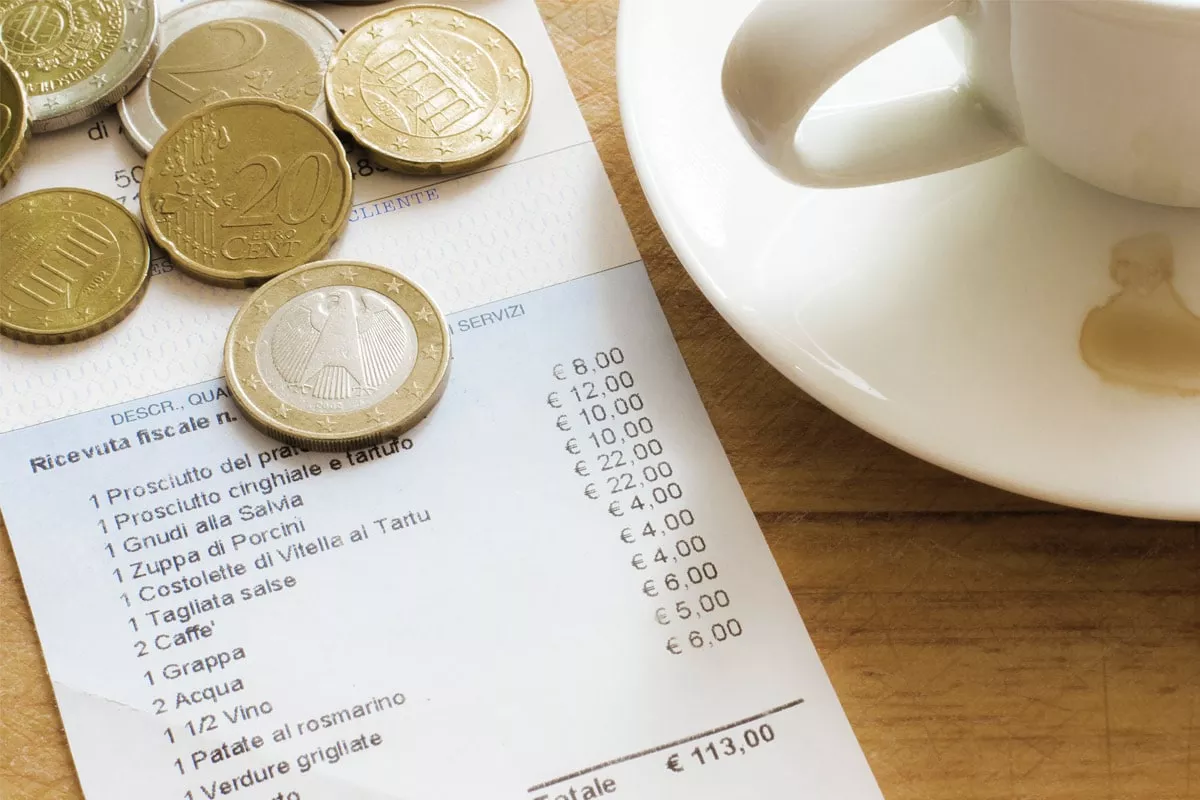
Everyone who has ever dreamed of visiting Paris, London, Rome, Barcelona, and other great European cities has had the same question— how much does it cost to travel to Europe?
Trying to wrap your head around all the travel costs is daunting, so that’s why I’ve analyzed the average food, accommodation, transportation, entertainment, and other prices from many of Europe’s top destinations to help you more accurately budget your travel expenses.
I’ve also factored in other common travel costs you might forget like pre-departure spending, airfare, train tickets, rail passes, travel gear, and more.
And since many of you have different travel styles, I’ve been sure to include the price breakdowns for backpacker-style travel , budget-conscious travel , and mid-level/higher-end travel — since that will obviously greatly affect your budgeting and spending.
Quick Look At Daily Europe Travel Costs By Travel Style

Before we dive deep into the costs of visiting Europe, let’s take a high-level look at typical day-to-day travel costs broken down by travel style.
Note: I’ve gone much more in-depth into these travel costs further on in this article — the prices in this section are ballpark figures.
Backpacker-Style Travel Costs: €45-€90/Day ($50-$100/day)
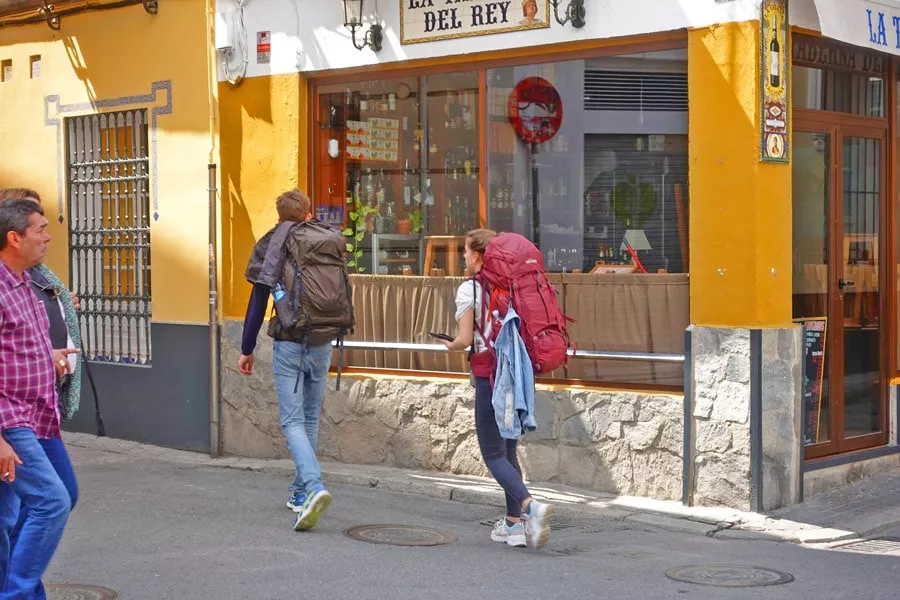
THIS IS YOU IF YOU’RE staying in hostels, eating cheap meals, or making your own food. You’re only drinking in dive/local bars, during happy hour, or buying alcohol from the grocery store. You’ll seek out cheap/free entertainment options. For transportation, you’ll use a rail pass or carefully pre-booking train tickets. You don’t mind foregoing creature comforts in the name of saving money.
In short, you’re looking to travel as cheaply as you can .
Average “Backpacker” Travel Cost Breakdown:
- Hostel Prices: A cheap bed in a quality hostel will cost anywhere from €15-€45/night. However, I’ve seen hostels run as high as €50-€75/night and as low as €10-€15/night depending on location, time of year, inventory, and room configuration. Check out Hostelworld to see hostel prices.
- Breakfast: I typically budget €3-€5/day for breakfast. This won’t get you much but it’s usually enough for a coffee and a croissant/pastry + maybe a piece of fruit. Sometimes hostels will provide a free breakfast.
- Lunch: If eating out, I budget anywhere from €6-€12 for lunch. This will get you a simple takeaway meal but you can cut this cost down if you make your own meal from a grocery store.
- Dinner: As with lunch, a takeaway meal will cost around €7-€10 but a meal at a cheap sit-down restaurant will cost around €8-€17. Obviously making your own meal will be a cheaper alternative.
- Alcohol: Beer and wine are cheap in grocery stores — a decent bottle of wine is €5-€6 and a 6-pack of beer is €5-€8. In bars/restaurants, a glass of wine is typically €3-€6 and beer is around €3.5-€7.
- Coffee: I budget €1-€1.5 for an espresso for a cheap caffeine fix.
- Desserts and Treats: I have a sweet tooth so I budget €2-€3 for random goodies.
- Attraction and Sightseeing Prices: I’m a big fan of free walking tours and I typically tip around €5-€8. Many museums have free days/times so that’s a good way to save — otherwise, museum tickets are typically €8-€20.
- Public Transportation: I tend to mostly walk so many days I don’t spend anything on transportation. Otherwise, I recommend budgeting €3-€5/day for the subway/buses.
Budget-Conscious Travel Costs: €90-€200/Day ($100-$220/day)
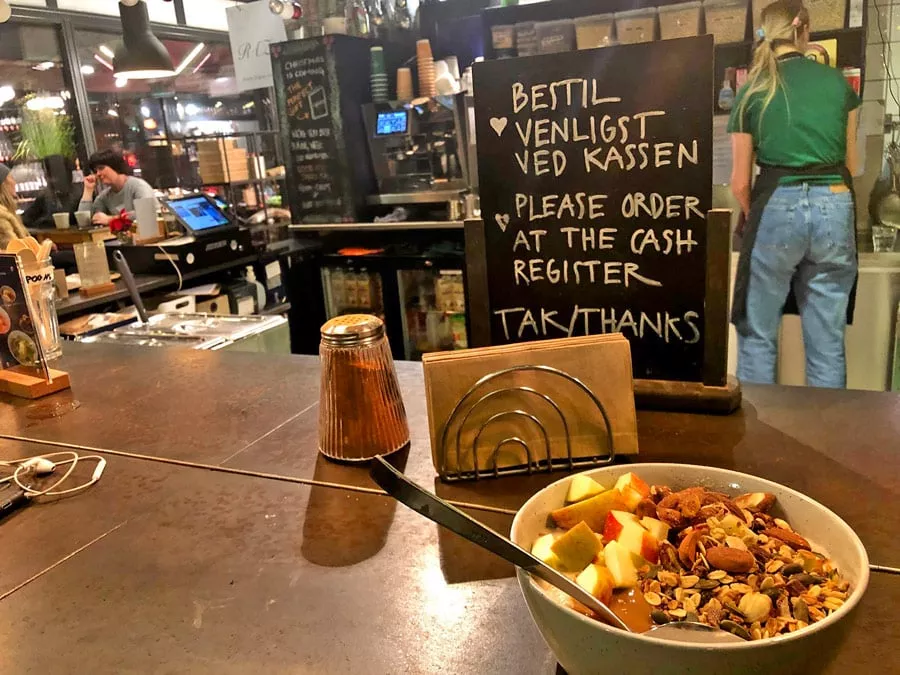
THIS IS YOU IF YOU’RE staying in affordable rental apartments, budget hotels, or you might get a private hostel room. You’re happy to spend €15-€25 on a meal now and then and you’ll splurge on a few treats as you explore. You don’t mind paying for experiences, and you’re happy to travel via train without booking weeks early to save a few dollars.
In short, you’re smart with your money but you don’t mind spending money on good values.
Average “Budget-Conscious” Travel Cost Breakdown:
- Rental Apartments: Airbnb is huge in Europe so it’s easy to find an affordable place in just about any city. A basic studio/1br will typically cost €60-€180/night.
- Budget Hotels: You can typically find a basic, yet clean and comfortable hotel for around €80-€120/night. I mainly use Booking.com when traveling in Europe.
- Private Hostel Rooms: Most hostels have private rooms that are about the same quality as a budget hotel — which is a nice option if you like the social vibe found in hostels. Expect to pay €60-€100/night for a private room.
- Breakfast: I typically budget €5-€6/day for breakfast since I need energy as I walk around all day. Different countries have different breakfast traditions so I tend to eat what the locals eat — which rarely tops €6. But, at the minimum, most cafes will have breakfast deals that include espresso and a pastry for around €3.
- Lunch: A cheap takeaway meal will set you back €5-€7. I try to seek out fixed-price lunch specials which typically run €9-€13.
- Dinner: A quality meal at a budget-friendly restaurant will set you back around €12-€20.
- Alcohol, Coffee, Treats, Etc.: Beer and wine are cheap in grocery stores — a decent bottle of wine is €5-€6 and a 6-pack of beer is €5-€8. In bars/restaurants, a glass of wine is typically €3-€6, and beer is around €3.5-€7. Cocktails can set you back €6-€12+.
- Coffee: I budget €1-€1.5 for an espresso. A cappuccino might cost anywhere from €1.50-€3.50.
- Desserts and Treats: I have a sweet tooth so I budget €3-€5 for random goodies like gelato and pastries.
- Attraction and Sightseeing Prices: Even as a budget traveler, I’m still a fan of free walking tours so I typically tip around €5-€8 for those — but a paid walking tour starts around €15-€20/person. Museum tickets are typically €8-€20.
- Public Transportation: I tend to walk everywhere but I still recommend budgeting €3-€6/day for the subway/buses.
Mid-Level Travel Costs: €150-€300/Day ($170-$340/day)
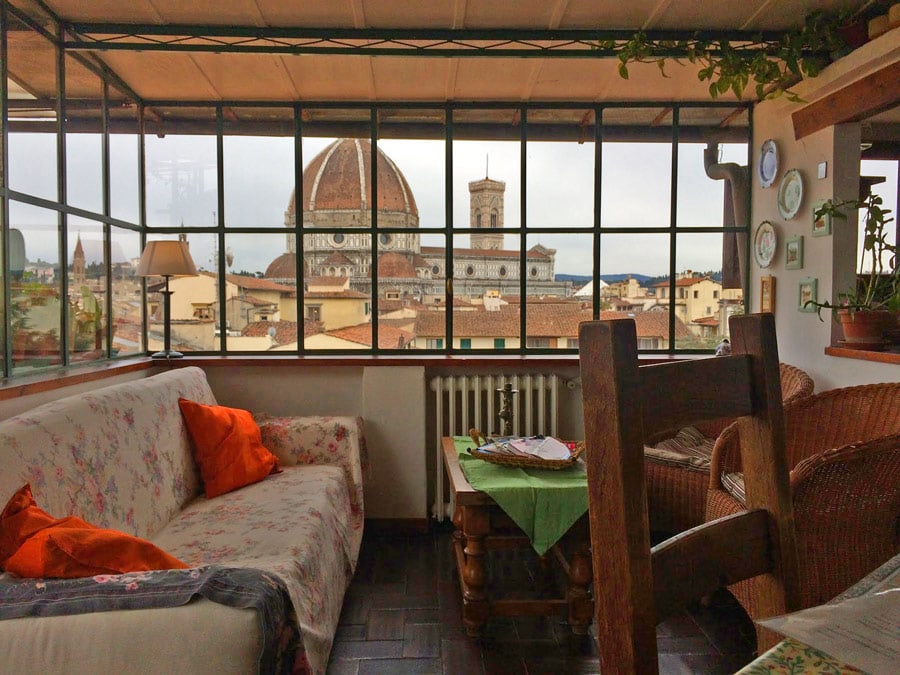
THIS IS YOU IF YOU’RE staying in nice (but not luxury) hotels or rental apartments. You’re not dining in high-end restaurants but dropping €25-€35 on a random meal isn’t that big a deal. You’re perfectly fine spending a little extra on train tickets for convenience and flexibility. You’re happy to visit all the museums/attractions without fear of busting your budget. You might even book a few “experiences” like a paid walking tour or a cooking class.
In short, you’re not “living large” but you’re comfortable spending a little extra here and there to enhance your experience and get the most from your travels.
Average “Mid-Level” Travel Cost Breakdown:
Budget Hotels, Rental Apartments, and Private Hostel Rooms: Accommodation prices are all over the place and constantly changing based on multiple factors. Obviously, traveling with other people will lower the per-person travel costs if you’re sharing a room/apartment.
- Rental Apartments: Airbnb is huge in Europe so finding a nice rental apartment isn’t difficult. A nice studio/1br will typically cost €120-€200/night.
- Hotels: A nice, but not fancy, hotel in a good location will typically cost €120-€180/night. I mainly use Booking.com when traveling in Europe.
- Breakfast: I typically budget around €6/day for a basic breakfast but a heartier one will be closer to €10.
- Dinner: A quality meal at a budget-friendly restaurant will set you back around €12-€20. A slightly nicer meal will be around €20-€30.
- Alcohol: In bars/restaurants, a glass of wine is typically €3-€6 and beer is around €3.5-€7. Cocktails can set you back €6-€12+.
- Coffee: Espresso starts around €1 and fancier drinks are €2.50-€4.
- Desserts and Treats: I have a sweet tooth so I budget €3-€5 for random goodies like gelato, pastries, and other sweet treats.
- Attraction and Sightseeing Prices: Museum tickets are typically €8-€20 each. Paid walking tours are anywhere from €15-€35. I enjoy cooking classes and those are anywhere from €45-€100+.
Pre-Departure Europe Travel Costs

Alright, let’s start doing a deeper dive into discovering how much it costs to go to Europe. We’ll start with pre-travel costs that should be factored into your budget.
High-Speed Mobile Data: $3-$10/Day
You can survive traveling to Europe without having mobile data on your phone but I don’t recommend it.
Your current mobile provider likely has their own international plan which will be around $10-$15/day. Or you can buy a European SIM or eSIM data plan that will cost under $5/day—for example, eSIM data plans from Orange or Holafly will cost you around $2-$4/day.
You can learn more on The Savvy Backpacker’s guide to the best eSIM for Europe and my guide to Data Plans and Smartphone Phones in Europe .
Travel Insurance: $30/Week
Travel insurance can really save your butt financially, so I build it into my travel budget. It’s usually fairly cheap and it might save you thousands of dollars in medical and travel costs. I use and recommend World Nomads for most travelers but there are a handful of other travel insurance companies.
As a rule of thumb, plan on spending around $30/week on travel insurance.
Luggage and Travel Gear: $0-$500+
In many cases, you might already have a suitcase or travel backpack so you may not even need to buy any special clothing for your trip to Europe.
But many people still choose to buy travel gear and/or clothing to help make their trip easier. Obviously, the amount you spend on this stuff can be $0 or it can easily top $500.
I’ve created a few packing lists and gear guides to help guide you:
- Backpacking Europe Packing List
- Travel Europe Packing List for Women
- Europe Packing List
- Winter Packing List for Europe
- Best Travel Backpacks
- Best Travel Backpacks for Women
- Best Carry-On Backpacks
- Best Travel Shoes
My Most-Recommended Travel Gear
Here are some things I never travel without (but see the guides above for more in-depth gear recommendations).
- Portable Phone Charger: I use my iPhone a ton when traveling and this kills the battery. That’s why I carry a small charger everywhere I go. You can find many options for $20-$30. Check Out Prices/Selection On Amazon
- I prefer carrying a stylish bag that doesn’t scream “tourist” — like something from Fajallraven , Herschel , and Aer . These bags range from $50-$90.
- Comfortable Shoes: A nice cool pair of comfortable sneakers will be your best friend when you’re traveling around Europe. Here is an article I wrote about wearing sneakers in Europe .
- Quality Socks: Treat your feet well and they’ll reward you with comfortable travel. I stick with socks from Smartwool and Darn Tough . A nice pair of socks will be $8-$14.
- Guide Books: Call me old-fashioned but I’m still a big can of guidebooks. For budget travel, I prefer Rick Steves and Lonely Planet. Check Amazon as they have a great selection of Europe guidebooks. Most guidebooks are around $20.
- Packable Rain Jacket: I hate umbrellas so I always pack a lightweight rain jacket that’s easy to store away in my daypack. The Patagonia Houdini weighs in at a crazy light 3.6oz and can be found online for $75-$99 (Available via REI and Amazon ).
- Apple AirPods: I love my AirPods. They make listening to music and watching movies on my iPad so much more convenient — especially on planes/trains. They’re cheaper on Amazon than from Apple.
Passport: $110+
It will cost you around $135 if you need a passport. Be sure to apply early because it will cost you another $60+ if you need one in less than 4-6 weeks. Passport photos will cost you about an extra $10 or you can print your own for free at ePassportPhoto .
Airfare Prices To Europe ( $750-$1200 )

It’s hard to nail down how much you’ll spend on your flight to Europe. Prices fluctuate wildly based on your location, the time of year, what days you’re traveling, where you’re flying to, how early you’re booking your flights, your flexibility, etc.
I’ve paid as little as $280 for a ticket from NYC to Copenhagen and I’ve paid $1,200+ for other flights to Europe. That said, I recommend budgeting at least $750-$1100 for your flight — hopefully, you’ll be able to find cheaper flights but this is a pretty good ballpark figure.
I use Google Flights and Momondo to look for flights. I also subscribe to Scott’s Cheap Flights newsletter which sends out daily cheap flight deals.
Estimating Transportation Costs Within Europe
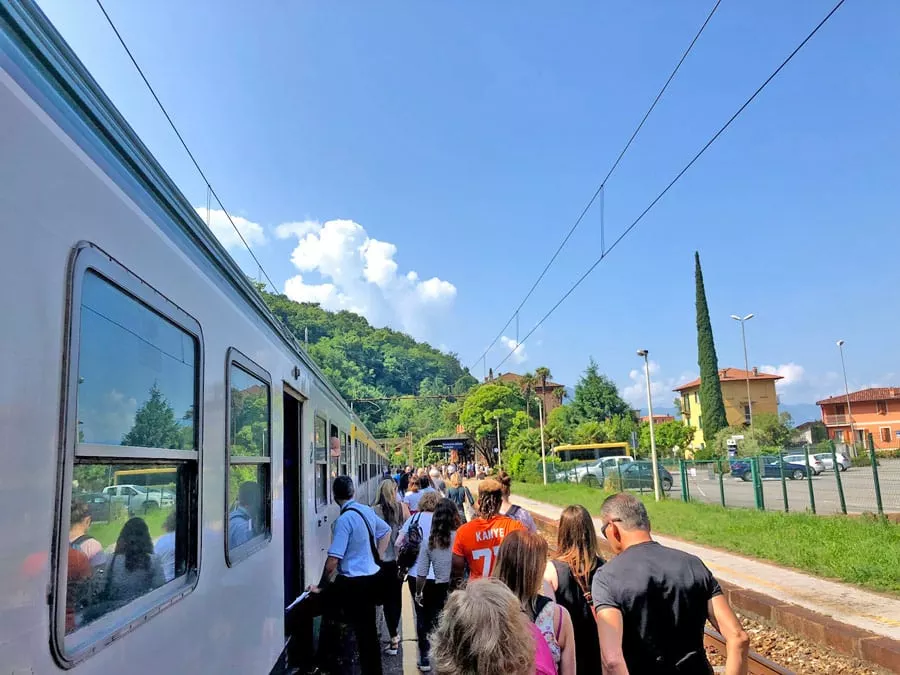
Another large travel cost will be transportation — i.e. how much you’ll spend physically traveling around Europe.
There are generally four main modes of transportation:
- Train: My favorite travel option. It’s generally fast, convenient, comfortable, and affordable (if you book in advance). Train travel is also the most romantic way to travel around Europe.
- Plane: For long distances, I prefer flying as there are plenty of very cheap flights throughout Europe.
- Car: Driving can be a nice option if you’re traveling in a group as the cost gets spread out between multiple people. And you can visit smaller destinations more easily with a car (although just about every town in Europe is accessible via train). That said, I’d avoid driving in any major European city if possible.
- Bus: I’ve never like traveling via bus but it can be a very cheap way to travel.
Europe Train Ticket Prices

Each country prices its train tickets differently — some charge via distance traveled (€/mile) but most have dynamic pricing that fluctuates based on demand (i.e. similar to how airlines price their tickets). For this section, we’ll focus on high-speed trains as that’s what most travelers will use to travel between major cities.
For more information, read our Complete Guide To Train Travel In Europe .
Example High-Speed Train Prices For Popular European Routes
Note: I used Omio to find these train ticket prices — I’ve been using Omio to book all my European train tickets for the past few years. I love that their tickets are mostly digital/mobile (via their App) so no more standing in line to buy/collect tickets.
- Booked a few weeks before departure: €66-€100
- Booked two or three days before departure: €190-€250
- Booked a few weeks before departure: €70-€100
- Booked two or three days before departure: €135-€155
- Booked a few weeks before departure: €13-€22
- Booked two or three days before departure: €20-€40
- Booked a few weeks before departure: €45-€75
- Booked two or three days before departure: €45-€75
- Booked a few weeks before departure: €45-€70
- Booked two or three days before departure: €45-€70
- Booked a few weeks before departure: €24-€43
- Booked two or three days before departure: €24-€60
- Booked a few weeks before departure: €25-€35
- Booked two or three days before departure: €25-€35
- Booked a few weeks before departure: €91-€100
- Booked two or three days before departure: €91-€100
- Booked a few weeks before departure: €14-€30
- Booked two or three days before departure: €20-€35
- Booked a few weeks before departure: €99-€120
- Booked two or three days before departure: €133-€145
- Booked a few weeks before departure: €35-€45
Source: Omio

Eurail Pass Prices
If you want flexibility then you might consider picking up a Eurail Pass. These passes aren’t dirt cheap like they were in the past, but for many travelers, this is still an affordable way to travel. There are dozens of Eurail passes available to suit almost any need. Prices range from about $100 for a super basic pass to $2000 for a 3-month unlimited pass.
For more info, read our Guide To Rail Passes in Europe .
Airfare Prices Within Europe

Many first-time travelers are amazed at the number of budget carriers offering crazy low airfare within Europe — we’re talking €20 flights from London to Amsterdam and €35 from Paris to Rome. I’ve even seen flights for under €10.
That said, you can essentially fly between any two major European cities for less than €70 — but don’t forget to budget extra cash for transportation to/from the airport (train, taxi, Uber) bag fees, etc.
Quick Note About Budget Carriers and Cheap Fares: Budget carriers offer the bare minimum in terms of service and everything costs extra (bags, seat assignment, drinks, etc.). Also, many budget airlines fly out of smaller airports that are outside the cities they represent — for example, the Paris-Beauvais airport is more than an hour away from Paris so that’s an extra cost and inconvenience.
Example Cheap Airfare Prices For Popular European Routes
Note: These example fares are for one-way tickets—I suggest checking Momondo for your exact travel dates since prices constantly fluctuate.
- London To Paris : €32-€52
- Paris to Rome: €32-€100
- London to Rome: €60-€100
- Rome to Lisbon : €35-€45
- Paris to Lisbon: €70-€120
- Amsterdam to Berlin: €32-€45
- Madrid to Lisbon: €45-€70
- Paris to Barcelona : €25-€35
- Paris to Lyon : €50-€85
- Copenhagen to Paris: €65-€100
Cost To Rent A Car In Europe

Renting a car can be a reasonably affordable way to travel Europe — especially if you’re traveling in a group of three or more.
I just did a search for a weeklong rental in France for a compact car and it was around €200 total. However, there are other costs associated with driving in Europe:
- Gas ($6-$8/gallon)
- Tolls (I’ve seen €3-€30 per toll)
- Random taxes
- Extra insurance ($10-$20/day)
- Parking (€40+/day in major cities)
- Extra random fees
Here is our guide to renting a car in Europe that goes into more in-depth detail.
Cost of Coach/Bus Travel In Europe
Taking long-distance buses is probably the cheapest way to travel in Europe but it’s also the slowest and arguably the most uncomfortable. Personally, I won’t even consider the bus if the trip is more than a few hours as 8 hours on a bus sounds terrible. Either way, I use Omio to find and book bus tickets.
Example Long-Distance Bus Prices For Popular European Routes
- Paris to Strasburg: €17-€20
- Munich to Berlin: €22-€24
- Rome to Florence: €22-€30
- Barcelona to Madrid: €36-€38
- Munich to Salzburg: €17
Accommodation Costs For Traveling Europe
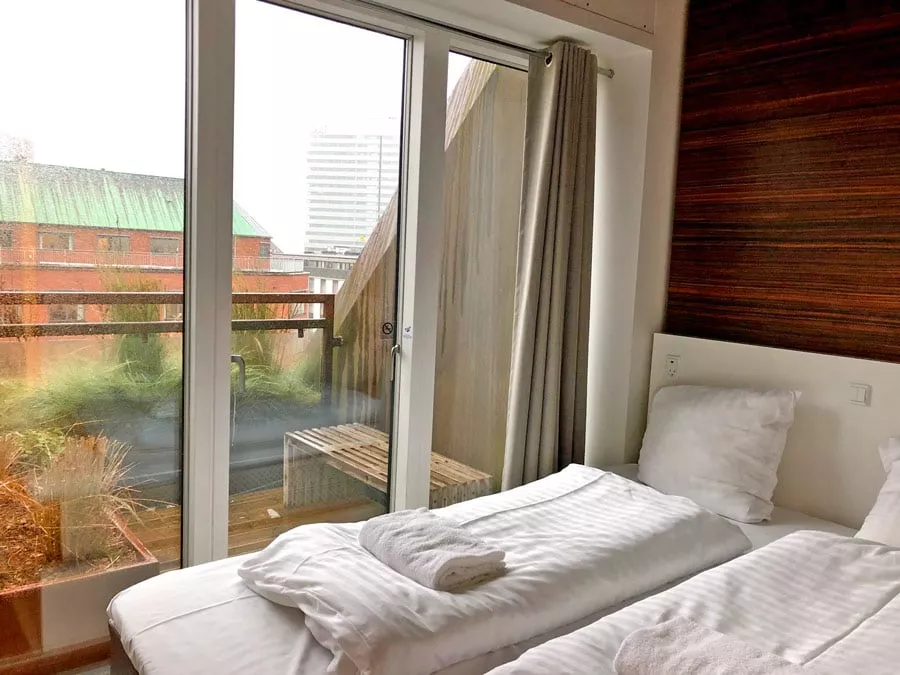
For most travelers, accommodation will be the largest expense so it’s important to know how much you should budget. Let’s dive into how much you’ll spend on accommodation (hotels, hostels, and rental apartments) while you’re traveling in Europe.
Average Hostel Prices in Europe
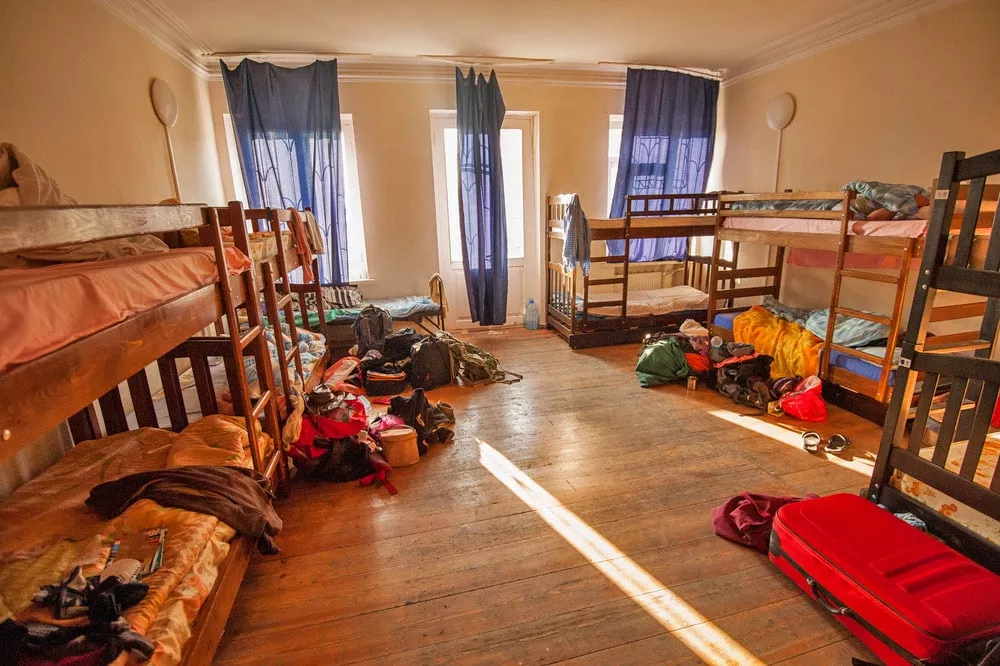
Here’s a look at the average nightly hostel price for Europe’s most popular cities. These prices reflect the cheapest option in well-rated hostels during a late June booking. These prices are from Hostelworld (my preferred hostel booking website).
- London: €30-€65/night
- Paris: €33-€65/night
- Dublin: €30-€60/night
- Amsterdam: €30-€60/night
- Munich: €35-€65/night
- Berlin: €20-€39/night
- Krakow: €14-€25/night
- Budapest: €16-€25/night
- Barcelona: €25-€45/night
- Rome: €23-€50/night
Source: Hostelworld
Average Hotel Prices in Europe
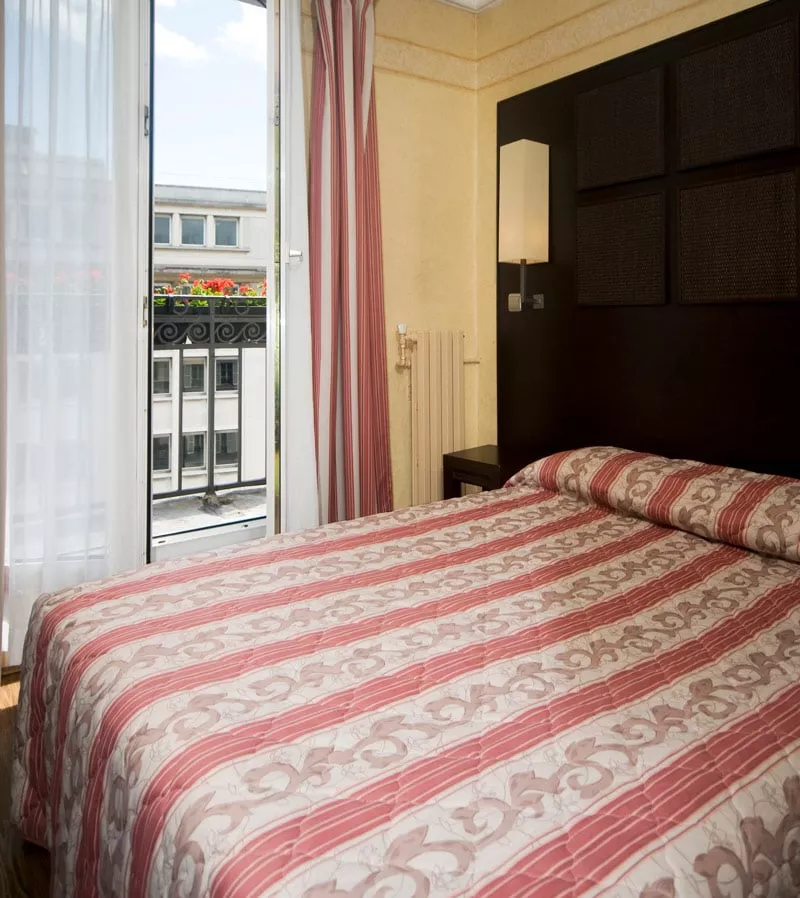
Here’s a look at the average nightly hotel price for Europe’s most popular cities.
Note: These prices reflect the cheapest option in well-rated hostels during a late June booking. These prices are from Booking.com (my preferred hotel search engine).
Nightly Price For A Budget Hotel in Europe
The prices on this list reflect budget hotels that are small, no-frills, and a little “rough around the edges” but they should be clean, comfortable, and located within the city. They get good ratings from past guests so these aren’t the bottom-of-the-barrel options.
- London: €80-€115/night
- Paris: €90-€110/night
- Dublin: €115-€140/night
- Amsterdam: €125-€145/night
- Munich: €90-€115/night
- Berlin: €85-€100/night
- Krakow: €50-€95/night
- Budapest: €50-€93/night
- Barcelona: €75-€100/night
- Rome: €80-€105/night
Source: Booking.com
Nightly Price For A Mid-Level Hotel in Europe
I consider a mid-level hotel to be clean, comfortable, fairly modern, and centrally located. The rooms will still be small and there might not be many “frills” but the hotel will be a noticeable step above the “budget” level.
- London: €140-€180/night
- Paris: €135-€190/night
- Dublin: €135-€195/night
- Amsterdam: €165-€200/night
- Munich: €110-€175/night
- Berlin: €110-€180/night
- Krakow: €75-€120/night
- Budapest: €125-€170/night
- Barcelona: €110-€160/night
- Rome: €110-€175/night
Average Rental Apartment Prices in Europe
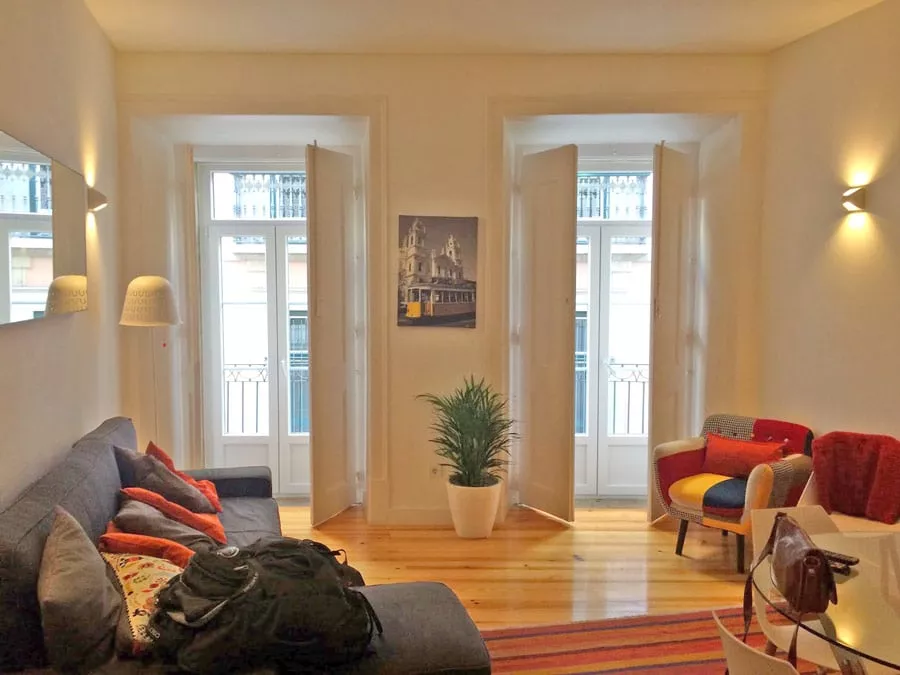
Short-term rental apartments are plentiful and often affordable in Europe, so it’s one of my favorite accommodation options when I travel.
Note: I’ve listed rental apartments from a price range for well-rated, and centrally located studio/1br Airbnb rentals that get solid reviews from former guests — I also tried to only include Superhosts to ensure a high level of service. You’ll be able to find cheaper options if you’re less picky.
- London: €190-€280/night
- Paris: €105-€160/night
- Amsterdam: €220-€300/night
- Berlin: €93-€160/night
- Krakow: €50-€85/night
- Budapest: €70-€105/night
- Barcelona: €140-€190/night
- Rome: €120-€165/night
Source: Airbnb —check out my guide to Airbnb Alternatives for more options.
Food & Alcohol Costs in Europe

Food, meals, and alcohol are other major costs that are difficult to estimate since there is a huge variation in prices. In general, I recommend budgeting higher than you think since it’s easy to go over budget without even realizing it.
To help give you an accurate idea of food prices, I’ve searched through actual menus from restaurants that span multiple price points. I’ve broken this list down by city to help you more accurately predict your potential food expenses.
Note: These prices come from well-rated restaurants that are recommended by locals. I’ve also linked to their restaurant’s Google listing.
Paris Food Prices
- Croissant: €2
- Cafe au lait: €3
- Espresso: €1-€1.50
- Sandwich from Grenier au Pain : €3.50-4.50
- Chicken and lamb kebab from Urfa Dürüm : € 6- € 8
- Burger and fries from Joe Burger : € 8- € 10
- Falafel and shawarma sandwich from L’As du Fallafel : €7-€9
- Crepes and sandwiches (takeaway) from Chez Alain Miam Miam : €7-€11
- Duck Confit from Le Petit Vendome : €17
- Duck Confit from Cafe de l’Industrie : € 13- € 14
- Crepes from Breizh Cafe : €7-€12
- Beef bourguignon (beef stew) from La Petite Rose des Sables : €13
- Pho from Pho 14 : €9
- A glass of wine: €3-€5
- A glass of beer: €4-€7
Note: See our guide to the best budget restaurants in Paris .
London Food Prices
- Full English breakfast from Breakfast Club : £10-£12
- Cappuccino from Kaffeine : £3.10
- A standard cup of coffee: £2.50
- Lamb Shawarma wrap from Hiba : £5.25-£6.25
- Vietnamese noodle dish from Phat Phuc Noodles : £8
- Traditional pie and mash from The Windmill. Mayfair : £13-£16
- Fish and Chips from Masters Superfish : £ 9- £ 10
- Fish and Chips from P oppie’s : £ 4- £ 18
- Mid-range Indian dish from Darjeeling Express : £13-£16
- Takeaway Indish dishes from TIFINBOX – Indian Street Food : £6-£8
- Dip and Flip burger from Dip & Flip : £10
- A pint of beer: £4.50-£6.50
- A glass of wine: £5.50-£7
- Mixed drink and cocktails: £8-£14+
Rome Food Prices
- Cornetto pastry and a cappuccino from Antico Forno Roscioli : €1 + €1.30
- Espresso from La Casa Del Caffè Tazza D’oro : €1
- Sandwich/panini from Panino Divino : €5-€6.50
- Takeout pizza (two slices) from Pizzarium or Pizza Florida : €5-€8
- Takeout pasta from Pasta Imperiale : €5.50-€6.50
- Pasta dish from Felice a Testaccio : €11-€15
- Cacio e Pepe from Trattoria Da Cesare al Casaletto : €11
- Carbonara pasta from Trattoria Perilli : €13
- Pizza from Ai Marmi : €7-€10
- A glass of wine: €4-€6
- A pint of beer: €4-€6
Berlin Food Prices
- Brunch and pancakes from Le Bon : €9-€10
- Breakfast and brunch items from Distrikt Coffee : €8-€11
- Espresso and Flat White from THE BARN Café : €3 & €4
- Doughnuts from Brammibal’s Donuts : €2.50
- Crepes and breakfast quiches from Cafe Creperie Melt : €3.50-€8
- Currywurst from Curry61 : €2.50
- Takeaway schnitzel from Scheers Schnitzel : €5.50-€8.50
- Burger from Burgermeister : €4.50-€5.56
- Kebab from Mustafa’s Gemüse Kebap : €4-€5.50
- Goulash and schnitzel from Tiergarten Quelle : €10.50 & €11.50
- Half chicken from Henne : €8.60
- Hearty traditional German dishes from Gasthaus Krombach : €11-€15
- A pint of beer: €2.50-€3.50
Amsterdam Food Prices
- Omelets and breakfast sandwiches from Omelegg : €6-€10
- Dutch and American pancakes and breakfast options from Prins Heerlijk : €4-€10
- Breakfast and lunch toasted sandwiches from Toastable Nieuwendijk : €5-€10
- Assorted pastries from Bakhuys : €3-€6
- Espresso and pour-over coffee from Bocca Coffee : €2.5 & €4
- Baked potatoes w/ toppings from Jacketz : €9-€14
- Roman-style pizza by the slice from Sugo Amsterdam : €3.50-€4.50/slice
- Kebab from Beste Doner : €5
- Fries with choice of sauce from Vlaams Friteshuis Vleminckx : €3-€4.50
- Fish and chips from The Good Companion : €14-€15
- Burgers from Burger Bar : €8-€11
- Simple pasta dishes from Hasta La Pasta or Pasta Pasta : €8-€14
- Traditional Dutch dishes from Hap-Hmm : €10-€14
- Wood-fired, thin-crust pizzas from Il Sogno : €10-€13
- A pint of beer: €3.50-€6.50
Barcelona Food Prices
- Churros dipped in melted chocolate from Churreria Laietana or Granja M Viader : €3.80
- Pancakes and granola/acai bowls from Brunch El Petit Princep : €4.5-€7
- Croissants and similar pastries from Baluard Barceloneta : €1.60-€3.50
- Double espresso and Flat White from Satan’s Coffee Corner : €3.20
- Espresso and drip coffee from Nomad Coffee Lab & Shop : €2.50-€4 & €3
- Affordable tapas and other local favorites from Bar Xapako : €2-€4/tapa
- Fixed menu of Spanish staples from Bar Casi : €12
- Pizza by the slice at Com a Italia : €3/slice
- Lebanese sandwiches and wraps from Teddy’s Saj Sandwiches : €4.50-€6
- Classic regional dishes from Can Culleretes (the oldest restaurant in Spain): €9-€19
- Regional rustic fare from El Glop : €9-€20
- Tapas from Quimet & Quimet : €2-€5/each
- Tapas from La Tasqueta de Blai : €5-€9/each
- Fish and chips from The Fish & Chips Shop : €8.50
- Beer (small glass): €1-€1.30
- Beer (bottle): €1.40-€3
- A glass of wine: €2.50-€4
- Glass of vermouth from Quimet & Quimet : €2.80
Madrid Food Prices
- Churros and hot chocolate from Chocolatería San Ginés : €4.20
- Torrijas (similar to french toast) from La Casa de las Torrijas : €2.50-€4
- Napolitana con Chocolate pastry from La Mallorquina : €2
- Espresso or coffee from Martina Cocina or Hola Coffee : €1.50-€3
- Fried calamari sandwiches from Bar La Campana : €3
- Small pork sandwiches from Bocadillos Oink : €4-€7
- Pizza by the slice or full pizza at La Pizzateca : €3-€4/slice or €9-€13/pizza
- Assorted tapas from Gandario , El miniBAR , and Tinto y Tapas : €2-€8/each
- Homestyle Spanish dishes from La Sanabresa : €18 (fixed price menu)
- Tortillas (Spanish omelet) from Pez Tortilla : €3/slice
- Deep-fried croquetas from Casa Julio : €7-€12
- Huevos Rotos (fried eggs and ham over french fries) from Los Huevos de Lucio or Antigua Huevería : €9-€18
- Glass of vermouth from Bodegas Ricla : €1.50
Lisbon Food Prices
- Double espresso and cappuccino from Fabrica Coffee Roasters : €2 & €2.80
- Pasteis de Nata from Pasteis de Belem , Manteigaria , or Fabrica da Nata : €1.15/each
- Various pastries from Pastelaria Alfama Doce : €.80-€1.20/each
- Pancakes and eggs from Quase Cafe : €4.50-€7.50
- Breakfast bowls and smoothies from Frutaria : €5 (breakfast bowls) & €5 (smoothies)
- Traditional local dishes at good prices from A Provinciana : €6-€9
- Pork sandwich ( bifanas ) from O Trevo : €2.50
- Burgers from Cultura do Hamburguer : €7-€10
- Grilled chicken, ribs, and sausage from Frangasqueira Nacional : €7-€1.50
- Hotdogs from Frankie : €3-€6
- Gyro from A Gama do Vasco : 7-9
- Traditional Portuguese dishes from husband and wife team at Crisfama : €9-€15
- Traditional Portuguese tavern favorites from Tasca Zé dos Cornos : €9-€13
- Large portions (enough for two) of traditional local dishes from Zé da Mouraria : €17-€22
- Beer at a bar or restaurant: €1.50-€3
- Beer at a grocery runs about €1.10
- A bottle of wine is around €4.50
Copenhagen Food Prices
- Double Espresso from The Coffee Collective : $4.20 (28 DKK)
- Cinnamon Roll from Skt. Peders Bageri : $2.75 (18 DKK)
- Breakfast Porridge from Grød : $7-$10 (45-65 DKK)
- Burger from Gasoline Grill : $11.50 (75DKK)
- Kebab/Turkish Dish from Kosk Kebab : $5.35-$11.50 (35-75 DKK)
- Hotdog from Hotdog Stand , John’s Hotdog Deli , or DOP $5.35 (35 DKK)
- Pizza from Gorm’s : $15-$19 (100-125 DKK)
- Classic homemade Danish cuisine from Restaurant Klubben : $16-$35
- Authentic Mexican food from Hija de Sanchez : $15 (three tacos)
- Vietnamese sandwiches, noodles, and other dishes from District Tonkin : $10-16
- High-End Cocktail from Ruby : $16.75-$20+ (110-120+ DKK)
- Craft Beer from Mikkeller Bar : $6.80-$10 (45-65 DKK)
Prague Food Prices
- Fancy pancakes from DEN NOC: Pancakes start under $5-$7.50
- Coffee from Cafe Ebel : $2-$4.50
- Gourmet doughnuts from Donuterie : $2.50/each
- Hot chocolate, waffles, and sweet treats from Chocafé : $3 (hot chocolate), $3.5 (waffles), $1.50-$3 (treats)
- Pancakes and coffee from Cafe No 3 : $2 (coffee) and $6 (pancakes)
- Traditional open face sandwiches from Sisters Bistro v Dlouhé : $2-$3
- Traditional Czech cuisine from Ferdinanda : $10-$14
- Traditional Czech cuisine from Restaurace Pod Vysehradem : $8-$14
- Large burgers from Sad Man’s Tongue Bar & Bistro : $11-$14
- Pizza and pizza slices from Johnny Pizza : $6.50 (pizza and soda)
- Hotdogs w/ toppings from Mr.HotDoG : $5-$6.50
- A pint of standard beer at the bar: $1.00-$2.00
- Pint of beer from a grocery store: $.65
Budapest Food Prices
- Cappuccino and espresso from 9BAR : $1.50-170
- Coffee and granola from VINYL & WOOD : 1.50 (coffee) & $4-$4.50 (granola)
- Huge cinnamon rolls, and chocolate rolls from Bite Bakery Cafe : $2.25
- Bagel sandwiches from Inez Bagel Shop : $3.50-$5
- Traditional Hungarian breakfast sandwiches from Duran Szendvics : $1-$4
- Authentic Hungarian food from Klauzal Cafe : $8-$12
- Sandwiches and soups from Bors GasztroBar : $4-$5
- Traditional Hungarian food from Regos Restaurant : $7.35-$12
- Hungarian sandwiches and burgers from Hoppacska : $5.60-$9.00
- Cheap burgers from Buddies Burger : $4-$5.50
- Local Korner: Excellent pizza in a super fun atmosphere.
- Pho from Hai Nam Vietnamese Bistro & Pho Bar : $5.75-$6.50
- A pint of standard beer at a bar: $1.30
- A pint of beer from a grocery store: $.85
- Bottle of (drinkable) wine from the grocery store: $4.75
Day-To-Day Travel Costs For Europe
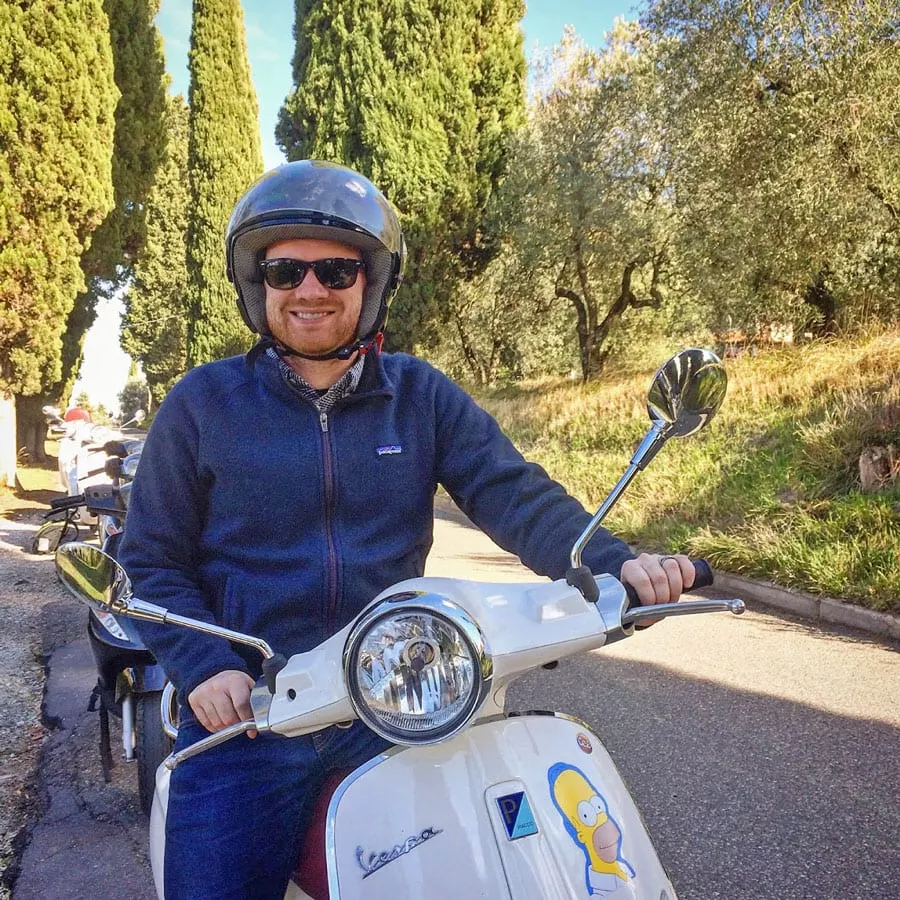
As you travel you’ll run into various daily costs that you should take into account when you’re estimating your travel budget. Here are a few of the most common things you’ll spend money on when traveling.
Museums, Sightseeing, and Entertainment Costs
While you may not do something that requires an admission fee every day, we suggest budgeting $15-$20. Below is a list of admissions prices at some popular attractions in Europe so you can get a feel for how much things cost:
- Louvre Museum (Paris): $19.50
- Sagrada Familia: $19
- Centre Pompidou Museum (Paris): $17
- Tower of London: $35
- Van Gogh Museum (Amsterdam): $22
- Prague Castle: $3.50
- Neuschwanstein Castle: $15
- Acropolis: $12
- Colosseum: $15
- Szechenyi Baths in Budapest: $18
- Walking Tours: Free (guides work on tips) or $15-$35 for paid tours
- Bike Tours: $30-$60
- Food Walking Tours: $50-$100+
- Cooking Classes: $50-200+
- Venice Gondola Ride: $90-$110
Note: Many museums offer discounted or free tickets to students and/or people under the age of 26.
I briefly mentioned alcohol in the food section but I wanted to highlight it again since many travelers end up spending way more on alcohol than they anticipate — after all, one drink tends to lead to a few more.
Listed below are some sample alcohol prices from around Europe:
- London (pint of beer): $3.20-$8.50 but expect to pay more at trendy clubs/pubs.
- Paris (wine): $7-$15 for a cheap bottle of good wine from the store.
- Prague (pint of beer): $2 at a restaurant and around $.70 from a grocery store.
- Budapest (pint of beer): $2-$4 at a bar.
- Munich (beer): $10 for a huge mug at a beer garden and around $1.25 for a liter of beer from the store.
- Copenhagen (pint of beer): $9-$14 for a pint of craft beer from a bar.
Public Transportation, Taxis & Airport Transfers
Public transportation in most European cities is cheap and reliable. In general, you probably won’t spend more than $4-$6/day taking subways and buses.
However, taking taxis and Ubers can quickly become expensive. This is especially true when you’re going to/from the airport — which many travelers forget to factor into their budgets.
For reference, here are some taxi fares from major airports to the city center:
- Paris/CDG Airport: €50-€55
- London/Heathrow Airport: £45–£70
- Rome/Leonardo da Vinci-Fiumicino Airport: €48
- Amsterdam/Schiphol Airport: €39
- Milan/Malpensa Airport: €90
- Lisbon/Lisbon Portela Airport: €20
- Copenhagen/Copenhagen Kastrup Airport: 300 DDK ($45)
Snacks and Treats
I have a sweet tooth so I always know that things like ice cream, chocolate, pastries, and other random treats I see in store windows will catch my eye. That’s why I give myself a few extra Euros each day to be safe.
Souvenirs and Shopping
Don’t forget to put aside some cash for souvenirs and other shopping that you might do as you travel. I know I always end up buying a bunch of random things along the way. You might also end up spending money on random toiletries.

I hope this Europe price guide helped give you a better grasp of how to budget your trip to Europe. Feel free to leave a comment if you have any questions!
- Recent Posts
- Best Prepaid eSIM For Spain | Data Plan Buyer’s Guide - June 21, 2024
- Best eSIM For Europe Travel | Everything You Need To Know About European Prepaid eSIM Data Plans - June 6, 2024
- Orange Holiday Europe SIM Card Review | I Test This Popular Tourist-Focused Data Plan - June 4, 2024

No Funny Business
The Savvy Backpacker is reader-supported. That means when you buy products/services through links on the site, I may earn an affiliate commission—it doesn’t cost you anything extra and it helps support the site.
Thanks For Reading! — James
Questions? Learn more about our Strict Advertising Policy and How To Support Us .
Related Reads
Money & Budgeting , Trip Planning
Is Travel Insurance Worth It? Helping You Understand Travel Insurance
Everything you need to know about buying travel insurance
How Much To Tip In Europe | Guide To Tipping In Europe By Country
A country-by-country guide to tipping and gratuity customs in Europe
The Ultimate Guide To Using Credit Cards, Debit Cards, & ATMs in Europe
Everything you need to know about using your credit cards and debit/ATM cards in Europe.
Backpacking Through Europe Cost | How Much Does It Cost To Backpack Europe?
How much to budget for traveling to Europe.
City Guides
Choosing travel insurance, travel packing lists, budget travel newsletter.
The best budget travel tips sent straight to your inbox.
Join My Journey
Europe travel tips, advertising & privacy policies.
TheSavvyBackpacker.com is a participant in the Amazon Services LLC Associates Program, an affiliate advertising program designed to provide a means for sites to earn advertising fees by advertising and linking to amazon.com.
© 2010 - 2024 The Savvy Backpacker
Website Design by FHOKE
Get Daily Travel Tips & Deals!
By proceeding, you agree to our Privacy Policy and Terms of Use .
What Does a Week in Europe Cost?
A nationally recognized reporter, writer, and consumer advocate, Ed Perkins focuses on how travelers can find the best deals and avoid scams.
He is the author of "Online Travel" (2000) and "Business Travel: When It's Your Money" (2004), the first step-by-step guide specifically written for small business and self-employed professional travelers. He was also the co-author of the annual "Best Travel Deals" series from Consumers Union.
Perkins' advice for business travelers is featured on MyBusinessTravel.com , a website devoted to helping small business and self-employed professional travelers find the best value for their travel dollars.
Perkins was founding editor of Consumer Reports Travel Letter, one of the country's most influential travel publications, from which he retired in 1998. He has also written for Business Traveller magazine (London).
Perkins' travel expertise has led to frequent television appearances, including ABC's "Good Morning America" and "This Week with David Brinkley," "The CBS Evening News with Dan Rather," CNN, and numerous local TV and radio stations.
Before editing Consumer Reports Travel Letter, Perkins spent 25 years in travel research and consulting with assignments ranging from national tourism development strategies to the design of computer-based tourism models.
Born in Evanston, Illinois, Perkins lives in Ashland, Oregon with his wife.
Travel Smarter! Sign up for our free newsletter.
A reader recently posed a simple question—with a complicated answer:
“How much does a weeklong vacation to Europe cost?”
The wiseguy answer would be the same as in the old joke about consultants. Client’s question: “How much is two plus two?” Consultant’s answer: “How much do you want it to be?” Actually, that answer has more validity in the travel context than in business—variations are tremendous. But we can at least zero in on some lower limits.
One-City Trip
One of the two least expensive options for a one-week European trip to stay in just one major city. Then, your only costs are round-trip airfare, hotel accommodations, meals, local transportation, sightseeing and admissions, and incidentals. Let’s look at a trip with seven nights in Europe. (A tour operator would call it eight days and would count the overnight flight to Europe as one of the tour’s nights, but in practice, you lose at least a half day on your arrival and your departure days.)
- Airfare, of course, depends on your origin, destination, and season of travel. If we assume a trip in June, currently quoted round-trip fares range from about $850 from Boston to London to about $1,150 from San Francisco to Rome. You may find the usual fare quirks—you could knock $150 off the Boston-London fare, for example, by flying an extra three hours and connecting in Washington. And future “sales” could knock $100 to $200 off those rates. Same goes for traveling in spring or fall.
- Hotel costs obviously depend on your preferred level of comfort. You can still find plenty of acceptable, if basic, hotels and B&Bs in most European capitals for under $75 per night, double occupancy, including taxes. Reasonably comfortable hotels are available for around $100 a night in many cities, but they’re a bit more in London. At the low end, you’d be looking at around $600 for seven nights. Consider air/hotel packages from the big online agencies such as Expedia , Orbitz , or Travelocity , which often add to less than individual bookings. For bottom pricing in a few big cities, try Hotwire or Priceline : Hotwire, for example, is quoting rates for three-star hotels well under $100 a night in London.
- Restaurant meals are another imponderable. If you stay in a B&B or hotel that includes breakfast in the room rate, you could get by for as little $50 per person per day, but that would require a few McDonald stops and little or no wine with dinner. Let’s say $1,000 for two people for the week.
- Local transit: Figure on up to $50 per person for local transit daily or weekly passes. That limit probably means no side trips to such places as Oxford, Giverny, of the Villa d’Este. And stay away from the taxis. For the full trip, call it $100.
- Sightseeing and admissions: Again, there’s a huge range, but I’d figure at least $150 per person, or $300 total.
At a minimum, then, you’re looking at airfare plus around $2,000, per couple, give or take $100 or so depending on your preferences.
Countryside Trip
The other lowest-cost way to visit for a week Europe is to stay in the countryside. You can either set up a single base and do day-trip excursions to nearby attractions or you can move around every day or two, in short hops. Obviously, this sort of trip requires a rental car.
- Airfare: You’d have the same airfare as a city trip.
- Accommodations: Staying in countryside inns would cut your hotel bills substantially. Plenty of budget hotels are available for under $50 a night, double occupancy, so call your bill $350 for the seven nights. You could also find a one-week one-bedroom vacation rental or “gite” for around that figure.
- Restaurant meals: Eating, too, can be less expensive in the countryside than in the major cities, and in a vacation rental you can prepare some of your own meals. Call it $800 for two.
- Rental car: You can rent a small car for under $300 a week, including taxes and fees, in most of Europe; less than that in some countries. Use your credit card to provide collision coverage; buying the rental company’s CDW would add another $250 to $300 a week. Add $150 for gas, for a total cost of $450.
- Sightseeing and admissions: Again, you’ll probably spend less in the country. Call it $200, total.
This trip adds up to airfare plus $1,800 for a couple—a bit less than the big-city stay, but, of course, a completely different experience.
Two-City Trips
Adding additional destinations adds to you cost. Figure each move costs a minimum of $100, out of pocket, for train fare and travel between stations and hotels. A city-to-city move also uses up a lot of travel overhead . Each move takes, at a minimum, a full half day, and most moves take more than that, given the amount of time you need to pack, check out, head for a train station or airport, ride to another town, get to a hotel, check in, and unpack. Figure around $300 or so in travel overhead per move.
My conclusion: If you’re traveling on your own, for just one week, it’s almost imperative that you confine yourself to no more than two cities—London and Paris, for example, Zurich and Geneva, or Rome and Venice.
Multi-City Trips
If you feel the need to see three or more cities in a trip as short as a week or 10 days, your best bet is probably one of those “If it’s Tuesday, this must be Belgium” package tours that include hotel, intercity travel in a tour bus, sightseeing, and some meals. Several tour operators run such tours; typical costs start at about $300 to $350 per day, per couple, using mainly superior-tourist to first class hotels. These days most of them take at least nine or 10 days, but you can still find some one-week options. Hotel-to-hotel tour bus transportation, included in the price, cuts out much of the travel overhead of individual rail or air travel; the tour typically stops to visit intermediate cities and attractions between base cities, and the tour operator takes care of much of the hotel paperwork and schlepping the baggage.
Of course, you can do a multicity trip independently. In that case, your best bet is to get a one- or two-country railpass . Plan to stay at hotels within short walking distance of the main rail stations—you find plenty of budget hotels clustered around just about any big-city main station. You can even wait until you arrive to arrange a room, through the local tourist agency desk that you find in most big cities.
Other Options
My figures are based on my best guess about what a typical adult American couple would find acceptable. Students and dedicated bottom-cost travelers can do better; as some of the super-budget guidebooks suggest. And there’s no limit to the upside: luxury hotels, taxis, private guides, even business class air can run the costs into many thousands.
Each traveler has to decide for him/herself the right level for a trip. I hope my estimates can provide at least a starting point.
We hand-pick everything we recommend and select items through testing and reviews. Some products are sent to us free of charge with no incentive to offer a favorable review. We offer our unbiased opinions and do not accept compensation to review products. All items are in stock and prices are accurate at the time of publication. If you buy something through our links, we may earn a commission.
Top Fares From

Don't see a fare you like? View all flight deals from your city.
Today's top travel deals.
Brought to you by ShermansTravel
Ireland: Wild Atlantic Way Trips w/Air...
Great Value Vacations

London Cruisetour
Norwegian Cruise Line

Ohio: Daily Car Rentals from Cincinnati

Trending on SmarterTravel

Travel costs in Europe: Which country costs what?
Planning a trip to Europe? Congratulations! Chances are if you are reading this you are new to travelling or at least new to the continent of Europe. Well, fear not, I’ve got you covered! I have been travelling to Europe solo for the last 8 years. My first experience was daunting and overwhelming, but since then I have visited at least once a year and sometimes up to five times a year. So if you are wondering about the travel costs in Europe, get your notepad ready! I’ve got all of the information below to help you plan and budget for your trip.

Travel Costs in Europe by Country
So you’re planning a trip to Europe – exciting times! Europe is by far my most favourite part of the world to explore – so much so that I make sure I visit every year.
But you will soon realise Europe is expensive if you don’t know where to go for your budget. Below I will break down the average daily cost of visiting each popular tourist country, as well as how to save money along the way.
For reference, the below prices are costs per person, per day, on average spend. While this budget is a generalisation, you could easily budget to spend less or splurge and spend more. To put it simply, they’re somewhere in the middle! Prices for travel costs in Europe are accurate at the time of publishing in 2020.

The most Expensive Countries in Europe
Daily cost: €182.19
The most expensive country in Europe on a daily basis goes to France. This probably doesn’t come as a surprise to many of you – I know I’m not shocked after many trips to Paris!
But the high cost of visiting France is slightly inflated because of Paris. Most travellers visit Paris for a few days of jam-packed sightseeing and then hot tail it out of there to other European cities.
Tips for budgeting:
If you want to save money in France, venture beyond Paris. Food is very affordable throughout the country and even in Paris if you know where to go (hint: its the latin quarter).
Stay at an Airbnb instead of a hotel. They’re way more affordable and you’ll have a much more local experience.

Switzerland
Daily cost: €181.55
Another country I’m sure no one is surprised to see topping this list is Switzerland. Honestly just looking at things in expensive feels expensive! Breathing the clean mountain air feels expensive!
Shorten your stay. No matter which way you look at it, Switzerland is expensive in every way imaginable. If you have friends or family you can stay with, this will cut out a huge portion of the cost.
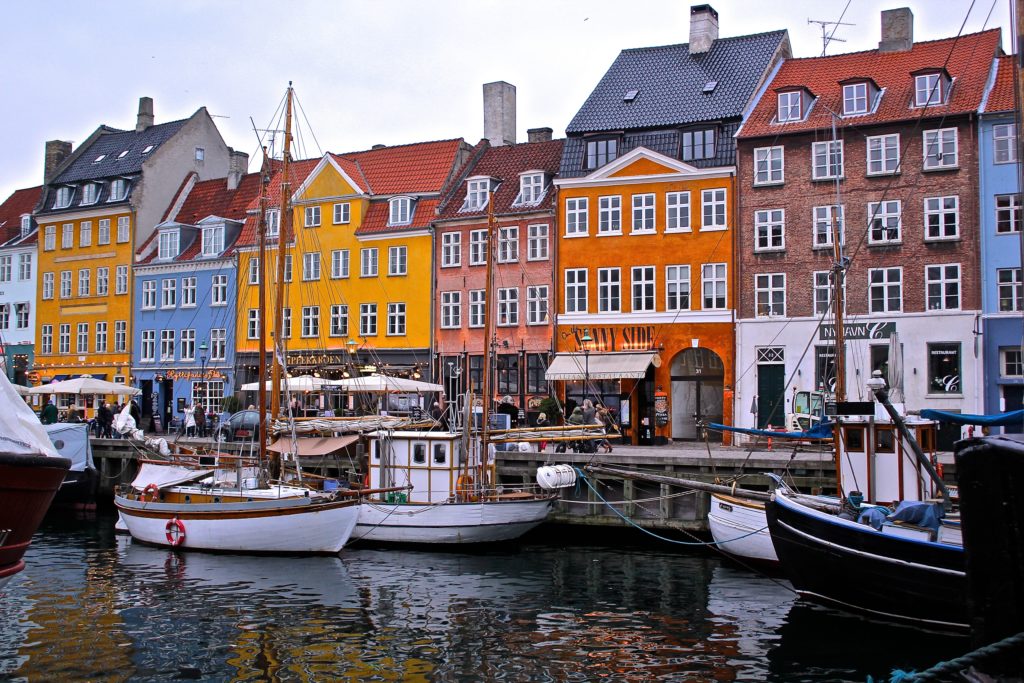
Daily cost: €161.46
I visited Denmark in my early twenties and it was so expensive I gave up converting prices and just decided I couldn’t afford anything. If I remember correctly, I ate supermarket sandwiches for dinner and washed them down with a coke zero. Très chic!
Stay outside of Copenhagen. This is notoriously one of the most expensive cities in Europe. I can personally vouch for that!

Daily cost: €133.63
I knew before I visited Iceland that it was going to be an expensive trip. The flight itself was a steal (Barcelona to New York via Reykjavik), offering a cheap stopover en route to NYC.
Iceland is expensive in terms of hotels, food, petrol and entrance fees. Even to visit the waterfalls you need to pay an entrance fee!
Road trip between destinations and travel with a friend to split the costs. Affordable hotels are available throughout the country, especially where there is more demand in Reykjavik.
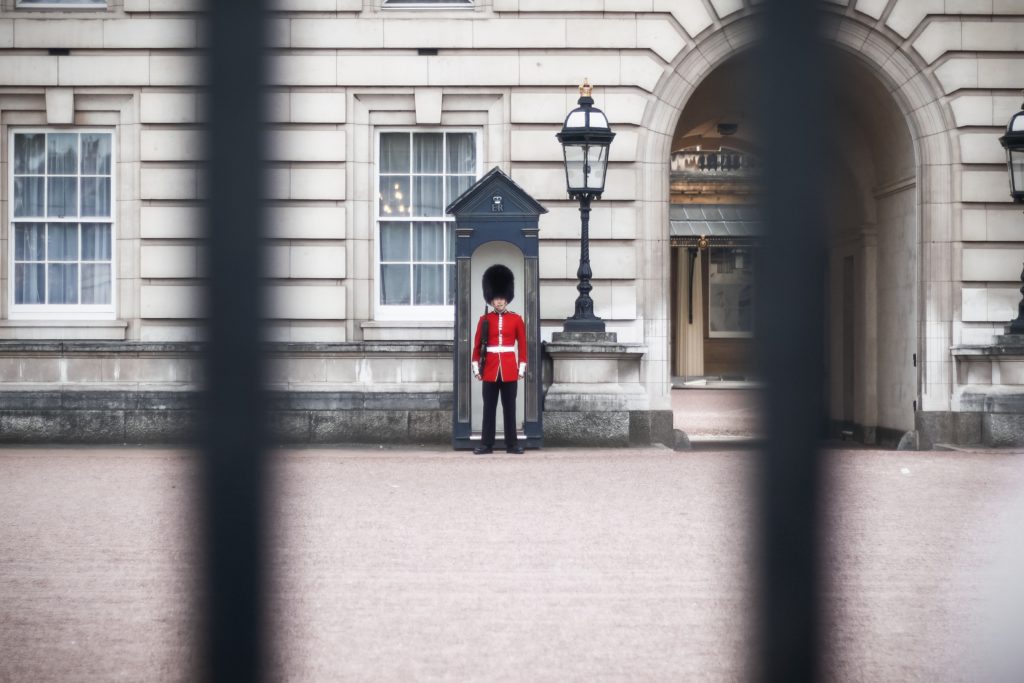
United Kingdom
Daily cost: €127.40
When you visit Europe for the first time it is highly likely London will be on your agenda. And for good reason! This iconic city is year after year the most visited city in the world. The main expense when visiting the United Kingdom is accommodation. It doesn’t help that the pound always performs favourably to most other world currencies.
Waitrose and Sainsbury’s are your friend. You can grab a quick sandwich snack to eat on the go and skip the expensive restaurants. Many if London’s museums are free, as are the parks and just walking around Soho will fill an entire day of entertainment. Other cities outside of London are much more affordable to visit.

Daily cost: €124.14
This one may come as a bit of a surprise to you, because with cheap pizza and house wines, how could it be expensive!? While the food is affordable, the price to travel through Italy quickly adds up. Cities like Rome, Venice and Florence are the most expensive.
Get outside of the touristic cities and stay in small towns. Instead of staying in Florence, try Lucca. Instead of staying in Venice, stay in Verona. You can always take a train and make day trips!

Netherlands
Daily cost: €122.66
When you think of the Netherlands , you think of Amsterdam. That’s normal! But I promise you there is so much more to the Netherlands beyond the city of Amsterdam. Besides, other cities are much cheaper to visit! The average price per day spent in the Netherlands is €122.66 . But you can easily save money with these few tips.
Check in to an Airbnb in Amsterdam or a local hostel if that’s your style. You can also save money by splitting the cost with a friend. Street food is readily available in major cities and is not only cheap but tasty!

Daily cost: €120.73
Finland is an expensive country to visit whether you’re in the capital, Helsinki , or further afield in small towns.
Try staying with a local family for a local experience. I stayed with a family in the lakes district and not only was it affordable but also gave me an insight into the local culture.
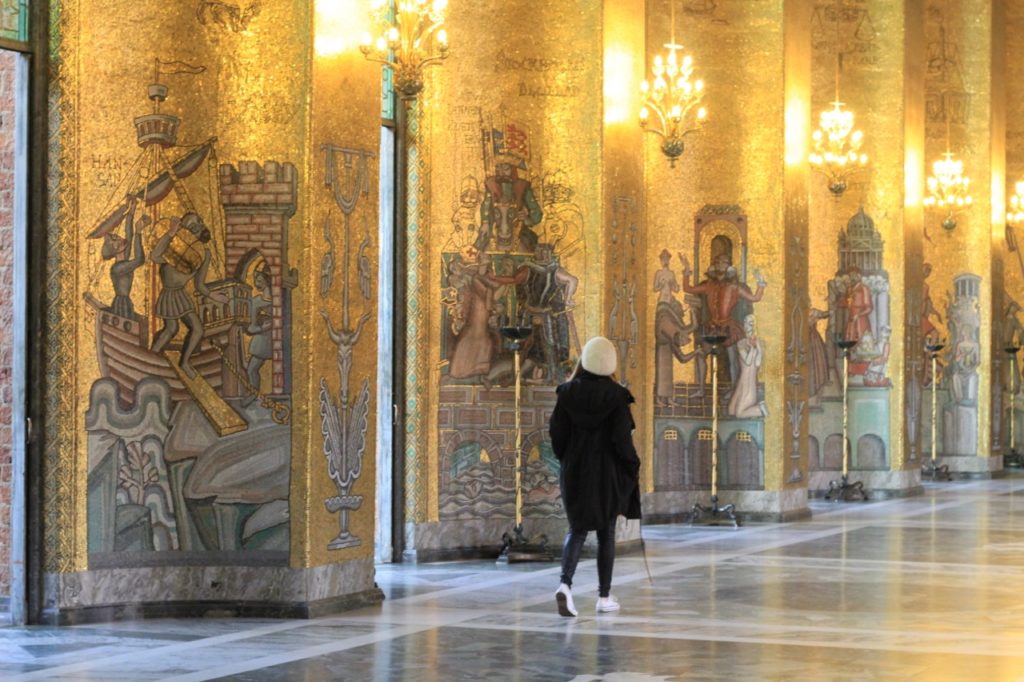
Daily cost: €112.67
The most expensive city to visit in Sweden is Stockholm. But don’t let that stop you! There are some great free attractions plus the public transport is easy to use.
Use the public transport and swap restaurants for cheap eats and supermarket lunches. If your accommodation offers breakfast, make this your biggest meal of the day.

Somewhere in the Middle
Daily cost: €111.96
Spain is reasonably expensive to visit but as soon as you exit the big cities (like Barcelona and Madrid) it becomes a lot more affordable.
Swap big cities for small towns. Indulge in tapas and kick back with a jug of sangria!

Daily cost: €110.33
Greece can be expensive but it doesn’t have to be. There are some great ways to save money, especially if you aren’t short on time. Local ferries are a great option for island hopping and they’re much more affordable than flying between the islands.
Use local transport to save on travel costs between the islands. It will take a little longer but it is the journey, not the destination that matters! If you are carefully considering travel costs in Europe, sometimes you have to sacrifice time to save money.

Daily cost: €109.47
Ireland is one of my favourite countries to explore in Europe. It is so naturally beautiful and sets the scene for a perfect road trip! As soon as you leave Dublin, the country becomes much more affordable to enjoy.
Road trips are a great way to see this country but public transport is much more affordable if you’re on a budget.

Daily cost: €106.78
Germany is in the heart of Europe, meaning it is really well connected with trains. This makes for a great adventure by land and will also save you money. The large cities like Berlin, Cologne and Munich are much more expensive than the countryside.
Swap the major cities for countryside escapes.

The Cheapest Countries in Europe
Daily cost: €18.75
Serbia is the most affordable country on a day-to-day cost analysis. If you are carefully considering travel costs in Europe, Serbia is a great option for budget travellers. Belgrade is a surprising city with so much to offer visitors and I can highly recommend it!

Daily cost: €23.00
Ukraine is another great choice for travellers considering travel costs in Europe. The local transport might seem daunting at first (as no signs are in English). However, you would be surprised how much you can converse with hand gestures and broken English!
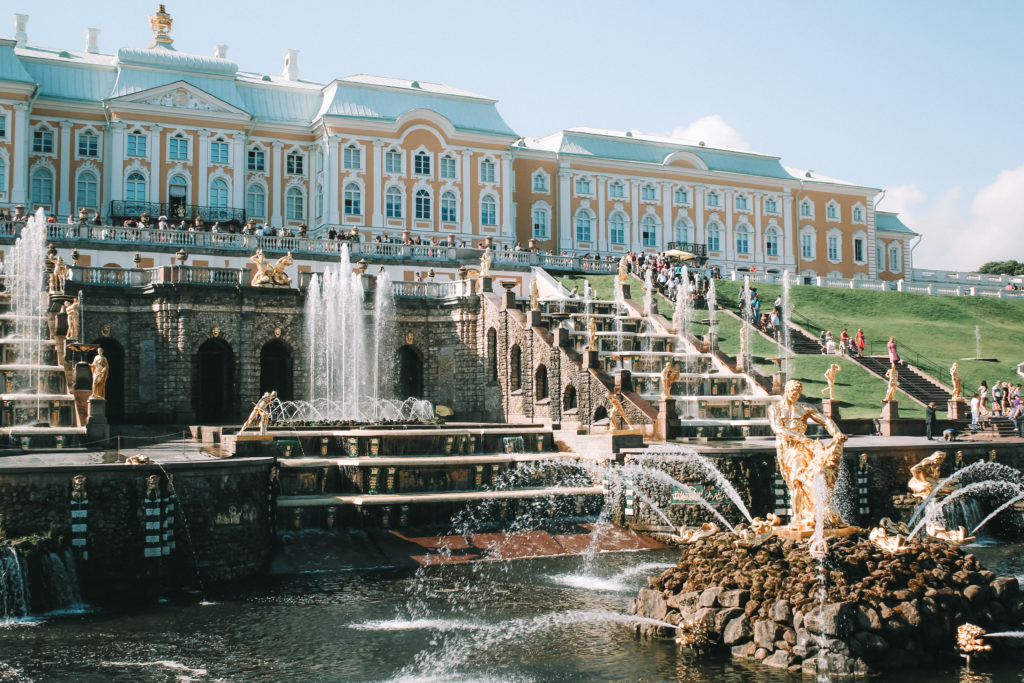
Daily cost: €38.92
Russia is one of the more affordable countries in Europe to explore, however Moscow and St Petersburg are still quite expensive. If you’re up for a real adventure, head out into the small towns and spend more time off the beaten path.

Daily cost: €41.31
One of my friends recently went on her honeymoon to Albania. It isn’t the ordinary first choice for a honeymoon but she said it was a great adventure! Albania is still one of the least visited countries in Europe. This makes it very affordable and quite underrated.

Daily cost: €51.04
Still in Eastern Europe, Bulgaria is a great choice for budget travellers. As you might have already noticed the more you venture East, the more affordable it becomes.
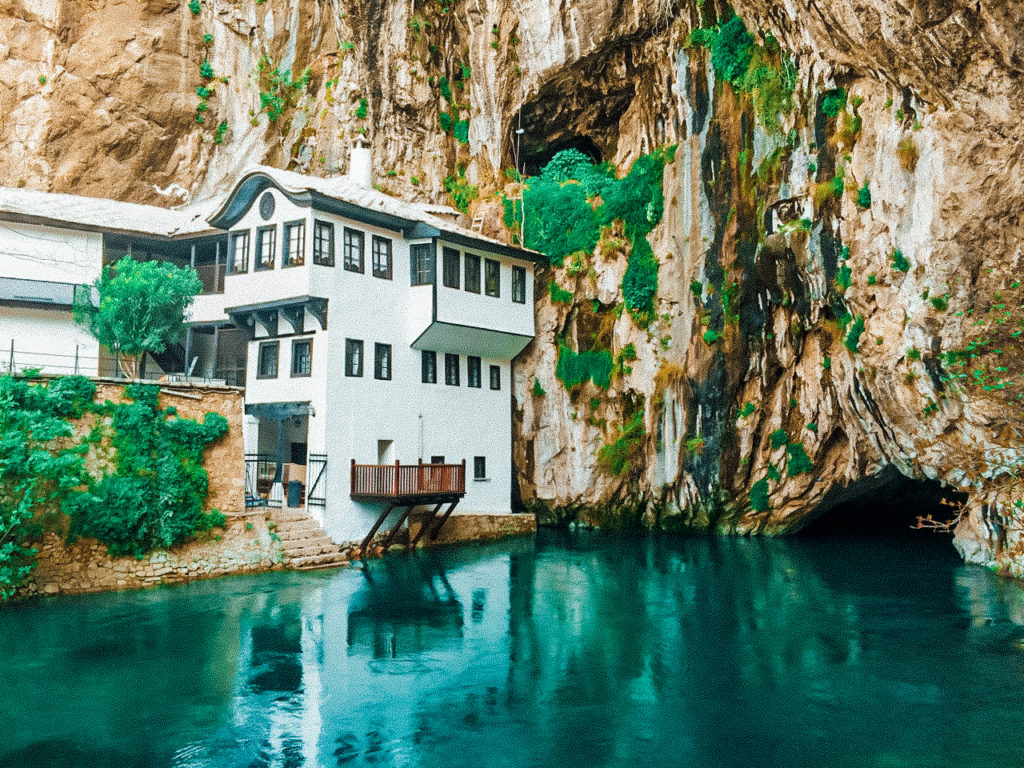
Bosnia & Herzegovina
Daily cost: €54.85
Bosnia and Herzegovina is one of my fondest travel memories. This country is so underrated and the locals are so welcoming to foreigners. To save money on my trip, I stayed with a local Bosnian family in Blaggaj. They were kind enough to cook me breakfast every day and even drive me to Mostar each day!
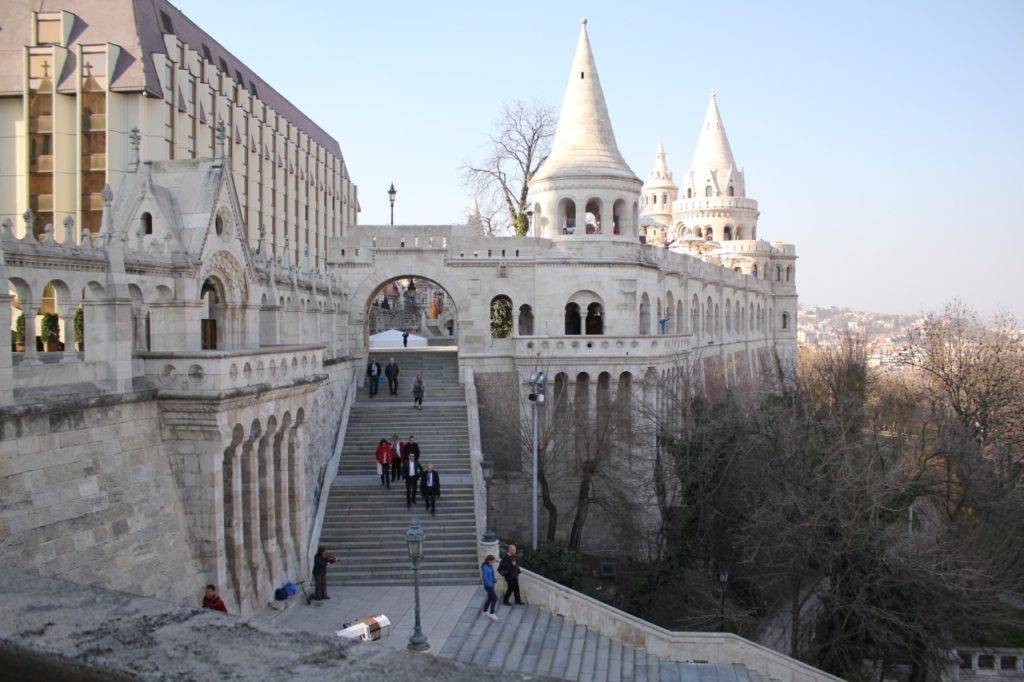
Daily cost: €57.68
Budapest has become one of the most sought after cities to explore in Europe. The capital city of Hungary has a high supply of accommodation, making it affordable to stay for a while.
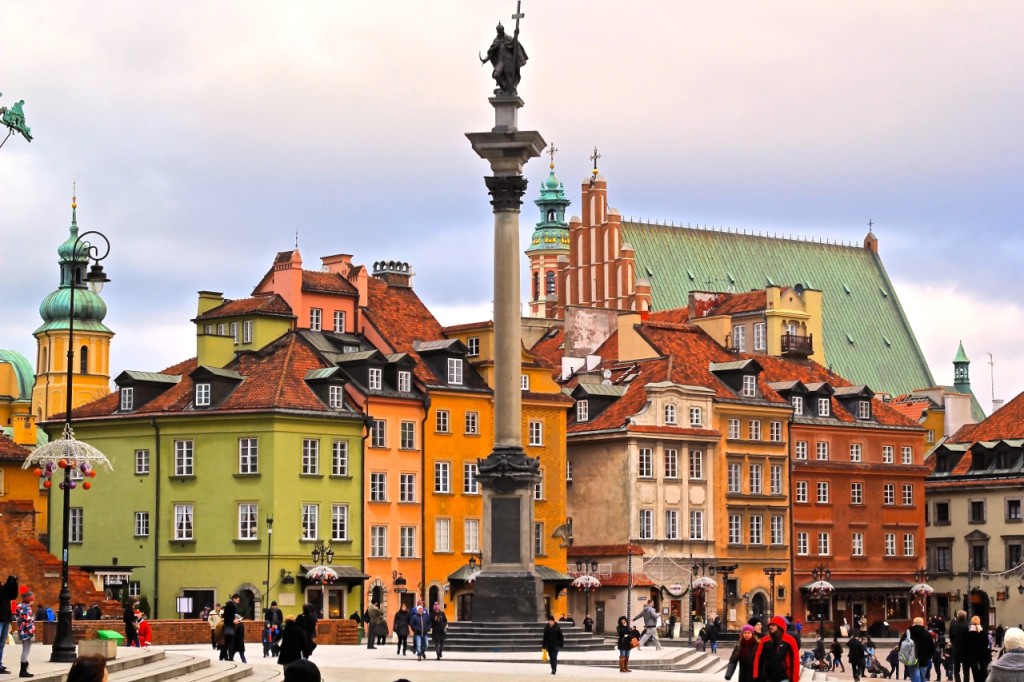
Daily cost: €58.58
Finally we round out our list with Poland. This country is often overlooked by visitors, although many travellers make their way to Krakow in the South. However if you make it all this way, I would strongly encourage you to spend more time in Poland! The capital city of Warsaw has been one of my favourite capital cities in Eastern Europe.
For more of my adventures, follow along on Instagram .
Brooke Saward founded World of Wanderlust as a place to share inspiration from her travels and to inspire others to see our world. She now divides her time between adventures abroad and adventures in the kitchen, with a particular weakness for French pastries.
Find me on: Twitter | Instagram | Facebook

Los Angeles
Plan a trip
First trip solo
Packing guide
20 Best Places for Solo Female Travel
Travel after a break up
20 Places in your 20’s
WAYS TO TRAVEL
Solo travel
Adventure travel
Luxury travel
Learn a language
Become a blogger
- Search Please fill out this field.
- Manage Your Subscription
- Give a Gift Subscription
- Newsletters
- Sweepstakes
- Destinations
13 Affordable Places to Visit in Europe — From Country Escapes to Stunning Cities
You can visit Europe on a budget — here's how.
Elizabeth Rhodes is a special projects editor at Travel + Leisure , covering everything from luxury hotels to theme parks to must-pack travel products. Originally from South Carolina, Elizabeth moved to New York City from London, where she started her career as a travel blogger and writer.
:max_bytes(150000):strip_icc():format(webp)/elizabeth-rhodes-25083778bc654f69b30ce8417affc82c.jpg)
If you have big dreams of jetting off to Europe, but worry that your bank account isn't quite ready, don't worry. For every expensive city, there are dozens of charming — and surprisingly affordable — places that offer all the European charm for a fraction of the price. Ljubljana, Porto, Budapest, even Berlin — these cities have all the rich culture, stunning architecture, and delicious food that you'd find in pricey European capitals, but they're perfect for budget travelers.
You can even travel to some of Europe's best (and famously expensive) destinations without breaking the bank — you just have to know how to save money without sacrificing on experiences. Travelers can often score deals on flights from the United States to major cities like Paris or London, and upon arriving, transportation within Europe can be much more affordable (hello, budget airlines). Those large cities also offer a wide range of accommodations, so you can certainly find something in your budget. You can even save money on food by hitting the local markets. After all, a bottle of wine, fresh bread, and cheese from a Parisian market make for an unforgettable meal when picnicking under the Eiffel Tower.
And you might be surprised by how many museums, churches, and other attractions are free or inexpensive to visit, too. Be sure to keep an eye out for free entry days (often one day a month) or tourist cards that offer entry to multiple attractions for one flat fee. (Do the math ahead of time by calculating the cost of every included attraction that you want to visit to make sure it's really worth the money.)
Trimming your budget doesn't mean sacrificing the quality of your trip. Sometimes, the less you spend, the more you can immerse yourself in the local culture. Staying in a thatched Irish farmhouse, perusing old masters in Rome, or snacking your way through Spanish specialties aren't just tricks of the frugal traveler — they're the stuff dream vacations are made of.
Here are some of the top destinations for an affordable European vacation (and tips for saving money once you arrive).
Bavaria, Germany
For a storybook-worthy vacation in Europe, head straight to Bavaria. Book a room at Burg Colmberg , a 14th-century castle rising from a rocky crag above a tiny village. It offers an eclectic collection of rooms tucked throughout a warren of crooked hallways, hidden staircases, and cozy sitting nooks. Be sure to visit the postcard-perfect Neuschwanstein Castle , resplendently perched atop a mountain, and take the time to tour Hohenschwangau, the castle in which "Mad King" Ludwig II actually lived. The latter is a more modest pile of battlements on a smaller nub of a hill in the valley below. What it lacks in the carefully crafted pomp and circumstance of Neuschwanstein — which Ludwig II never lived to see completed — it more than makes up for in homeyness and history.
Puglia, Italy
Michela Sieman/Travel + Leisure
The iconic architecture of Puglia — the "heel" of Italy's boot — is the prehistoric trullo, a cylindrical whitewashed house with a cone-shaped roof of stacked gray stones. There's no greater concentration of trulli than in the UNESCO-protected town of Alberobello, where whole neighborhoods are made of the structures, and the local entrepreneur behind Trullidea has fixed up dozens of the abandoned ones and rents them to visitors. Cool in the baking summers and with cozy indoor heating for wintertime, a rental trullo lets you live like a local for less than the cost of a tourist-class hotel in town. Want to sample what the Amalfi Coast was like before the hotshots and high prices moved in? Puglia's forested Gargano Peninsula is popular with sun-loving Italians, but is otherwise refreshingly off the tourist map.
Budapest, Hungary
Alisha McDarris/Travel + Leisure
The capital of Hungary, Budapest offers all the charm of more popular European destinations for a fraction of the price. The Hungarian Parliament Building and Fisherman's Bastion are just a couple of the picture-perfect attractions you'll spot in the city, and you'll find lots of affordable accommodations, meals, and nightlife, too. Even the city's famous thermal baths — some of which are over a century old and feature beautiful architecture — can be affordable to visit.
Andalusia, Spain
Rory Fuller/Travel + Leisure
Take a break from sizzling on the crowded Costa del Sol beaches for a self-guided driving tour along the route of the Pueblos Blancos. This string of clifftop, whitewashed villages stretches from the Moorish town of Arcos de la Frontera through the Sierra de Grazalema to Ronda, a maze of medieval streets perched above a 500-foot gorge. Opt for a stay in nearby Seville — the capital of Andalusia — to take in the beautiful architecture, watch some flamenco dancing, and indulge in classic tapas.
Berlin, Germany
Berlin has Cold War mystique, contemporary architecture, and booming gallery and restaurant scenes. With its cosmopolitan, East-meets-West edginess, it's no wonder the city has become a cultural capital of central Europe. It's a destination that continues to attract creative types and in-the-know travelers. Begin your trip to Berlin in the fashionable Mitte (or "middle") district, as it's convenient to major sites such as the Reichstag and Potsdamer Platz.
Bath and the Cotswolds, England
The charming villages of the Cotswolds look like they're straight out of a fairy tale — Chipping Campden, Stow-on-the-Wold, and Bourton-on-the-Water are among the prettiest. There are inns and pubs sprinkled throughout the little towns, but we'd suggest staying in Bath, a quaint city dating back to the Roman era, for its variety of accommodations. While there, check out the Royal Crescent, Pulteney Bridge, Bath Abbey, and of course, the historic Roman baths. Best of all, Bath is under two hours from London by train, making it an easy weekend trip from the city.
Istanbul, Turkey
Istanbul's major state-run museums may charge hefty admissions, but the Great Palace Mosaic Museum, just behind the Blue Mosque adjacent to the Arasta Bazaar, costs only 60 Turkish lira (that's about $4). These delightful mosaic scenes of hunts, myths, animal battles, and everyday life in antiquity — boys riding a camel, a man milking his goat — once covered the floor of a large courtyard of the Palatium Magnum, the Great Palace built between the time of Constantine the Great himself and Justinian I (fourth to early sixth centuries). You can even cruise between the continents for an affordable price when taking the ferry.
Ljubljana, Slovenia
Take a tour of the architectural masterworks of prodigious local talent Jože Plecnik, who took the Secessionist Art Nouveau style he learned in Vienna back home (via Prague) to remake his native city along his own, idiosyncratic lines. Like Gaudí in Barcelona, Plecnik designed his buildings right down to the smallest fittings, like the Pegasus door handles on the entrance to the National and University Library. Plecnik designed a bit of everything around town, from the central market to the two flanking spans of Ljubljana's iconic Triple Bridge to the café-lined embankments of the Ljubljanica River. The city also has a number of incredible, affordable restaurants, and you can take a public bus (for a small fee) to nearby Lake Bled for a day trip.
The Dalmatian Coast, Croatia
Skip the overexposed island of Hvar for the walled medieval village on the Adriatic island of Korcula, purported home to Marco Polo. Korcula is more of a day-trip destination, and that means the tourist crowds thin considerably by sundown, leaving those who remain to relax in the cafés and stroll the narrow alleys. While every old city in Europe has an Old City historic district, Split has the only downtown actually carved from the carcass of an ancient Roman palace. When the emperor Diocletian left his throne in A.D. 305, he built a lavish palace on the Croatian coast to live out his days as head of the empire's eastern half. In the 1,700 years since, the ruins of his enormous structure have been colonized by the locals, the buildings turned into medieval town houses, and the emperor's tomb transformed into the cathedral.
Paris, France
Want to experience fabulous French cuisine on a budget? Opt for a midday splurge — many cafés and restaurants offer less expensive menus at lunch. And a picnic is always a good idea in Paris. Stop by a market to peruse the (typically) extensive options for cheese and wine, or pick up a simple yet delicious crepe from a stand. If you plan to visit the City of Light's top museums and attractions, you might want to invest in a Paris Museum Pass . For one fee (priced depending on the number of days you purchase), you can gain admission to top tourist spots like the Arc de Triomphe, Sainte-Chapelle, Panthéon, Louvre, Musée Rodin, and more, and you get to skip the ticket line. Talk about a win-win.
County Clare, Ireland
Irjaliina Paavonpera/Travel + Leisure
Avoid the tour bus-clogged Ring of Kerry for its neighbor to the north, County Clare, home to the dramatic Cliffs of Moher rising more than 700 feet from the crashing Atlantic waves; the weirdly eroded limestone landscape of the Burren, where prehistoric slab tombs perch on the rocky flatlands like miniature houses of cards; and Doolin, a blink-and-you'll-miss-it village that has become a popular destination for traditional Celtic music. Local pubs are the perfect evening stop for hearty (and usually affordable) Irish fare and — if you're lucky — live music.
Rome, Italy
Daniel Gorostieta/Travel + Leisure
Rome has more than 900 churches, all of them free, displaying great works of art and architecture by the likes of Raphael, Bernini, Caravaggio, Bramante, and Pinturicchio. And that's just the short list of artists contained in one church — the little-visited Santa Maria del Popolo. Other iconic landmarks, like the Trevi Fountain, Spanish Steps, and Rome's famous piazzas are all free to visit, too, and some museums offer free entry days, so check their websites for details.
Porto, Portugal
Paula Galindo Valle/Travel + Leisure
Portugal's northern city of Porto is among Travel + Leisure readers' favorite European cities, and once you visit, you'll see why. In Porto, visitors can admire the Art Deco architecture, sip port wine, and explore the walkable city on foot without going over budget. Plus, a day trip to the Douro Valley, a picturesque vineyard region along the Douro River, is worth the trek.
Related Articles

How Much Does It Cost To Travel Europe?
Europe is a hugely popular travel destination. Whether it’s by foot, bus, plane or train, each year travellers flock from across the globe to visit and experience all the wonders of European travel. But how much will a European adventure set you back? How much does it cost to travel Europe ?
For me, Europe is a place of romance and intrigue. With such a long, rich history, and such diversity in people, architecture, culture, food and natural beauty, it’s no wonder it’s so popular among travellers.
Money is always a potential disadvantage of travelling , though. And, where Europe isn’t necessarily the cheapest place to explore, the question of cost is probably a big one for travellers heading that direction.
As a result, I thought it might be helpful to write a brief post about the prices involved with Euro-travel. Exactly how much does it cost to travel Europe? Keep reading to find out.
Necessary Cost Considerations
Before I go deeper into the Europe trip costs, there are a few things worth considering:
1) The amount you spend is up to you!
It’s true that some parts of the world are just downright cheaper than others. However, it’s also worth remembering that we have direct control of how much we spend. Wherever you are in the world, there are ways to travel on a budget. Cook more, eat out less, hitchhike, walk – whatever it may be, the travel choices we make overseas have a big impact on expenditure. Generally, if you’re willing to put up with a level of sacrifice, you’re able to keep the cost down.
Of course, the same is true in Europe, so the amount you spend will vary in relation to your particular style of travel. There’s no right or wrong way here: budget or luxury, it’s totally up to individual preference. Just keep in mind that it can have a big impact on how much you spend on the road.
2) Prices vary by country
When people refer to Europe as a travel destination it’s often easy to see it as one uniform location. But, obviously, Europe is a big place with lots of different countries in it (here’s a guide to the best backpack for exploring it!). And each of those individual countries has its own set of prices. The costs in Europe vary by country and some (especially in Eastern Europe) are far cheaper than others.
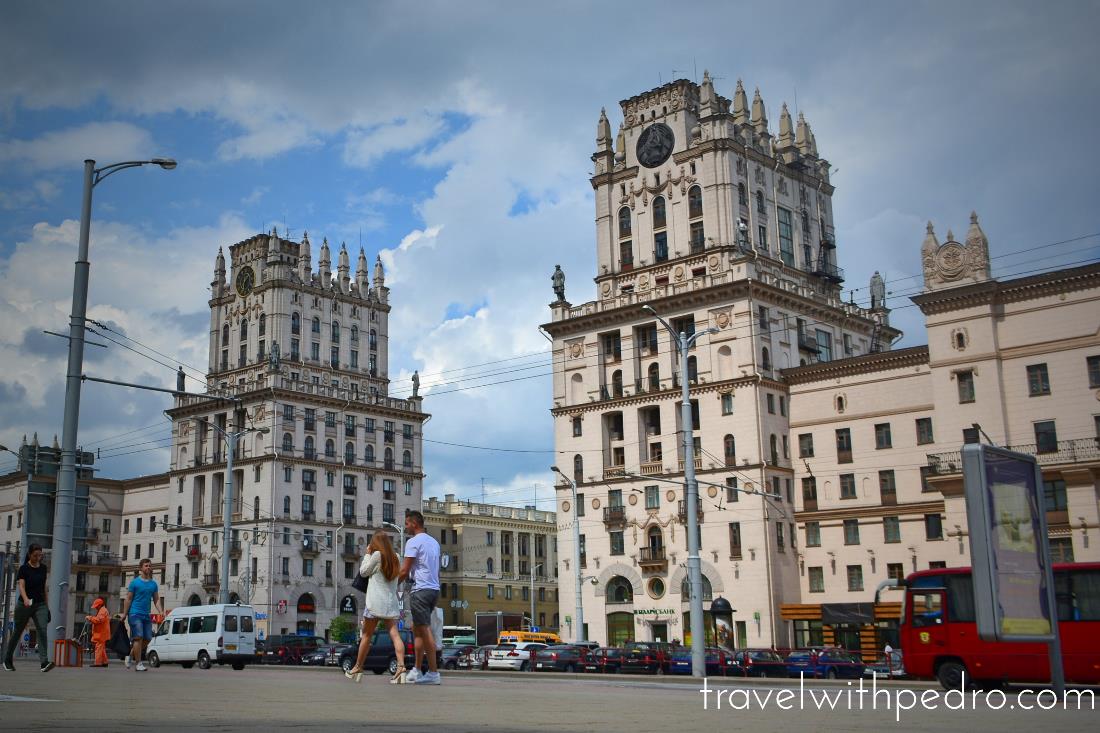
As a result, accurately costing a trip to Europe is never simple; it relies wholly on where you’re actually planning to visit. A person planning to move from Oslo to Helsinki , then on to London , Paris and Amsterdam, for example, will need much deeper pockets than someone heading to Warsaw, Minsk and Kiev. So, if you’re on a budget, it’s worth looking into the cheaper parts of Europe as a way to extend your trip.
3) Keep currency in mind
Like all travel, the amount of bang you get for your buck is tied to the going exchange rates. For instance, since the whole Brexit debacle happened, there’s never been a better time to visit the UK for someone in the US. The Pound has just been stupendously weak, which makes it far cheaper than in the past!
Likewise, for someone travelling to the US (or even some parts of South East Asia such as Cambodia, where the US dollar is now widely used) from the UK, it’s far more expensive now compared to 20 years ago.
In the same way, it’s now far pricier for a British person to travel around mainland Europe than it was in the past. The pound, though getting better, is not what it was. And this has a massive effect on how far your money goes.
So, depending on where you’re travelling from, make sure to check out the current, relevant exchange rates to really assess how much a trip to Europe will set you back!
These three factors are important as they make it nearly impossible to give an absolute figure for how much Europe travel costs. As a result, it would be misleading to try! However, what we can do instead is to go through some estimates, as well as some tips for keeping costs down!
The Cost of Travelling in Europe
On to the main subject then: how much does it cost to travel Europe?
Key points if you’re in a rush:
- Europe definitely isn’t the cheapest place to travel!
- Average cost: circa £45-70 per day all in.
- If you’re on a budget, spend longer in Eastern Europe.
- The price fluctuates by location, so make sure you research the countries you plan to visit before arrival and budget accordingly.
- General cost-cutting ideas: supermarket shopping, couch surfing, making use of happy hours, booking transport and accommodation in advance, utilise free activities in cities (museums, art galleries, city tours…).
- Cheapest forms of transport: hitchhiking, car sharing (Blablacar), bus (Eurolines, Flixbus, Megabus), plane (Ryanair, Easyjet, Wizzair; book in advance).
- Accommodation: will eat your money, but Couchsurfing is a good bet & in certain places (e.g. Greece in summer) you could free camp outdoors. Otherwise, hostel dorm rooms are probably the best bet.
- If you’re a student, remember to bring your student card (just make sure it’s an international one) as it can get you discounts!

Europe Travel Tips: Average Daily Costs
Based on online research and personal experience, the average Europe trip cost will be between USD$60 and $100 per day. In Eastern Europe expect to spend around two-thirds of that ($40 to $70).
It’s worth re-emphasising how these figures will always be a rough estimate! Remember, the amount to spend is generally up to you.
That said, with those figures in mind, here’s what a 2-week, 4-week and 8-week trip to Europe (not Eastern Europe) could cost.
- 2 weeks (14 days): $840 – 1400
- 4 weeks (28 days): $1,680 – 2,800
- 8 weeks (56 days): $3,360 – 5,600
So, overall, not cheap!
However, it’s always good to have a solid idea of how much something might cost you. From here, you can think about: how much you need to save; a budget for expenses on the road and think about how you might go about cutting costs.
Saving Money When Travelling Around Europe
Let’s turn to how to cut the costs where possible. One of the main expenses for European travel is getting between locations. Here are a few of the best ways to get around as cheaply as possible.
Travelling by bus is an increasingly popular form of transport in Europe. With budget services such as Flixbus and Megabus going to a huge number of different cities and countries, it’s well worth checking this method of getting from A to B. Price can be incredibly low. For instance, you can get from London to Paris for $18 on Flixbus. That’s insanely cheap!
Obvious downsides include the time it takes and potential discomfort of being sat for hours in a cramped seat. But the price has to be worth it for budget travellers.
Car Sharing
Car sharing is a great bet for convenient and cheap travel. Essentially, people already driving from point A to point B advertise their journey (on BlaBlaCar , or Facebook groups, for example) and then anyone wanting to take the same route can head to the website, search for the journey and pay for a spare seat at a price set by the driver. The prices are more expensive now than they were in the past, but still far cheaper than most other forms of transport. Also, by cutting down on the number of car journeys, it’s much better for the environment!
Eurail/Interrail
A hugely popular form of transport around Europe is by train, due to the awesome networks that operate between countries and cities, making the daunting prospect of intercontinental travel straightforward. Buying a Eurail pass isn’t necessarily cheap (from what I’ve seen, the cost is usually well over $1,000 for a few weeks), but will definitely save you money in comparison to buying tickets individually.

It’s also meant to be incredibly convenient. Equally, some people just love train travel and see it as a perfect way of getting from one beautiful place to the next! Depending on your ticket, downsides can include only having a set number of days in a particular place before having to get the train, as well as the occasional lack of seats and price ‘adds ons’, for certain journeys in particular countries.
In Europe , Ryanair, Wizzair and Easyjet can be a budget traveller’s best friend. Coordinate things in advance and you can get crazily cheap flights. However, prices vary dramatically, so get in early to avoid disappointingly expensive tickets.
Of course, flying obviously isn’t the best for the environment either! But when you’re on a budget, the cheapest option is usually a priority.
Hitchhiking
It might not be to everyone’s liking, but it’s free, so it’s undoubtedly the cheapest form of transport going. It’s true that there’s always a risk involved, but it’s not as high as your mum makes you think it is! Of course, there are horror stories, but generally speaking, hitching is an awesome way of travelling and meeting people along the way.
I hitched through Northern Greece and along the way met a couple of Greek guys who later hosted us for free, showed us around Athens and took us out for a meal!
Time to Wrap Up
So, how much does it cost to travel Europe? Unfortunately, it’s impossible to offer a solid answer to that question! There are simply too many variables to provide a realistic figure. However, one thing I can say is that it doesn’t have to be as expensive as you think. Equally, I hope the estimates above have helped provide an idea of how much money you’ll need for the trip.
Remember, those figures are meant as a rough guide. Variables such as exchange rates and the style you want to travel will make a big difference. With certain approaches to your trip, you’ll be sure to do it cheaper!
About The Author
Danny Newman is currently writing and travelling his way around the world in a bid to figure out exactly what he’s doing with his life. He’d love you to follow along with his journey over at What’s Danny Doing .
Pedro has travelled to almost 120 countries and has made his nest in London. He has also lived in Spain, Australia, the US, Georgia and Turkey. A former hotel management professional, he loves exploring local cultures, is now learning his 8th language and has a soft spot for the Middle East and the CIS countries.

Accommodations
As you can imagine, your Europe trip cost will vary greatly depending on your style and where you visit. I recommend budgeting $150 a night for your hotel, which works out to $2,100 for 13 nights. From hostels to luxury hotels, Europe gives you many options to easily find accommodations that fit your budget.
If you’re backpacking through Europe, hostels will probably be your choice of accommodation. If you decide to go that route, the average price is $15 – $20 a night. Alternatively, there are a lot of great boutique hostels out there that cost more but offer a better experience since they’re competing with hotels and Airbnb.
Recommendations: YHA London Central (London), Barnacles hostel (Dublin), The Flying Pig Uptown (Amsterdam), Goodmorning Hostel (Lisbon)
Mid-range hotels
For those who think $150 is expensive, I would argue that it’s on the cheaper end. The reality is that hotels are expensive these days, so getting one for $150 a night is a pretty good deal. Remember, this is just an estimate. In some European countries, some hotels will cost you more while others will cost you less. You can also follow my guide on how to save money on hotels .
Recommendations: Alhambra Hotel (London), Stauntons on the Green (Dublin), Hotel Nicolaas Witsen (Amsterdam), Hotel Excelsior (Lisbon)
Luxury hotels
There will likely be luxury hotel options regardless of what city you’re visiting. If you like the experience or don’t mind spending the extra money, you may want to budget another $200 – $300 a night. Your Europe trip cost will skyrocket if you’re going for luxury stays.
Recommendations : The Langham (London), Clontarf Castle (Dublin), Amsterdam Marriott Hotel (Amsterdam), Iberostar Lisboa (Lisbon)
Depending on the city, I sometimes prefer to use Airbnb. I’ve been able to find private apartments in good locations for about $100 a night. If you’re travelling with kids or family, Airbnb can be a great deal since you should easily be able to find a space that fits your entire party. I do admit that Airbnb has become more expensive over the years, but it’s still a good hotel alternative.
If you have the right credit card, you can save a fair amount of money on hotels. Americans should strongly consider the Marriott Bonvoy Brilliant American Express Card since you can earn up to 95,000 Marriott Bonvoy points and $300 back at U.S. restaurants as a welcome bonus . Canadians should consider the Marriott Bonvoy American Express , which gives you up to 75,000 Marriott Bonvoy points. That’s enough points for a few free nights at some hotels, which could easily have a value of over $500.
Local transportation
Since I assume you’re doing thee cities during this trip, you’ll need to factor in flights and/or trains to each destination. I’m also assuming you’re booking a multi-destination ticket, so you don’t need to backtrack. Realistically speaking, budgeting $400 for location transportation may be a bit high, but remember, you must also pay for trips to/from the airport, day trips, and any other public transportation you use.
Generally speaking, getting a Eurail pass won’t be worth it if you’re in Europe for just two weeks and visiting three cities/countries. If you’re going to neighbouring countries or taking day trips, buying tickets as needed is fine. That said, buying your train tickets well in advance (even before you depart) is usually worth it, as you’ll get better prices and a confirmed seat.

Attractions
This is where things can get tricky. Attractions aren’t expensive, but if you keep going into them, you will naturally spend more. First off, always do the free things in every city. That means checking to see if any museums or art galleries have no entrance fee. Note that even museums with an admission charge (including big, famous museums like the Louvre Museum in Paris) usually have a free day, so you must see if the timing works out.
Parks are always free, and quite often, simply walking around neighbourhoods is the best way to see a new city, and that doesn’t cost you anything. In Europe, there are also many free walking tours – well, you need to pay a tip – but that’s a cheap way to learn about the city.
Finally, check to see if museum passes will help you save money. Many cities offer something such as free entry into a bunch of attractions for a fixed price for a set period of time, e.g. 24, 48, or 96 hours. You would need to do the math to see if the cost of the attractions you’re interested in makes up for the cost of the pass.
If you plan to pay for some attractions or do day trips into the countryside to see some of the local landscapes, check to see if Klook sells tickets. Buying your tickets in advance usually means you can get a small discount and skip the lines when you arrive.
Food and drink
The food and drink budget will vary by person, but a rough estimate for a meal, including drinks is as follows:
- Breakfast – $5
- Lunch – $10
- Dinner – $30
That works out to $45 per person per day, which some people think is too much, while others think it’s too low. If you like to drink alcohol, you’ll need to budget more. What I personally try to do is balance eating street/fast food with restaurants. I also go to grocery stores to get breakfast and snacks, which saves me a lot of money. Cutting back on eating out will help you see Europe on a budget.
Every city and country you visit will have some local delicacies which I highly recommend you try. To this day, I’m still mad at myself for not having tapas in Spain because I thought it was too expensive. I’m not suggesting you blow your budget on food, but it’s okay to splurge occasionally. Even then it doesn’t need to be fancy. A baguette and cheese in Paris is pretty cheap but also delicious.

Random spending
Many people forget to include shopping when planning their vacation budget. It’s silly to think that you’ll spend nothing on random things; you’ll buy gifts for people, right? Plus, you’ll want to pick up plenty of souvenirs for yourself, regardless of how tacky they appear. There’s nothing wrong with buying gifts for yourself or friends; you just want to make sure you budget for it.
As you can imagine, some cities have better shopping experiences than others, so you must consider where you’re going and budget accordingly. For example, you may be headed to Italy and intend to buy a leather purse. There’s nothing wrong with that. Just make sure you’ve set aside some money for that purchase.
As a general rule, you should set aside $200 or 200 Euros for those random expenses that come up. Heck, even spending some extra money on sightseeing can be worth it.
Cost to go to Europe
So how much does it cost to go to Europe for two weeks? You know the answer – it depends! But, a good estimate is about $4,280. One time I spent just $2,300 because I focused on doing it for as cheap as possible. Another time I spent closer to $8,000 (for two people) when visiting just three cities. The cost of a Europe trip depends on you, but it’s not hard to stretch your travel budget.
For more European inspiration, check out my guides to Scotland , Italy , Croatia , Austria , Malta , Greece , and Amsterdam on a budget .
Frequently asked questions
Is it possible to see europe on a budget.
Absolutely! But it will take some planning. The biggest thing to remember is what countries or cities you visit. Places like London, England, Paris, France, Copenhagen, Denmark, and Florence or Milan in Italy will cost a lot more than places like Romania, Poland, Bosnia, Slovenia, and even Croatia. There are also several other ways to help cut costs and see Europe on a budget, even in the pricier destinations. Take a look at my Europe on a budget article for more tips and advice on how to see and do more for less.
Is it safe to backpack Europe?
Generally speaking, yes. This is somewhat of a blanket statement as Europe is a huge place and different countries and even cities will have some not-so-savoury places that are best avoided. But that’s the same everywhere. Some cities are very backpacker-friendly, such as Berlin, Zagreb, Luxembourg, and Munich.
You should be fine if you travel smart, follow basic safety protocols, and trust your gut. At the end of the day, use common sense. Don’t go to a bar with strangers and get black-out drunk. That’s not a good idea anywhere.
If you are uncomfortable or unsure about doing it yourself, you can always book a package tour or even a cruise. However, these will dramatically increase your costs and don’t allow for as much flexibility.
Are rail passes worth it?
It depends. Rail passes, such as the Eurail Pass , can be great because they take out a lot of planning and leg work and make it easy, but you pay for that convenience. Oftentimes there are more affordable transit options that are just as comfortable. Many countries have slower local trains that you can take advantage of. In some places, like Ireland, the bus system is better connected (and cheaper) than trains, etc.
If you are trying to figure out how much does it cost to go to Europe because you are on a tighter budget, it’s worth taking the time to do a bit of planning and do it on your own. If money isn’t an issue and you are more concerned about convenience, then a rail pass might be worth it for your Europe tour.
What are some fun things to do in Europe?
Europe is a popular destination for North Americans because it’s so different from here in many ways. The history and architecture are incredible; it’s wild to think some buildings are centuries older than Canada. Food is another huge perk to travel in Europe. It’s so varied across the continent, and while we have plenty of food options from different cultures in Canada and the USA, it’s always better from the source.
You may also be interested in visiting Europe for specific events. Perhaps St. Patrick’s Day in Ireland, or Carnival in Venice, or the Christmas markets of Germany. Don’t worry about finding things to do in Europe, and there’s plenty.
What are the best places to visit in Europe?
This depends on your interests. Are you interested in history? Maybe cities like Berlin and Vienna will be the most interesting for you. Love art? Perhaps Paris is the best option. More into beaches and nature? Try Croatia. Some people have dreamt about the canals in Venice and the Leaning Tower of Pisa, so they make Italy their priority.
What are the five most important tourist attractions in Europe?
It depends on your likes and interests. What is interesting to me might not be interesting to you. That being said, the most popular tourist attractions in Europe include:
- The Eiffel Tower in Paris
- The Colosseum in Rome
- Neuschwanstein Castle in Germany
- The Acropolis in Athens
- Stonehenge, England
- Aurora Borealis in Iceland
What are some unusual things to do in Europe?
Europe has plenty of weird and wonderful things to do that you wouldn’t necessarily find in North America. A few recommendations include the following:
- Visiting Sedlec Ossuary just outside of Prague (It’s made of human bones)
- Eat haggis in Scotland
- Attend a Krampus Run in Austria (Krampus is essentially a Christmas demon that kidnaps and tortures children. Like an anti-Santa)
When is the best time to go to Europe?
This can depend on your goals and the destination itself, but generally speaking, the shoulder seasons (September/October and April/May) are great. It’s not too crowded, the weather is pleasant, and you can avoid peak season costs.
How long can I stay in Europe?
While many backpackers love to do European tours, you need to be mindful of the amount of time you are allowed to spend not just in a specific country but in an area. Many European countries are part of the Schengen Zone, and Canadians and Americans can only spend a total of 90 days within a 180-day period in these places. Examples of Schengen zone countries include Austria, Netherlands, Spain, Poland, Italy, Iceland, and more.

About Barry Choi
Barry Choi is a Toronto-based personal finance and travel expert who frequently makes media appearances. His blog Money We Have is one of Canada’s most trusted sources when it comes to money and travel. You can find him on Twitter: @barrychoi
128 Comments
Great post. Our vacation plans for this year is to go to Denmark and Sweden. I heard that Scandinavia is really expensive. I found airline tickets for $1,600 for 2 people. Still looking for accommodations at Airbnb. My plan is not to go over our budget of $5k for our 11 day trip.

I’ve actually heard Scandinavia is expensive so let me know what the real costs are after. The good thing is, flights to Scandinavia have never been cheaper. You can get cheap flights if you fly via Iceland and I’ve also seen cheap airfare on Noreweigian.
Hi Barry! I’m planning an all girls trip (around 6 girls) to Europe from Pakistan. Which countries/cities would you recommend? Also we all have a budget of $2500 per person. Do you think it would cost less on accommodation as the cost would split? And would love if you can give some tips?
So I recommend talking to your girlfriends and asking what cities/countries they’re most interested in first. From there, you can try to figure out logistics. Your flights will be the biggest expenses. If you fly into one city and out of another, you won’t need to backtrack. E.g. fly into Paris and out of London.
As for accommodations, since there are 6 of you, you could look for a hostel that has rooms for 6 – 8 with a private room. If you buy out every bed in the room, you’ll have the entire place to yourself. That will likely be cheaper than getting 2-3 hotel rooms each night. You could also look for an Airbnb that accommodates 6, but that might be tough.
$2,500 a person is doable (depending on the destinations) and how long you go for, but I always recommend budgeting extra. This sounds like a really fun trip for you and your friends, the last thing you want is to be watching your budget the entire time you’re there.
Hi I’m from south Africa and I’m looking to travel to barcelona for 2 weeks.
I’m a student so I’m looking for as cheap as possible but I dont want to miss out on anything.
I have a friend living in barcelona so accommodation is already paid for which is a big expense luckily.
We are looking to travel to Greece and Amsterdam during this time.
Was wondering if I take 2000 euros if that would be enough for the two weeks.
Kind regards Jonathan
Hi Jonathan, if you’re staying at hostels or inexpensive accommodations when you’re in Greece and Amsterdam, that should be enough. I’m assuming your flight isn’t part of that 2000 Euro budget.
Nice post but the airfare costs seem to have gone up from your estimates.
Lowest price to Germany from Toronto was $1000 and that was a deal where you are estimating $850 CDN. Plus $200 travel insurance.
Hey Heather,
Yes flight prices have gone up this summer. I expect them to drop during the fall, but I haven’t researched it thoroughly yet.
Thanks, Barry! You always have the best budget/travel advice 🙂
[…] is one of few places that actually has a decent choice of accommodations that won’t burst your travel budget. Hostels are always a favourite among solo travellers, and there are plenty to be found around the […]
I know this is a little old of a thread. I was able to backpack europe with a friend, and only staying in Airbnb. 980$ is what was spent on lodging. We were gone for 4 weeks. The total trip was $5,000 which included souvenirs, trains, rental cars, ferries to the Greek Islands and 4 flights. Two were one way tickets from JFK to Paris, then London to JFK. One of the flights was also $400 from Croatia to Greece. Some of the trains and ferries were accidentally booked first class (which after doing so, I recommend).
Thanks for sharing. Europe can definitely be cheaper if you want it to be. My prices were rough estimates with hotels in mind instead of Airbnb. I love how travellers can see Europe on any budget and as you mentioned, they may still get the luxury experience unintentionally.
Thanks for putting this site togehter. Im planning for a trip to Budapest and Athens, 1 week each, the first 2 weeks of October. Is it still tourist season at this time? Some say prices only drop mid way or end of October. Can you confirm or deny this?
October tends to be slower for Budapest, but depending on where you go in Greece, parts may still be busy since it’s now cruising season in Europe
Thanks for the rapid response, I’m planning on Athens since I’m greatly interested in the historic sites. Not going to any islands like Crete, Rhodes etc. Also out of interest a question if you don’t mind: do you think the recent economy stabilisation (although it probably won’t last long) will change the price of visiting Greece?
Generally speaking, October is the lower season, but since Athens is so popular, it’s not like you’ll see NO tourists, it’ll still be busy. As for their economic situation, I don’t there will be much change as their economy has been tanking for years without prices at hotels or restaurants falling.
I am planning a Euro trip from Canada. I am intending to visit Croatia, Amsterdam and France if possible London. My budget for me and my wife is 7000 USD.
Any advise is much appreciated. Such as where to start and end must visit places and best time to go.
With that budget, you should have no problems seeing those countries. London, Amsterdam, and Paris are quick train rides away from each other. Although Amsterdam and London can be a bit pricier, during the fall, you shouldn’t have many issues finding a reasonably priced hotel. Paris can be inexpensive if you choose a hotel outside of the main areas, just find a place near the metro.
Adding Croatia gets a bit tricky since it’s not really close to the other countries. THat being said, you can find discount air carriers from London, Amsterdam, or Paris to get there. Most people who visit Croatia see more than just one city which is why you need to decide how much of the country you want to see when planning your trip.
Hello! I’m planning out a ways (gives me something to look forward to) for Europe in spring, 2021. We’ll start at a friend’s relative’s in the Black Forest, then on to Paris by train, then Italy by train. Goals are Rome, Florence and Venice. I’m very excited, as I’ve never been to Europe. With staying free the first few nights in Germany, and then four of us sharing AirBnbs, I’m thinking (depending on airfair) that we might be able to do this for around $2,500 each. That’s the goal. I love the idea of looking for special food everywhere we go. In Puerto Rico, we ate the fried plantains, and I enjoyed those. Not sure what tapas is, but hope you get to go back and eat it!
That sounds like a reasonable budget since you have some of your accommodations covered. As for tapas, it’s basically small plates meant for sharing. I actually went back to Barcelona earlier this year and splurged on tapas this time around. It was worth it!
Good for you. Thanks for the tips. Anne
Hi there, I’ll be visiting Europe for 9 days in Feb-Mar flying directly from Newark to Rome, from there to Paris and end the trip in Madrid. On airfare I spent USD 500, in lodging thru AirBnb and hotels a total of 225. I was wondering how much money should I expect to spend on attractions and food? Note: the amount mention above is per person and we are going to be 6 people in total. Note 2: thank you for reminding me to have a category of random expenses!
How much you spend on food is really up to you. Generally speaking in Rome you can get takeaway pizza, sandwiches, or pasta for 5 – 7 Euros per person. Sit down places will probably cost you 10 – 15 Euros per person. I rented an apartment when I was in Rome last and saved a bunch by stocking up on water, drinks, and alcohol from the grocery store. That being said, food in Rome is EXCELLENT so you could easily end up spending more if you want to try more things. I ate gelato twice a day because it was so good there. I wasn’t even hungry, I just wanted it! I STRONGLY advise checking yelp or tripadvisor before dining at any restaurant as the quality can vary quite a bit. Be sure to ask your host for recommendations.
The costs in Paris will likely be similar to Rome, probably a little cheaper (wine is cheaper than water). I haven’t been to Madrid so I can’t comment there, but I would suggest splurging on tapas one day.
Random expenses ALWAYS come up which is why I always budget a little more.
Planning a 10-11 day vacation for family of three( two adults one 7year old) in July 2019 to London, Amsterdam and Paris planning for a 7000 budget. Does this seem reasonable? Round trip from lax to Heathrow are about 2400 planning on doing Airbnb and we are not shoppers. Most likely spend on food, drinks and attractions. First time big vacation so exited!!!!!! Any feedback would be appreciated
That sounds more than reasonable assuming you’re not staying at hotels that cost you $1,000 per night =D. In Paris, it’s easy to find cheaper accommodations. London hotels can be pricey, but there area areas that are more reasonable. Amsterdam tends to be expensive in general unless you stay in Amsterdam SOuth and the take the train into the main areas. That being said, with your budget, you can likely find hotels in good locations.
We are going to Budapest, Kiev, Chisinau, and a couple stops in western Europe (Paris and somewhere else) in June, 2019, for about 23 days. International tickets aside, and with free lodging in Kiev, do you think $50 per person per day is reasonable? Two adults and one 17 ye old are our ages. We are not backpacking and we feel too old to sleep on someone’s couch for three weeks. Thanks for your input.
Does that $50 a day include accommodations? If not, that’s probably way low for an estimate. Food alone will cost you $50 if not more per day. You also need to factor in local transportation, attractions, and any souvenirs you may buy.
Thank you for this article. I am planning an European vacation for next year during the summer, Our trip can be any time between the months of July and August, there will be three of us, myself and my two daughters, 18 and 12. My budget is about 20,000 USD, I´m going to try to make it as long as I can stretch it, maybe 3 weeks, could it be stretched to 4?. I am not sure where exactly to go, I am thinking England, Paris, Italy for now, but that might change depending on where we can fly in and out of the cheapest. I guess my questions are, given that summer is the most expensive time to travel, which cities would you recommend traveling into and out of? I´m in the east coast. Also, I have read about hostels and I’m aprehensive about using them with my daughters, what is your take on them? Another concern of mine is traveling with my daughters, with me being a woman, are there any cities I should stay clear off because of crime? Any help, guidance is greatly appreciated! Thank you!
Hi! Im playing on going on a 16 day eastern european trip to several countries with a budget of around $2500-2700. I plan to save a lot by going to grocery stores and using airbnb. However, I will be going in the wintertime when the world junior ice hockey championship is so the tickets of a couple games might cost $50-100. Is this a reasonable budget for 1 person?
It can be done, but your flights and accommodations will eat up a lot of your costs. It also depends on how many countries you plan on going to. If you’re going to do Airbnb, try renting a private room as opposed to a private apartment since they’re cheaper.
Is it reasonable to expect to find a ticket to Greece or Italy for the $650 estimated price if we book now for July? I haven’t flown much so not sure, but looking at prices from US on Google seem to be more in the $1000-1500 range. Do I just not no where to go for a reasonable deal on a ticket? Any help is appreciated.
July is the summer so prices tend to be higher. For whatever reason, it’s usually a bit more expensive to fly into Greece as opposed to other destinations within Europe. It might be cheaper to fly into a major hub such as London or Amsterdam and then catching a discount carrier from there.
Note, sorry, I just realized I commented on the wrong place before. I apologize.
That budget is pretty healthy so I think you’ll do alright. Here are some things to consider. Have you talked to your daughters about where they want to go? It may be worth letting each daughter choose one destination or country ad then you pick one. That will give you three spots to build your itinerary around. I do believe you could stretch our your itinerary to 4 weeks as long as you don’t go all out on everything. That being said, even at $250 USD per night for hotels, you’d only spend $7,000 for 28 nights.
Figure out your destinations first and then you can work out flights. Getting to Europe will be more expensive in the summer, but getting around once you’re there is realtively inexpensive due to discount carriers.
Hostels can be okay to save money, but again, your budget is quote high so you’d be better off getting a hotel. ALternatively, Airbnb can be a great option for 3 people. That being said, some hostels have private rooms that sleep 4 and have their own bathroom so they might be worth considering. I just think it would be better to use Airbnb.
As for crime. I don’t think it’s fair to say one city is more dangerous than the other. You should obviously do some research about local scams and find out if certain areas are less safe than others, but use common sense when you travel e.g. don’t show off valuables, don’t walk down dark streets alone.
Thank you for your quick response! I will definitely ask my daughters to pick a city/country they want to visit, and then go from there. I´ll also be reading more of your posts to help me along, and will be asking you questions as well,
Hi, I am trying to plan a 15 day trip (not counting 3 days for travel to and from the United States). We want to spend 3 days in Amsterdam, take a night sleeper train to Munich on night 3. Spend maybe a half day exploring Munich before heading to Italy for 5-6 days. From Italy we want to travel to France for 2 days. From France we will travel to Spain for the last few days and fly home from there. Its myself, my husband and our teenage children. I will probably only have between $10,000-$11,000 for our trip, our flights would not be coming out of that. Normally when we travel, we do bananas and oranges for breakfast to save money but we’ve only traveled in the US so I’m not sure how that would work. Is a trip like this doable on that budget?
It’s probably doable on that budget, but I think you’re packing in too much. You have 15 days and you want to go to the following:
Amsterdam Munich Italy (where I assume you’ll go to more than one place) France Spain
You’ll essentially be on the road every 3 days which is crazy busy. Based on your itinerary, Munich seems like the easiest destination to drop. I’d also even consider dropping Spain so you can spend more time in Italy and France.
There are plenty of grocery stores in Europe so you can eat for cheap for breakfast if you like.
Hi Berry, thank you for your reply. Originally my plan was Amsterdam, Italy and Spain but the sleeper train from Amsterdam to Germany makes since so we can sleep while traveling so we aren’t really losing time there and my husband wants to see France over Spain and its closer to Italy so I guess Spain is out. Yes in Italy we want to do Venice and Rome.
ALthough you would save on accommodations and technically travel, you’re still adding another destination. Right now you’re looking at:
Amsterdam Munich Rome Venice France
This is all in two weeks. Are you going to skip Florence? How much of France are you planning on doing?
Hello Barry!
My husband and I are planning a trip to Europe this summer around July for two weeks. We’re budgeting about $4000 (or a bit over depending) each person and want to visit at least 4 cities while we are there. Our top picks are London, Amsterdam, Paris, and somewhere in Italy! Is it doable with our budget? And will we have enough time in each city? We’re flying out from LA and wondering where we should start first. I think a lot of people fly out to UK and start there. Would that be the best course? And flights look most expensive in July and August. Will we be able to plan something in June or is that too soon?? (It’s almost April already) sorry I just bombarded you with so many questions. Any help is appreciated!! We’re super excited and want to make sure we get the best scenario for our trip!
I second this question from Gloria please!
We have 14-15 days and right now thinking spain, italy, france. Leaning towards warmer time of year where we can maybe go to a couple beaches. However we are open to weather in 60s or above. How soon in advance should we be booking this trip? Any suggestions would be greatly appreciated!
Yikes, I don’t know how I missed Gloria’s question last year.
With 14-15 days, I personally would stick to three locations at max with maybe a few day trips on the site. You could easily spend 14-15 days in each of the three countries you’ve listed. I personally recommend going with what your top priorities are. If you want beaches, Spain and France are probably your best bets. Maybe start in PAris, head to southern France and then make your way to Barcelona where you can fly home? I would save Italy for another trip where you do that country on its own.
Hello! My boyfriend and I are leaving May 9th and returning on June 5th (27 days). We are going to London (staying with family), Brussels, Bruges, Munich, Vienna, Salzburg, Interlaken, Milan, Barcelona & Madrid. We booked all of our hostels & aribnbs, bought the eurail pass and paid for our flights. How much should we bring with us for food, attractions, etc for those 27 days?
It really depends on how many attractions you want to see and if you’re foodies or not. Many attractions (especially in London are free), but you could also spend 10 – 20 Euros per museum which adds up quickly. Be sure to do your research to see what’s free and pick one attraction in each city that you’re willing to pay for. Food can be cheap if you visit the grocery store your entire trip and make sandwiches, but that gets boring fast. Between the two of you, you could spend $20 – $100 a day depending on what you like to eat. That being said, many hostels offer free or cheap breakfast so you won’t need to buy every meal.
I think we planned on doing a grocery store breakfast, street food for lunch, and a sit-down/casual meal for dinner. Naturally, we are trying to stick to free attractions. We both enjoy doing things on our own but definitely will at some point pay to get in.
I think we were each planning to bring $3,000 for 27 days ($6,000 total). This would be for food, miscellaneous transportation & attractions. Do you think this is enough? We don’t plan on living lavishly but also not living like “bums” 🙂
I truly appreciate your reply. I have been reading your articles and you are fantastic. Thank you for your advice!
Hey Audrey,
I think that’s a great budget and you’re being smart about your meals. One piece of advice, don’t save just for the sake of saving while there. Enjoy this month with your boyfriend. I personally would rather save money at home where I skip coffee/snack breaks and pack more lunches. You should be able to enjoy as much gelato as you want in Italy guilt free.
Don’t forget to factor in spending on things such as local transportation and souvenirs. You won’t spend a ton on that stuff, but it’s something many people forget to account for.
Hi, i’m planing to travel to Europe next year around Easter time with my teenage son for 2 weeks, our plans are to visit Barcelona, Madrid (soccer game) Paris and Italy, i estimated $6000 for our budget , planning on using Airbnb and trains and lot of walk , which it could be the more economic order to visit those countries?
Hi Alexandra,
Booking an award flight for 4 persons is challenging.
Hawaii being a popular vacation destination, finding award seats can be difficult. I would suggest to set up price alerts for Hawaii flights as this is a very competitive route. It’s often a better value to pay for the flight than using miles.
As for Asia, the biggest challenge is to find the transpacific flights. But if you book well in advance and are flexible on your dates you can find 4 award seats in business class on Air Canada to several destinations in Asia. You can also often find availability on Air China if you don’t mind a layover in China. United could also be a solution for some routes via one of their major hubs like Chicago, Houston, Washington or San Francisco. Finally, you can be lucky and find flights on EVA directly to Taiwan as they fly to Toronto, Vancouver and several US cities.
Once in Asia, you will have more options since there are more Star Alliance airlines to choose from including Asiana, Singapore Airlines, Air Nippon and Thai Airways. Finding availability is also easier since there are more flights and some airlines like Singapore Airline releases more business class award seats for short hauls than they release for long international flights.
Note that since Aeroplan search engine has limited capacity for long and complicated itineraries, you will have to search for each leg one by one as one-ways to see if there is availability.
In conclusion, it is possible to make such a trip for 4 people in business class, but it will require a fair amount of preparation and luck!
It depends on where you’re flying from and what direct routes you have available. Paris, Rome, and Barcelona are all major hubs so it might not be that difficult to figure out a route. You also need to factor in if there’s a certain date you need to be in Madrid for the soccer game.
Hi there! I came across this post while trying to research info about traveling to Europe. My 2 friends and I are trying to plan a trip to France, UK, and possibly Austria within 8-10 days in mid-December. We’re trying to figure out about how much the trip might cost for each of us if we are able to stay with people we know at these destinations. We threw around the number $2000-2500 USD, but I was wondering if you even thought this would be possible (esp so close to the holidays)? We are planning on taking in the sites as much as we can, and want to experience the culture of each of these places, yet we want to do it on a tight budget! Would love to know your thoughts and any advice you might have.
It’s possible, but your flight alone would eat up a fair amount of your budget. You also need to factor in the train and flights when you’re in Europe. Food can be cheap, but it can add up unless you’re just eating fast food or getting groceries. Many attractions are free, but there will be ones you want to pay for.
I think it would be tight, not impossible, but I’d personally budget a little more.
Thank you for a quick response! We’ll see what we can do – hopefully the trip will all work out!
I think it’s doable but just note that you’re choosing 4 expensive destinations. In Paris and Italy, you can likely find reasonable accommodations but London and Amsterdam are a bit on the more expensive side.
For two weeks, I think 4 cities is the maximum you can do. If you need to drop one, drop Italy as that country deserves a trip on its own. London, Paris, and Amsterdam are all within train distance which will make your life easier. Where you start and begin depends on what direct routes you have available to you and prices. Once you’re on the ground, it’s easy to get around. Heck a flight from London to Amsterdam might only cost you $110 USD one-way.
June is a great time to go, those cities don’t require too much planning.
Thank you so much Barry! We are so excited! 🙂
I will be in England, France & Scotland for 2 weeks in June. Thankfully, I will be staying with a friend. I’m not into buying tons of souvenirs, and I don’t expect we’ll be eating out much. Planning to go to lots of free museums & walks in London. We will take train into London & Paris. I’ve been reading every bit of advice I can. Thank you for your helpful articles!
Hi Barry, Im planning to go Europe trip 2 weeks.What 3 -4 cities can you suggest.Mostly do sightseeing, eat from grocery stores, staying at budget Airbnb or hostels, Do free stuff as possible.How much should be the cost.Including air fare.i will be going with my husband as our wedding anniversary. Thanks
My article gives you a good estimate of costs with some recommended cities. If you’re trying to do things cheap, you should look at eastern Europe. You also need to consider what flights you have available to you e.g. is it cheaper for you to fly direct to say Paris or Rome? There are so many variables in play that I can’t just give you a blanket statement or estimate.
Hi Barry Thanks for getting back to me. We plan to start from Paris then 1 day in Prague then Rome Italy to finish.I want to visit Amsterdam but this city is a bit pricey.I hope 2 weeks is enough to cover major attractions, try food and wander around.
Paris, Prague, and Rome aren’t close together but you can get to each one by taking discount carriers. You should probably restrict your itinerary to 4 cities at max or 3 with day trips. Every city can be affordable if you stay outside of the major tourist areas and use public transit.
Helpful site! But you don’t say where you are based out of, when you mention airfare costs. Info please! And thanks.
Hey Catherine,
I’m based out of Canada, but with flight prices, I tend to give an average from North America.
Where in North America? Big difference between east and west coast!
The east coast.
Hi Barry, So glad I stumbled upon this article, very useful info and helpful advice. Thank you! I am planning a trip to Europe perhaps end 2020 for my family of 6 (3 adults, 2 teenagers & a 11yo) for 2 weeks or max 3 from Malaysia/Singapore. 1st trip. Staying with friends in Manchester, hope to take a trip to London. Also visit friends in Geneva. What other cities would you recommend? possible for a budget of usd15k? Mainly Airbnb, groceries, some eating outs, buying food stuff home, minimal souvenirs, mainly doing free stuff if possible. Thanks Barry.
If you’re staying in Manchester and you plan on going to Geneva too, I would just look for another stop in between the two via a discount carrier. Paris and Amsterdam are likely cities that fit your route.
I think your budget is pretty reasonable. It’s the flights that will cost you the most.
We are currently living in Dubai. We (with my boyfriend) are planning to do a Europe Tour. Which country would you recommend most? Planning for a 3-4 week vacation. Would love to see Paris,Rome, Amsterdam, London, Norway,and Prague. What do you think? Any recommendations for perfect destination for us? And propose budget for both of us?
If you have 3-4 weeks, you can do quite a lot, but I would recommend to sticking to a route that’s logical and limits the amount of time you’re on sitting on trains. Right now you’ve listed all the major cities but Norway is sort of out of the way. If you’re going to Rome, you should probably check out Florence too.
I would recommend choosing 3-4 MUST SEE destinations first and then building your itinerary from there. I can’t recommend you the perfect destination as I don’t know what type of traveller you are or the type of person you are.
Thanks Barry, appreciate your input.
Me and my husband are planning to visit to Amsterdam, paris and swiss by the end of August 2019 from India. we have no clue how to plan a budget travel as we never been there in europe. please give your input to plan our budget travel. thanks in advance 🙂
Just start researching everything. Look up the cost of flights from India first then start looking at hotels or Airbnb in the destinations you want to go to. AMsterdam and Paris are a quick train ride away from each other, but if you want to go to Switzerland, you may need to fly. Switzerland can be quite expensive.
I am glad I stumbled across your website. I have not travelled much at all and never internationally, but I want to take my daughter, who just graduated from high school to France and possibly Germany in the next couple of months.Can you recommend what cities or areas we should see, definitely Paris, but I wasn’t sure if I should consider other areas? I was planning on probably 8-10 days in Europe. We love history and museums and music (my daughter is a cellist and singer). Also, since it’s just the 2 of us and we don’t have any international travel experience, do you think it would be better for us to stay at hotels or Airbnb?
Thank you for all your great suggestions!
Hi Stefanie,
If this is your first time travelling to Europe, you should ask your daughter what city she wants to see most and build around that. 8-10 days will give you enough time to see two cities with maybe one day trip. If she’s a cellist and singer, perhaps Vienna will appeal to her? Hotels or AIrbnb likely wouldn’t make a difference. Just go with what fits your budget.
Im planning a 2 and a half month, Western Europe trip in summer of ’21 and was wondering, if I am backpacking through France, Germany, Belgium, Netherlands, Czechia, Austria, Italy and Switzerland could I reasonably get by with 10,000? Airfare and a eurorail pass to get around wouldn’t be included. Just wanted to know if I am out of my mind or if thats a reasonable price if Im spending 100 a day, on hostels and food and then would have around 2.5 for a little bit of wiggle room. Just wanted someone who has done this before to get their opinion on it please!
If you’re slow travelling and staying in hostels, that amount will likely be more than enough. Some countries will cost more than others but everything should balance in the end.
This was great and gave me better idea’s on a visit to Europe, thank you very much. I’m a 68 year young woman and thinking about going to see my friend in Portsmouth. I don’t have a clue on budget. I’ve never been to Europe so I thought on a budget of $2000. I could possibly do this for 7 to 10 days staying with my friend of course. I’d like to see a couple of places, Rome and Paris.
That budget is tight and likely wouldn’t leave you much wiggle room. Even though you’ll stay with your friend in Portsmouth, you’ll need to get there first which may eat a lot of your budget depending on where you’re flying from. You’ll then need to factor in flights and hotels in Rome and Paris. There’s also food and attractions to consider.
Hi! I’m looking to plan a trip with a friend from LAX to Switzerland. I found round trip tickets to Zurich for $550 and definitely want to go to Grindelwald (we’re both hikers and Harry’s potter fans). It looks like accommodation in Grindelwald can work out to about $100 per day, so $50 per person. Is that a reasonable budget for Zurich as well? We’re not looking at hotels but Airbnb and hostels. We plan to eat maybe 1 meal a day at a restaurant and definitely breakfast at the hostel or Airbnb. Does a budget of about $1,000 per person for one week sounds reasonable to you? I was surprised while pricing it out that accommodation, travel etc. basically double the cost of the trip. Any recommendations for Switzerland (specifically near the Zurich and Grindelwald areas)?
The above $1,000 is for 6-7 days.
If you’re able to keep your accommodation costs down it’s doable, but note that Switzerland, in general, is expensive. You’ll also need to budget for food, transportation and attractions which can add up quickly.
Really a great article. I need your suggestion on my itenary and budget. I am from India and planning a first time trip to Europe covering 14 countries stating from Turkey to Greece (10 days), Italy(10 days), Paris (only) 5 days, Swizterland(4days), Luxembourg 3days, Belgium 4 days, Netherlands 4 days, Austria 7 days, Budapest 3 days, Prague 3 days, Denmark 3 days, Sweden 3 days, Norway 5 days and finally 10 days in Iceland. A total of 75 days in Schengen Area. and 5 days in Turkey. Me and my wife and our 1yr old son will be doing this trip and I plan to start in March 2020. My budget is 13000 Euros. I am planning on getting a EU global pass most of my europe travel will be in trains apart from a few places like India to Paris, Iceland to India and Athens to Venice, etc and staying at airbnb everywhere I go. I also want to do food cheap apart from eating/tasting local delicacies once per city, Only going to free attractions or buying citypasses.
Is this doable? what are your suggestions and comments?
Hi Shankar,
Thanks for reaching out. I think your budget is reasonable, but I think you’re being a bit ambitious with your itinerary. You could likely do it if it was just your wife and you, but with a 1 year old, it’ll be torture.
Train travel sounds easy with a 1 year old, but your son will be on your lap the entire time. Every time he gets adjusted to a new spot (don’t forget about jetlag), you’ll be on the move again.
When I traveller with my wife and 9 month old, we originally planned to do Copenhagen, Stockholm, Amsterdam and Brussels in about 21 days. We realized that we didn’t want to be on the move so much so we ended up doing Rome for 7 days and Amsterdam for 14 days. This made travelling and the experience much easier.
If I were you, I would personally cut back on locations quite a bit.
Thank you Barry. Will do and what locations should I remove If I reduce it to say 45 days If I start in March 2020. What would be my must see locations around March/May timeline.
Really appreciate the quick turn around and please help me with your suggestion
I think you and wife should just choose the locations you want to see most and work from there. I personally quite enjoyed Turkey and it’s not that expensive compared to some other cities. Italy is a bit more expensive but I loved it. March is still a bit cold in England and Scandanavia so maybe start from the east and make your way west?
With 45 days, you’ll still have LOTS of time. It’ll also allow you to enjoy cities more. I mentioned I did 15 days in Amsterdam, that’s considered long since the city doesn’t have much to see, but we enjoyed just going for walks and living like locals.
I’m going to Scotland and Ireland for 10 days in early September. Right now the budget is at $3870 per person. We booked a guided tour which includes all of our accomodations, bus transportation, tours and 19 meals. Plane tickets were $645 per person round trip from North America. Does that seem expensive? My significant other thinks that $387 a day is expensive for Europe. Some meals are not included based on the nature of the tour so we will be on our own.
It definitely seems on the higher side compared to if you booked things on your own, but it’s not an apples to apples comparison. As you mentioned, just about everything is included in your tour including a guide which is why prices are likely higher.
You could do Ireland and Scotland on your own for cheaper, but then you need to figure out all the logistics on your own.
We(4 members) are planning for Europe trip next year. Can i know best time to travel and what is the avg budget during that season. Do also have any travel tips and places to visit for sure. My trip will be 2 weeks period.
Hello I am planning for a family vacation to europe: paris, london, rome, for 4 adults, 2 kids, and 1 infant with budget of $10k which include ticket, hotel, for 10 days on january. Any thought. Do u think that is enough budget.. Is it doable for three places to go. Thanks
How and where can I get best deal for airline tickets
That budget is going to be tough as you’ll need 6 flights and probably two hotel rooms in each location. With just 10 days, doing 3 different locations is likely too much. I would personally stick to two or just one country. As for the best deal for airline websites, I like using Google Flights or KAYAK.
Hi, first thank you for your site and information! I’m planning a solo trip to Europe but not sure how much I should save. I’m flying from NYC and as of today the tickets to my top 3 destinations (Italy, Spain, Greece) are only $350 or less RT. I’ll only be going to only one of the countries and will only have 6-7 days to work with. I’d like to stay in a 3-4 star hotel. What are your thoughts on budget? Should I consider multiple destinations? I honestly don’t want to go over $2k-$3k but I want to pull the plug since the tickets are so cheap.
I know this is vague :/. Thank you so much for your help!
I am planning a trip to Germany – 4 nights, Austria 2 nights and Slovenia – 4 nights. With hotels, flights and innercity transfer its about $2200. I expect my total trip to cost around 3,400 after food, souvenirs, day trips etc Is that good for a solo travel or can i cut it down a bit?
I think that budget is fine. You’ve budgeted a lot for food, souvenirs and day trips, but I don’t think you’ll spend that much.
Hi! Do you have any suggestions for traveling with a wheelchair? We are planning a trip to Europe this summer, July, for 5 people including my son (mobile but in a wheelchair for any distance) and my 82 year old father. Do you have any suggestions? We have a little over two weeks and the only must do is Paris (and Disney). We don’t have a set budget yet but probably about 10,000 not including flights from US.
Unfortunately, as I’ve never travelled with a wheelchair, I can’t really comment. All I can really say is that many cities have quick a few stone roads e.g. Rome and Amsterdam where it may be slightly difficult with a wheelchair.
Hi Barry What is the most cheapest month to travel France? I’ll travel 20 days to France, specifically Le Havre, and the planned date to trip is October 2020.
I find October and April to be the cheapest but since you’re going to be in a smaller town, prices don’t tend to go down that much.
Hello Bary ,
so i’m from Egypt anyways yet I’m planning for an European round tour for around 15 days as max. ( Greece, Italy , Spain , France, Germany , Netherlands , Amsterdam ) with a plan of 2 days per city , The thing is this is my first solo trip abroad and also this is my first ever trip abroad and i am a bit scared from where to go and so on and also i don’t know how much money i should keep on me and how much should i expect to pay like on airplanes and hostels or even coach serving , i am also aware that this trip would be perfect if i made it on September or October so if you could help that would be awesome and highly appreciated , Thank you so much .
I’m Actually a bit torn between what i just mention and South Korea round tour as it’s my dream country anyways ! ♥
I just flew through Egypt. DO NOT try to do 6 countries in 15 days. Think about what you just said. 2 days per city and you’re not factoring in transit times. Each country also has multiple cities. You will NOT enjoy it. I recommend 4 cities at max in 15 days even that’s rushing things. 3 is safer with day trips when you can.
Hostels and airfare will be paid in advance. You can easily find out costs before you depart. Daily costs on food and attractions are up to you. Credit cards are widely accepted and you can just withdraw cash as you need it from ATMs.
If South Korea is your dream destination, I would personally go there first. If you want to do a tour, just look for a good tour operator. G Adventures is one of the best.
https://www.gadventures.com/destinations/asia/south-korea/
Hi Barry! I will be going to Europe for 12 days in March. (London, Paris, Switzerland and Italy). I have already paid for flights, hotels, transportation and breakfast. It was all a total of about $3,800. Now I have to focus on saving up for lunches, dinners, and little miscellaneous things (gondola rides, the louvre tickets, souvenirs, etc.) and that’s pretty much it. I have $5,000 saved up. Do you think that’s enough or should I save up more?
If all your flights, hotels, transportation and breakfast is covered, $5,000 is more than enough unless you like to eat and shop A LOT.
me and my friend are planning to follow an artist on tour through Europe and see him around ten times in maybe 2 months, how much would we have to save up for this trip? we’re both from the Netherlands which means we don’t need plane tickets to fly over from another continent.
i calculated it might be around €5000 euros each including food, hotels, concert tickets, random spendings and train/plane tickets.
also, would you advice going by train or by car?
I think your estimate is decent, but it shouldn’t be hard to get an accurate estimate since you know where the artist is playing. Just look at the tour dates and start figuring out when it makes sense to train and fly.
This is best budget and good information for travelling Europe. I want to travel Europe then I find best Europe Tour Packages from USA.
Hi Barry ! I am planning for 6 nights trip to europe for 2 of us in mid Feb 2021 flying from Canada
Want to visit Paris, London, Rome, Santorini and also Iceland(if possible) Will appreciate your advice for budget including transportation (trains or car rentals) and accommodations for 6 nights in different cities.
It is impossible to do 5 destinations in 6 nights. If you only have 6 nights, I would choose two destinations at max. A better idea would be to choose 1 spot and then do day trips. Once you narrow down your choices, I can help you out.
Hi barry, priceless article and info you have here. im planning a trip starting with st. petersburg and entering the eu at helsinki. i want to do stockholm, malmo, copenhagen with a side trip to ystad somewhere and then iceland. We are a family of 2 adults, a 14 yr old and an 8 yr old. We will be staying in airbnbs. We are ok with budget food options, take away food, fast food and such. how much should we budget for a month, excluding airfare and accomodation? Thanks.
I haven’t been to those areas, but from what I hear, Scandanavia is much more expensive compared to western Europe.
That said, if you’re not factoring in flights and accommodations, your food costs will likely be similar, or maybe to your monthly grocery / eating out budget at home. I assume you’ll cook some meals, but enjoy yourself at the same time.
Local transportation also needs to be factored in, but it shouldn’t be crazy expensive.
I appreciate these messages, questions and answers. We plan to go to Europe next year, considering the status of the CoronaVirus. We live in Texas. We know that travel from the East coast is much more convenient and less expensive. Would you suggest flying from Texas? Or would you travel in some other way to the East coast? I assume the flight or a train or car would take us to the East coast from which we would fly to England.
Can you also give us a guestimate of the cost of traveling to England from Texas?
Thank you. S. Briggs
All you need to do is just check the flight prices from where you live to London. That way you have an accurate estimate of flights. Once you do the search you can see if it’s cheaper to fly direct or via a connection.
All the other estimates in my article would still apply.
Hi Barry, thank you very much for all this information! I’m planning on doing and Europe trip next year for two weeks (preferably on the cheapest months I can find ex: September November I think?)
So how much do you think I would need if I only plan on doing Italy (Rome and/or Venice if possible) and part of Switzerland in two weeks since it’s close and I would love to do the train trip to Switzerland, it’s only for One person and I can adjust to anything.
Would you say $2500 is enough? Or how much would you say is a safer bet? Don’t wasn’t to be having second thoughts about having enough money for the whole trip while being there but I can definitely accommodate my expenses, would be my first trip to Europe specially 2 countries in 2 week but would love to know more from someone with much more experience! Thanks in advance.
Italy can be done on a budget, but Switzerland is one of the most expensive countries in Europe. I’m not sure where you’re coming from, but your airfare could eat up a fair amount of your budget. I personally recommend budgeting more and not trying to do Europe super cheap. I made that mistake the first time and I regretted it.
You can save money by staying at hostels or in cheaper parts of the city. You could also do Airbnb. Saving money on food is easy if you go to grocery stores. But, why go all the way to Italy and not try the local cuisine?
Here are some guides on Italy and Switzerland.
https://www.moneywehave.com/how-much-does-it-cost-to-go-to-italy/ https://www.moneywehave.com/how-much-does-it-cost-to-go-to-switzerland/
Thanks for your comments, I was just thinking if it would be possible to do a quick trip for Switzerland but spend most of the two weeks in Italy, I was more interested in the train trip to switz and watching some natural landscape anywhere in the country than actually visiting through the whole country, not sure if that would still be out of budget, but I’m thinking about what other train trips I can think of near Italy that go into the budget, do you have any recommendations if Switzerland if way out of budget even for a very quick trip? (Not sure about France since I’m not sure it would be as interesting) But I’ll have to keep an eye out for other train alternatives, thanks again!
Italy is big enough that you could spend two weeks, but if you’re looking to just cross the border since you’re nearby, it’s not a terrible idea. I would just prioritize what you want to see first.
I personally would only do Switzerland if you’re flying in or out of it. E.g. fly into Zurich, make your way down to Italy, fly out of Rome.
I loved reading this article and the comments. For the last 6 years we have been traveling internationally as a family of five. We were unable to travel in 2020 due to Covid. We have been to 15 countries so far (six of them twice). We tend to go to 2-4 cities/ countries each trip. We stay in AirBNB’s, eat out 1-2 times per day nothing too fancy and we eat fruit for breakfast. I splurge on guides and museums. I like to book through AirBNB Experiences. We usually travel 15-17 days. I usually spend $12,000 total for five people. This year we are traveling 26 days through Egypt- Spain- Turkey and we are spending $18,000 which feels very expensive to me. Our travels have meant the world to me as we have gotten to share so many amazing experiences with our children, however it’s not friendly on the wallet. If you have any suggestions of how I can do things cheaper please let me know. We take public transport, use miles for our tickets most of the time (not this coming trip) and eat breakfast at the AirBNB. I can’t give up the guides, day trips, and museums. I love history and want my family to have an appreciation for the history of other cultures and the guides truly bring everything to life and make everything so much more interesting (my children tend to listen to them intently). We did not have guides on our first trip through Japan and we missed out on so much. Interestingly enough I found out on our second trip to Japan how reasonable guides are in Japan compared to other countries. Please let me know how you think we are coming in on our budget.
I wish someone would write an article on traveling through Turkey and The Czech Republic because they are so affordable and interesting. I have truly enjoyed every country that we have been to. Thank you again for writing such a great article.
Hey Lizzie,
When you’re travelling as a family of 5, it’s hard to cut back on costs. I think you’ve already established your priorities and you’re spending accordingly.
The thing I would suggest (and you may already be doing this), is to try to save money when you’re not travelling. Any funds you save can be put towards your travel budget.
I personally try not to eat out much when I’m home. When I’m travelling, I have no problem splurging.
Also, you’re right about Turkey, it’s one of the cheaper places I’ve been. Egypt was cheap too relatively speaking. Jordan is a another destination that’s budget friendly. I enjoyed Jordan more than I did Egypt.
I am wanting to go to Jordan! We went to Israel and loved it. I feel like if we weren’t going to Egypt and Turkey this year we would be spending a lot more than 18k for our 26 day adventure. My children’s favorite country is Turkey. They loved all of the stray cats. I would love to see someone write an article on traveling on the cheap’s most yucky experiences 🙂 When we went to Turkey five years ago I rented an AirBNB that was VERY inexpensive ($60 a night for five people) there were slugs coming up through the wet bathroom drain….my husband dealt with that. The funny thing is my children loved that AirBNB more than any other and want to return to it because of the stray cats that snuck in through the open windows (we were on the third floor) in the middle of the night. They loved waking up with cats cuddling them hahaha. I hope that you write more articles I enjoyed reading this one very much 🙂
Ha, Airbnb is still great for families, but it’s getting pretty expensive in some destinations. I remember booking an Airbnb in Manhattan for $90 USD a night before Airbnb was a household name. Now it would be triple that price, plus cleaning fees.
As for other articles, I actually have a ton on different countries and cities – https://www.moneywehave.com/?s=how+much
Fabulous!! I am excited to read these articles 🙂 My husband doesn’t like AirBNB as much as I do. I like that all of our children can have their own beds and that we are all in the same apartment. I have splurged on maybe two AirBNB’s that had amazing views (France and Santorini) I am a sucker for a good view. I feel like one thing that has been really important to us enjoying our trips is staying within walking distance to the attractions, restaurants, and shopping areas. My children love to window shop, or “lick the windows” as they say in France. In Santorini we stayed out in the middle of nowhere. My family felt like they missed staying out late (9-10pm) walking around and people watching after dinner. I am going to have a great time reading your articles!! Thanks again 🙂
Hi. Planning to do trip in June. It’s a honeymoon trip and we are planning to cover Amsterdam, Switzerland, & Berlin. We are travelling for the first time. Can you please tell how much it will cost to us? We will be taking bus or train, plus hostels. Our trip is of 11 days. And we are coming from India. Please share your feedback of cost plus what places should be visit
These articles should give you a rough idea of costs. Note that 11 days for 3 cities for your honeymoon is A LOT. You’d be rushing many things and may not enjoy yourself.
https://www.moneywehave.com/how-much-does-it-cost-to-go-to-amsterdam/ https://www.moneywehave.com/how-much-does-it-cost-to-go-to-switzerland/ https://www.moneywehave.com/how-much-does-it-cost-to-go-to-germany/
Hi, We. are planning a trip next year November 2023, for 12 days, there’s 6 of us. Is Euro trail a good idea to hit just main capital in 10 days? From Paris, France, Amsterdam, Netherland, Berlin, Germany? Our budget would be $3000 each not including airfare.
Hey Ellene,
3 cities in 12 days is doable. I think a budget of $3,000 each is pretty good.
Hi Barry. Great information. Summer of 2024 I would like to take my family of four (Wife, myself and two kids). We would like to visit a few countries in Europe including England, France, Germany, Austria, and Italy. We would like to go for three weeks to a month.
We live in Vancouver. What city should we fly in to and what city should we fly out of? We really have no idea about traveling in Europe. Thanks for any insight.
So first I’d consider the age of your kids and determine how much they can handle. Three to four weeks is a lot of time in Europe so you could easily see quite a few places. That said, I would probably stick to 3-4 destinations and then do some day trips.
Try to figure out which is the top place you want to go to and make that your priority. You’ll then base your decisions around that. Alternatively, you could try to find the cheapest flights to Europe first and then determine where you want to go from there.
Generally, the earlier you book, the better chance you have at finding flights for a reasonable price. Google flights is a good way to quickly see the cheapest way for you to get to Europe.
We are planning a trip to Strasbourg for a wedding in August. We have our accommodations for 3 nights at the venue but we have contacted a travel agent to plan a 10 day trip. We will fly to Munich from Green Bay, WI. USA. Spend 3 nights. One day hopping on and off site seeing on own. One full day on the Romantic road trip. Then by train we go to Strasbourg and we have our hotel for 3 nights. She did book an optional wine tasting? We want to spend one day going to tourist sites and the other 2 with the wedding festivities. We are still trying to find out if there is a way to get around Strasbourg similar to the hop on and off like Munich. Our hotel is about .8 of a mile from some tram? The last leg of our trip takes us to Innsbruck via train thru Switzerland. Here we spend 3 nights and have 2 gondola excursions one goes up to the 007 Element. We wanted something where we get see the Alps not so much the Bond experience. We then go back to Munich for the night and fly home. Our cost is coming in around 5000.00 per person. Does this seem about average or high?
Considering where you’re flying to and from, plus everything else included, that sounds like a pretty reasonable cost.
Leave a Comment Cancel Reply
Get a FREE copy of Travel Hacking for Lazy People
Subscribe now to get your FREE eBook and learn how to travel in luxury for less
- Travel Planning Guide
A Travel Planning Guide
Travel cost calculators for countries around the world.
Budget Your Trip is designed to help you plan a better vacation by gathering travel costs for various destinations around the world. Whether you're traveling on a shoestring budget, or looking to splurge on a luxury resort, our website will help you understand how to get the most for your money.
We offer travel planning resources that you can use to estimate, plan, and track your travel budget. Our information and resources are free of charge for travelers. If you're in the beginning stages of planning your trip, you can search for your destinations here , find your favorite place, and see what others have spent on low-end, mid-range, and luxury trips and vacations. Alternatively, you can select a country from the list of countries to find out what the typical mid-range travel costs are for that area. The costs are broken down by category and include everything from accommodation, to food, entertainment and transportation budgets. These destination budget pages also give you an overview of what to expect in your chosen country, things to see and do, how to best get around, and what you can expect from the local cuisine. From a country page, you can dive deeper into specific cities, too. This information is designed to be used as a starting point for you as you begin deciding where to go and how much you need to save.
All of our information comes from travelers just like you. All of the average daily travel costs are calculated from travel budgets that have been provided by real people who have already visited these locations. This way, you can get a realistic perspective on what you might spend. Our numbers are constantly updated to ensure that you get the most up-to-date information. If you register on our website (free) you can use our travel planning tools to help you plan your own budget before your trip even begins. You can break down your estimated expenses by category and see graphs and charts of where your money will likely go. Learn which cities and countries will have the greatest impact on your trip expenses, and rework your route to ensure that you get the most bang for your buck.
Then, once your trip begins, you can track your budget to make sure you don't overspend. Whether you're going on a one week holiday, or a one year odyssey, it helps to know that you're not spending more than you have saved. By tracking your budget on this website, you'll also be helping other travelers. If you notice your destination of choice is missing from our list, track your trip costs on our website and help future travelers. Your expenses will be added to our estimates, and as our data grows, so does our comprehensiveness and accuracy.
This is a tool that is created by travelers, for travelers. We understand how important budgeting is to a trip. Guidebooks may offer some budgeting advice, but information is often out-of-date, difficult to locate, and limited in its value. This website is supported by a community of travelers who want easy accessibility.
Are You Just Beginning?
Many travelers become overwhelmed when they begin planning their trip. If you're going on vacation for a few weeks, it's hard to narrow down your choices to one or two countries. If you're taking time off of work for a gap year, planning your route can get overwhelming to say the least. Whatever type of trip you're planning, you should first narrow your options down by region. Some parts of the world are more expensive than others, but within regions there is a lot of variability as well. You can also check out our travel planning guide for tips and advice on traveling cheaper.
Narrowing Your Options
The region or countries you decide to visit will dictate how much money your trip will require. It's best to understand costs before you begin your trip, so you know exactly what to expect from your destinations of choice.
Asia in particular has countries that range from super expensive, like Japan, to very low cost, like India or Nepal. Southeast Asia is well known as an affordable destination for those on a limited budget, but if you want a high end vacation, there are plenty of resorts in Thailand as well.
Africa can be surprisingly expensive for first time visits. Depending on your country of choice, the selection of hotels can be limited, restaurants may be overpriced, and safaris can quickly eat away at your budget. Still, you'll find plenty of affordable places to go in this vast continent. Ethiopia is an unexpected surprise for visitors who want to see a different side of Africa. Morocco is Africa with an Arab twist, and Kenya is probably your most affordable option if you're hoping to do a safari.
South America is another region that is reasonable in cost. Some countries, like Brazil, may quickly eat away at your budget, but others, like Bolivia, are perfect for those with limited financial options.
In Europe, you'll quickly find that your money goes a lot farther in the Eastern European countries than it does in the Western European countries. Still, prices can be quite high all over, so it's good to learn a few tricks, like couchsurfing, to ensure that your finances stay in check.
If you're headed to North America, national parks and small towns are usually the least expensive options. Consider traveling with a tent and you'll save yourself a lot of money. While hostels are few and far between, campgrounds are abundant, particularly near the most popular parks like the Grand Canyon and Yosemite. In Mexico, head inland and you'll find many more affordable choices than you would on the coast where luxury resorts are abundant.
The Caribbean Islands are not a popular option for independent travelers. You'll rarely find a backpacker spending time in the region, but if you're looking for a comfortable vacation with all the amenities, then you've found the right place to go. Despite the high costs, or perhaps because of them, it is important to understand which islands offer the best deals for cost conscious travelers.
Central America is a small region, but it has a lot to offer. It is a great introduction to a new culture, and your budget can be kept to a minimum. Still, if you're looking for a resort, you don't have to look far as there are many diverse places to stay in this fascinating area.
Many people shy away from the Middle East, but those that make the trip are greeted by a welcoming culture, friendly people, and a one of a kind experience. Countries are diverse in style, culture, and costs, so it's best to do your research ahead of time and choose places that will fit your travel style to ensure your trip is all that you hoped.
Australia and New Zealand are no longer budget destinations, but backpackers still flock to the area. By planning ahead and looking for the best deals you can ensure you get the most out of your trip.

- Privacy / Terms of Use
- Activities, Day Trips, Things To Do, and Excursions

26 Feb How much does it cost to travel Europe? Our three-month costs revealed!
How much does it cost to travel Europe? It’s true that the continent definitely isn’t the cheapest in the world, but here’s the good news: it can be done on a modest budget. We spent three-months road tripping around Europe in late 2017, heading from Amsterdam to Portugal , through Slovenia and Germany to Prague. Here’s how much our Europe trip cost, including a breakdown of transport, food, activity and accommodation prices.
Looking for more travel cost posts? We have detailed spending breakdowns of all our travel adventures here , these are a few of our most-viewed posts, including more about the cost to travel Europe:
Our Eastern European travel costs Spain travel costs Croatia travel costs How much does it cost to travel America? New Zealand travel costs
Europe Accommodation Costs
If you’re looking for the cheapest way to travel Europe, we’d definitely recommend housesitting. We use Trusted Housesitters to find our placements and have had amazing sits in London , Spain and Portugal (you can find out more about how to find great house sits in this post ). For this trip, we found a nine-night housesit in the Algarve looking after dogs and pigs. We stayed in a beautiful converted barn house in the countryside and fell in love with the animals, the sit also saved us a couple of hundred pounds in accommodation.

Aside from housesitting, we found Europe accommodation was cheapest on Airbnb (if you haven’t yet signed up, here’s £25 off your first booking ). We used Airbnb throughout our trip, as cheap hotels in Europe are hard to find, although we did start to wonder about the ethics of using the website , especially when renting apartments. Mostly we rented spare rooms in people’s homes, but when we were staying in Porto and Prague , we rented whole apartments. We generally stayed a little out from the central areas since we had a car and could easily get around most of the time. Less-central rooms tend to cost less.

We had quite a mixed bag when it came to our Europe accommodation costs. We averaged out at £22 per night, with our cheapest stay in Coimbra, Portugal, which cost just £16.47. Our most expensive night was in Halblech, Germany, where we visited the fairytale-like Neuschwanstein Castle and paid £47.52 per night for a whole apartment.
Food Prices in Europe
Since we mostly stayed in apartments, we were able to keep our food costs pretty low by shopping at supermarkets and cooking our food at home. On travel days we didn’t eat all that healthily, we mostly ate snacks en route and then bread and hummus when we arrived somewhere for the night. Just before the trip, we transitioned to a vegan diet, which we feared might be a problem, but we actually managed to find plenty of options in the supermarkets (Prague was especially good). Here’s a typical grocery haul from Tesco in Prague, which cost £20.

We did eat out a few times on our Europe trip, especially when our families visited us in Prague or we hung out with friends in Porto, also in the few Airbnb stops where we didn’t have a kitchen. As always, we check Tripadvisor to find a decent vegan places to eat out. Here’s a vegan burger from one of our favourite discoveries, Vegan’s Prague, which cost £25 for two meals.

Here are some example meal prices: at Lehka Hlava , Prague, we had their daily menu (starter and main), the cold starter selection and two teas for £17.63. In Namaste Restaurant , Ljubljana, we had a selection of Indian dishes and drinks for £18.38 and in That’s Toast, Bruges, we spent £16.87 on a few slices of toast topped with avocados and other veg along with some drinks. We found food cheapest in Prague, most expensive in Germany and Belgium.
Europe transport costs
We deliberated quite a bit about the best way to travel Europe, should we fly and hire a car, should we use public transport, or should we buy a car and take it with us? Eventually we decided that the best way for us to travel around Europe was in our own car. We bought our car in the UK at the beginning of the summer for £900 (if you’re interested, it’s a 2002 Nissan Almera 1.5L petrol engine) and we used it to get around the UK before we left for mainland Europe. Our insurance policy allowed 90 days of use outside of the UK, so that really determined the length of our trip.
If you want to rent a car in Europe, to give you an idea of costs, we paid just £50 for a four-week rental in Spain back in January 2016 and £25 for a three-day rental in Split, Croatia .
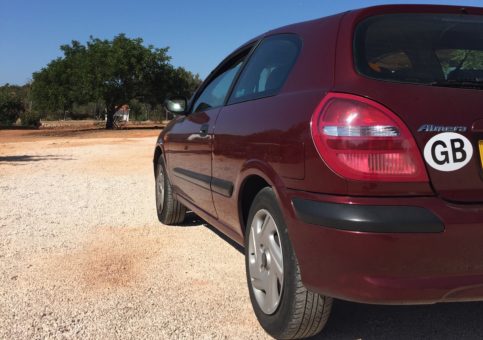
Things like insurance, vehicle tax and fuel will really depend on the car, the way you drive and your car insurance history. Fuel costs varied quite a bit from country to country, Spain was the cheapest at just over £1 per litre, while the Netherlands was the most expensive at closer to £1.30 per litre. We avoided tolls as much as possible, this probably saved us quite a bit of money but cost us more time. Some journeys were twice as long because of this. In Austria, Slovenia and the Czech Republic we had to buy weekly or monthly vignettes so that we could drive on the motorways. Parking wasn’t too expensive and we made good use of Parkopedia to find the cheapest car parks.
We also used a fair bit of public transport when we were staying in big cities. Prague was the cheapest where we got a month’s ticket to use the metro, trams and buses for about £23.50 per person. Amsterdam was the most expensive since we stayed about 20 mins out of the city in Weesp and had to pay about £7 for a day return per person. When our families visited us in Prague and there were four of us, we used Uber quite a bit, which was pretty inexpensive and much more convenient than walking, taking the bus, tram or metro.
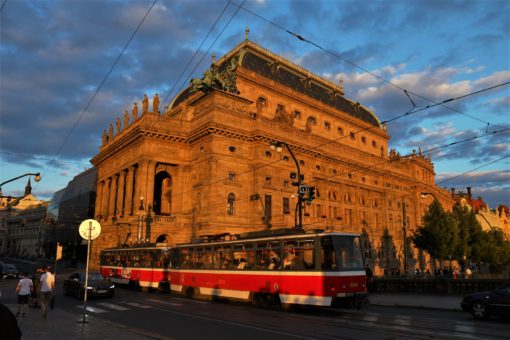
Europe activity costs
Mostly all our sightseeing was free, including hiking and wandering around cities. We took ‘free’ walking tours, where you pay a tip rather than a fixed fee, in Amsterdam, Slovenia and Prague, which we paid between €5-7 each for. Our most expensive activities were Neuschwanstein Castle in Germany (definitely worth the cost) and watching a production of A Midsummer Night’s Dream at the Czech National Theatre. *Note that the Lisbon Tourist Card listed below was generously comped to us by Get Your Guide.

Cost to travel Europe – miscellaneous
The only miscellaneous Europe travel costs we had were for some new clothes, as we bought a couple of jumpers and some jeans while we were in Porto.
Total cost to travel Europe for three months
So, can you travel Europe on a budget? The answer’s yes, depending on what you define as budget. We managed to travel around Europe for under £50 per day for two people, which is only £15-20 more than we spent per day in Asia, for instance. We were pleased with all the amazing places we saw and had some incredible experiences, especially at the excellent Christmas markets.

Pin Me For Later!
How do you think we did? Did we travel around Europe on a budget you could use? Let us know what you think of the cost to travel Europe in the comments below.
13 Comments
Gilda Baxter
Wow…I am impressed with how well you have done. Having the car was a good idea since it has given you more freedom and flexibility. Brian and I like the idea of touring Europe in a motor home. Your food costs were very good indeed, cooking your own meals is best. I love eating out, but it can be expensive. I loved your itinerary and visiting these places during the Autumn has probably also further helped to stay in budget? Great post ?
Andrew Wyatt
Thanks Gilda, you’re right, visiting in the off-season probably helped keep some of our costs down too. I hope you and Brian get to travel around Europe in a motor home, that sounds exciting! 🙂
Did you look into buying a left hand drive car for Europe? We have a three month trip in France, Spain and Portugal planned and are thinking of buying a car in France. Not sure how easy it will be to insure though?
Hi Dan, good question, but no we didn’t even think about it. Since we’re from the UK and Amy’s dad works as a mechanic, he had some good connections and made sure our car was reliable too. It would be interesting to know how the car buying process goes for you in France though. Also I’ve driven a right hand drive car in mainland Europe before so I knew that wouldn’t be a problem for me. Enjoy your trip!
Just to update, it proved impossible to buy a car in France as a non-resident so we bought one off eBay in the UK and drove over instead. So far so good, it looks like we are retracing some of your haunts, going towards Porto from Lisbon on Thursday!
Hi Dan, thanks for the update, glad you managed to sort the car issue. Have fun in Portugal, we loved it and are looking forward to returning again in the autumn!
Neil Dimapilis
this is amazing! Thank you for sharing this with us. appreciate you disclosing this kind of information to us. did you bring bills on your trip or just used a card? i read in one article that you should bring less cash on trips to Europe?
Hi, we just used our overseas bank card, which doesn’t charge a fee for withdrawals abroad.
Can you please share list of cities you covered in 3 months?
Hi, we went to Amsterdam, drove down to Portugal, went to Lisbon, Porto and the Algarve. Then we drove up to Slovenia to Ljubljana, made a stop at Neuschwanstein castle in Germany and then stayed in Prague for a month. On the way back we stopped in Cologne and Bruges.
Barato Travels
Great Post and Stunning Pictures. Your tips were very useful for Europe traveler. Europe is an awesome place for roaming. I love Europe. I read your blog and really happy with your information on Europe traveling. Thanks for such post and please keep it up.
Thanks – glad you found it useful!
I loved you budge5 but as 1 person air bnb untenable I ve found I use dorm in hostel and when really tired tiny hotel. I should be like you and buy and prepare food. I also ho to museums and oay entrances. T3nd to book mini trips as asthmatic so cant hike uphill etc. Think will eventually head back to India as best for budget
Save my name, email, and website in this browser for the next time I comment.
This site uses Akismet to reduce spam. Learn how your comment data is processed .

- Help Center
- 1-866-921-7925
Start Searching
- Packages
- Hotels
- Cruises
- Rental Cars
* Indicates required fields
Rental Period:
pickUpDate - dropOffDate
Pick-Up: pickUpTime - Drop-Off: dropOffTime
Pick-Up Location:
pickUpAddress
pickUpAgencyName
pickUpAgencyAddress
Drop-Off Location:
Same as Pick-Up Location
dropOffAddress
dropOffAgencyName
dropOffAgencyAddress
Coupon Override
Please call.
For drivers under the age of 25, additional fees and/or restrictions may apply.
For information and assistance in completing your reservation, please call:
We're unable to find your location.
Alaska Cruise Tours:
A cruise tour is a voyage and land tour combination, with the land tour occurring before or after the voyage. Unless otherwise noted, optional services such as airfare, airport transfers, shore excursions, land tour excursions, etc. are not included and are available for an additional cost.
Vacation Packages
Choose your european adventure, choose your own european adventure; discover secret beaches in greece, explore ancient castles in ireland or hunt down the best wine in france..
Explore the museums of Madrid, sip espresso by the canals of Venice and witness the Changing of the Guard in London. Europe has something to offer everyone.
- Netherlands
Featured Deals
Best of italy: your way.
Daily Breakfast Private Airport Transfers and Rail Tickets
London and Paris: Your Way
$200 Instant Savings Daily Breakfast, $400 London Tour Credit Rail Tickets on Eurostar, Executive Member Benefits
Madrid, Seville and Barcelona: Your Way
Daily Breakfast Airport Transfers and Rail Tickets on RENFE Additional Executive Member Benefit at Select Hotels
Athens, Santorini and Mykonos: Your Way
Daily Breakfast Choice of Accommodations
Venice, Florence, Rome and Sorrento: Your Way
Daily Breakfast Executive Member Benefit at Select Hotels
Ireland: Your Way Package
Dublin, Killarney and Galway Daily Breakfast Self-Drive Countryside
Amsterdam, Paris and London: Your Way Package
Daily Breakfast $400 London Tour Credit Rail and Private Airport Transfers
Athens, Santorini and Central Crete: Your Way
Edinburgh and scottish countryside: your way.
Daily Breakfast Self-Drive Countryside
The Costco Traveler Blog
Sipping afternoon tea, two faces of italy, canals run through it, more about europe.
Europe blends its rich history and modern innovation seamlessly. From the catwalks of Paris fashion week to the awe-inspiring ruins of Greek temples you'll find it hard to fit everything into one vacation. The vast expanse of Europe is covered in numerous cultures, languages and landscapes that can make you feel like you've been transported onto the set of a movie. Sit down for a cup of tea in London, learn how to make your own pasta in Italy or simply take time to stare in wonder at the amazing Highlands of Scotland. Whether you're traveling with family, friends or your special someone, a trip to Europe will be a vacation to remember.
Content provided by Costco Travel experts. Copyright © Costco Travel. All rights reserved.
Before You Go
- To make it easier to replace your passport if it’s lost or stolen, in addition to your passport, take a photocopy of your passport information page (keeping it separate from your actual passport).
- Carry only a limited amount of cash, just enough for gratuities and incidental purchases. Major credit cards are widely accepted and can be replaced if lost or stolen.
- Always lock your hotel room door (including patio and balcony door on any level of the building) and use the peephole before opening the door.
- Store your valuables (such as cash, credit cards and airline tickets) in the hotel’s in-room safe or front desk safety deposit box.
- If you must carry valuables on your person, do so in a pouch or money belt concealed under your clothing. Purses and backpacks can be easy targets for thieves.
- For complete and current safety and security information, including travelers' tips, public announcements, travel advisories and more, please visit the website of the U.S. Department of State at www.travel.state.gov.
- December through February: 49° to 49° (Winter)
- March through May: 54° to 66° (Spring)
- June through August: 72° to 76° (Summer)
- September through November: 70° to 54°
Explore More Travel
Vacations with instant savings of $100 or more.
Explore Deals to Hawaii,
the Caribbean, Mexico and More
Vacations of a Lifetime
For an Experience as Unique as You Are
Exclusively for Costco Members
Rental Cars
One Additional Driver Fee Waived
Executive Members Earn an Annual 2% Reward
Member reviews become available after at least 5 are received in order to provide you with an accurate picture of this travel product.
We are processing your payment.
Do not refresh your browser or exit this page.
- Your current location
Price per liter
Your route preferences.

‘Most Underrated' European Destination Costs Only $250 For Everything
Traveling is one of the most advantageous things one can do in life. It offers a sense of renewal and new perspective, adventure, or relaxation. However, it’s also a costly luxury that many people won’t have. However, traveling on a budget is possible. For example, one “underrated” destination costs around $250 for a long weekend. Fortunately, the internet is full of seasoned travelers , sharing their hacks for a more affordable getaway.
Amazing Travel on a Budget
@emsbudgettravel has more than 50,000 followers on TikTok where she shares tips for people traveling on a budget. She recently shared a video after traveling on a budget to 9 destinations since the start of 2024. Her “favorite” has been Sarajevo in Bosnia. “ So I’ve just come back from four days in Bosnia and Herzegovina, which is a country in the Balkans in Eastern Europe .” She told followers.
Read More: Ex-MIL Wants to Take Mother's 1-Year-Old To On Vacation for 3 Months and Won't Take No For an Answer
Cheap Yet Lovable City
“ I only spent £158.44 in total for everything including flights, accommodation, food, activities, and transport. Literally everything .” Em explained. “ So it definitely lives up to the reputation of being one of the cheapest countries to visit in Europe. We stayed in the capital of Sarajevo, which is a beautiful city and it felt really safe.”
“ The locals were very friendly. Even the bus drivers. The whole country is filled with stunning scenery, mountains, rivers, lakes, and waterfalls. If you come to Bosnia you also have to visit Mostar, which is a small city about two hours away from the capital on the train. ” She said, recalling the destination’s hospitality. “So it’s an easy day trip, but this was the highlight of the trip for me. The city felt so magical and it was a perfect base to explore for hours. People also jumped off the bridge here into the river, which was interesting too. Overall, it was an amazing trip and I definitely wanted more than the four days I had here so this is somewhere I’ll definitely be revisiting to explore more.”
Flights for Traveling on a Budget
She noted Ryanair “recently started flying here really cheaply. ” Her flight from London Stansted Airport to Sarajevo International Airport cost around $25. Whereas 4-star hotels in the area can be as low as around $60 per night.
Read More: Man Is Certain His Wife Died 3 Years Ago, Accidentally Meets Her on Vacation – a Short Story
Helpful Hints for Traveling on a Budget
After the flights are booked, luggage has to be addressed. Many airlines once included the cost of a checked bag and carry-ons in the cost of the flight. However, that’s not the case for every airline anymore. One sure way to travel on a budget is to pack light, avoiding an unexpected checked bag fee if your luggage is too heavy. Pack everything in the same 2 colors so you can mix and match but everything will always go together. Additionally, consider a color wheel when selecting colors that may be complimentary or contradictory.
Avoid Airport Food
While traveling with beverages from outside the airport isn’t an option, food and snacks are allowed. It’s a good idea to bring snacks, rather than pay for overpriced food that likely isn’t high quality.
While many tourist destinations are worth exploring, they aren’t the only spots around. Traveling on a budget may be easier if you shop at local grocery stores and cook. Or eat out at places that aren’t in the heart of tourist destinations, or are considered a “tourist trap”.
Avoid Tourist Traps Altogether
A “tourist trap” is a destination with outrageously high or inflated prices on goods, services, entertainment, and food because they’re popular and people are willing to pay a lot for the opportunity to see these places. However, other cities exist outside the most popular destinations worldwide and offer similar experiences, scenery, or cuisine.
Sign up for Perks
Lastly, people who travel often are incentivized by airlines. This includes things like bonus points for using their credit cards, and deals on hotels, flights, or rentals. Another perk of frequent travel is access to airport lounges. Travelers pay an annual membership fee and have access to better-quality food and beverages. Additionally, some hotels like the Hilton have a price match guarantee.
Traveling on a budget may seem difficult but people like @emsbudgettravel are sharing their wisdom with others, making travel far more attainable for the average person or family.
Read More: Millennials Are ‘Quiet Vacationing' Instead of Asking for Time Off
- “ Europe’s ‘most underrated’ destination where a long weekend costs less than £200 for everything. ” Lad Bible . Tom Earnshaw. June 10, 2024.
- “ 12 Easy Money Saving Travel Tip s.” Nerd Wallet Sally French May 28, 2024.
- “ 4 Uncommon Tips for Saving Money on Travel .” Nerd Wallet . Josh Garber. October 3, 2022.
The post ‘Most Underrated' European Destination Costs Only $250 For Everything appeared first on Secret Life Of Mom .

- What is travel insurance?
- Average cost
- When to buy travel insurance
- Average cost by age
- What does travel insurance cover?
How Much Does Travel Insurance Cost?
Affiliate links for the products on this page are from partners that compensate us (see our advertiser disclosure with our list of partners for more details). However, our opinions are our own. See how we rate insurance products to write unbiased product reviews.
- The average travel insurance premium this week is $279.32, down about 1.5% compared to last week.
- For travel in the United States, the average premium is $94 to $396.
- Travel insurance protects against delayed baggage, trip cancellation, and more.
The average cost of travel insurance fluctuates throughout the year, based on demand and whether or not school's in session. Also keep in mind that where you're traveling and how many people are taking the trip will affect your exact premium.
Understanding Travel Insurance
Travel insurance plans can cover both domestic and international travel. It could protect against something as familiar as delayed baggage (experts estimate 85% of lost luggage is returned to its owner within 48 hours) or as complicated as trip cancellation.
The benefits and limitations of travel insurance vary based on the company and plan. Above all else, this insurance coverage offers peace of mind.
Some credit cards offer a limited amount of travel insurance annually. If you need clarification on what your credit card offers, contact your provider to verify. These plans are great for cancellations and interruptions but may not cover more costly losses associated with unexpected medical expenses or emergency evacuations.
Individual travel insurance plans include this and much more. Travel insurance protects travelers from the unexpected when away from home.
Average Cost of Travel Insurance by Destination
Some countries are naturally more expensive travel destinations due to higher flight and lodging costs, which could increase travel insurance costs. Travel insurance will generally cost 5% to 10% of your total trip price, according to SquareMouth travel insurance .
Here's how the prices stack up:
Source: SquareMouth
How Far in Advance to Purchase Travel Insurance
According to an AAA travel survey , 88% of travelers say that reimbursement after a trip cancellation is the most valuable benefit of trip insurance.
According to data gathered by SquareMouth in the last six months, travelers tend to purchase trip cancellation travel insurance 53 days before their trip. Meanwhile, travelers without trip cancellation insurance will buy a policy approximately 16 days before their trip. Regardless of when you buy, cancellation protection can kick in to protect you against the unexpected.
Average Cost of Travel Insurance by Age
A traveler's age is a significant factor in determining the cost of travel insurance. The older a traveler is, the higher travel insurance premiums are. For instance, a senior traveler may need more insurance for health-related emergencies than a millennial.
When calculating your travel insurance premium, travel insurance providers consider the likelihood of a medical emergency.
Get your free travel insurance quote with SquareMouth »
Travel Insurance Rate Tips
Travel insurance rates through most providers fall between 4% and 8% of the total trip cost. Like the cost of flights, cruises, etc., rates may vary substantially based on the season, your original location, your destination, and other factors. This week, the average cost of a policy was close to $300.
To save money on travel insurance, tailor your policy to your specific needs and avoid unnecessary extras. You should also shop around to compare quotes from multiple insurers. Opting for an annual plan if you're a frequent traveler, checking existing coverages from other insurance policies or credit card benefits, and choosing a policy with a higher deductible can significantly lower your premiums. Always read the fine print to understand your coverage fully, ensuring you don't pay for redundant or irrelevant features.
To find affordable travel insurance, consider using online comparison websites like SquareMouth or InsureMyTrip to see rates from various providers. Other ways to save include purchasing directly from insurance companies, exploring package deals from travel agencies or airlines, utilizing included coverage from credit card benefits, and checking for discounts through membership organizations such as AAA or AARP.
Editorial Note: Any opinions, analyses, reviews, or recommendations expressed in this article are the author’s alone, and have not been reviewed, approved, or otherwise endorsed by any card issuer. Read our editorial standards .
Please note: While the offers mentioned above are accurate at the time of publication, they're subject to change at any time and may have changed, or may no longer be available.
**Enrollment required.

- Main content
- TV & Film
- Glastonbury
- Say Maaate to a Mate
- First Impressions - The Game
- Daily Ladness
- Citizen Reef
To make sure you never miss out on your favourite NEW stories , we're happy to send you some reminders
Click ' OK ' then ' Allow ' to enable notifications

The ‘new Iceland’ that is just two hours from UK and costs less than £100 to visit
There are also a load of exciting activities on offer.
For years, Brits have loved travelling to Iceland (the country, not the supermarket chain) for the Northern Lights and stunning views - but the country is notoriously expensive.
If you want to book a trip there, you might be looking at dropping a fair few quid on hotels and flights in the process. Not to mention £7 pints.
Iceland received a record-breaking 2.2 million visitors in 2023 and it could set you back nearly £200 each way on flights in the busy months, according to Expedia.
Meanwhile, a potentially much cheaper alternative is a place with 18 volcanic islands, between Iceland, Norway and Scotland.
The ‘new Iceland’

The Faroe Islands have been dubbed the 'new Iceland', and are only a two hour and 10 minute flight from London.
Amid the top ten things to do in the Faroe Islands is visiting the wonderful Mulafossur Waterfall, or to take a historic walking tour in Tinganes.
You can also go on boat tours to visit the wild Vestmanna bird cliffs of northwestern Streymoy, as well as plenty of cathedrals, castles and lighthouses on offer - a nice addition to your Instagram highlights.
And for the first time, Atlantic Airways are running direct services from Gatwick on Tuesdays and Saturdays from 1 June to 31 August.
Depending on when you book, you're looking at flights upwards of £96, which is a lot cheaper than flying to Iceland, as reported by the Metro.
What do visitors think of the Faroe Islands?

Visitors have largely been raving about the destination, with one person commenting: "We visited Iceland before Faroe.
"IMO, Faroe landscapes took my breath away…more than they did in Iceland…[they were like] something out of the wildest story book.
"If you want calm and quiet then the Faroe Islands will have that in spades, even more so than Iceland," penned a second.
Although they warned: "Just be prepared/cautious when hiking alone though, even though it’s a small place you can end up isolated pretty damn quickly, and there’s no shelter from the elements once you’re out there."
"Having just returned from four wonderful days on the Faroe Islands I can heartily recommend it to anyone who wants to truly get away from it all," someone else said.
"An important word of warning however, you may get away from more than you bargained for.
"The Faroe Islands are not as well connected to the outside world as you may expect."
Topics: Travel , Holiday
Anish is a GG2 Young Journalist of the Year 2024 finalist. He has a Master's degree in Multimedia Journalism and a Bachelor's degree in International Business Management. Apart from that, his life revolves around the ‘Four F’s’ - family, friends, football and food. Email: [email protected]
@ Anish_Vij
- Travel expert urges Brits to visit two countries both less than three hours away
- Jet2 reveals new flight route from UK after ‘strong demand’ from Brits
- Tropical island four hours away from UK has year long summers and costs just £400 for week's holiday
Hidden destination just three hours from UK is being called 'Thailand of Europe'
Choose your content:.

Psychologist explains surprising effects on passengers doing new 'raw dogging' flight trend
It turns out that there could be a benefit to the new 'raw dogging' trend.

Punters shocked as Glastonbury 2024 drink prices increase yet again
Drinks prices at glastonbury have increased yet again as expected.

Lots of people have mistaken the European holiday spot for Thailand

Woman explains why she 'raw dogs' flights as new travel trend is leaving the internet baffled
Not everyone needs to spend their flights constantly distracted.

IMAGES
VIDEO
COMMENTS
Average Trip to Europe Cost in 2024. An average seven-day vacation in Europe costs close to $1,800. This can be broken down as follows: Average Accommodation Cost: $455. Average Flight Cost: $750. Food, Drinks & Activities: $378. Transportation: $200. Total Cost: $1,783.
Here are the travel cost rankings of the countries in Europe, ordered from most expensive to least expensive. The travel prices for each country come from actual travelers, and are listed as per person, per day. Now you can find out which countries are the cheapest to visit, and which are the most expensive for travel.
More insights into how I travel full-time and what it costs to live and travel in Europe. First, though, let's talk about travel styles… Luna sporting bedhead in Gozo, Malta. What full-time travel looks like for me. First, it's important to say that there's no right or wrong way to travel full time. There's no standard.
Backpacking Europe Suggested Budgets. Prices for travel in Europe vary greatly depending on how far north, east, south, or west you travel. If you stick to the budget accommodations, food, and tours listed here and use all my tips on saving money, you need about 65-110 EUR per day in Western Europe, 40-50 EUR in Eastern Europe, and about 85-130 EUR in Scandinavia.
The average cost for museums and galleries around Europe is 10-20 Euros. Day tours are around 100 Euros, but lots of stuff is free as well. We'll put an average spend of attractions at 20 Euros, to account for the cheaper and the more expensive options. Keep in mind, this is just an estimate.
From AU$1,680^ per person. 7 nights in Paris, 7 nights in Barcelona, 7 nights in Rome and 7 nights in Athens (in budget accommodation) Public Transport. AU$450. For a youth, 2nd class ticket that allows travel on 5 days within 1 month, for 5 European countries of more. Total.
You may also want to budget some money for souvenirs and travel insurance. Total Trip to Europe Cost. A seven-night trip to Europe for two people will cost an average of $7,900, or $564 per person, per day. Category: Expense: Airfare: $2,000: Accommodations: $2,050: Transportation $ 800: Tours & activities: $1,000: Food:
Show more popular tours. How much does a trip to Europe cost? Learn more about Europe tour budget, cheapest and most expensive destinations to travel.
Food: $515. Transportation: $58. Flights: $6. TOTAL: $888. Prior to my trip, I had two main travel gear expenses- my new all-time favorite travel backpack, the Osprey Aura 65, and some Europe-appropriate clothing that I was lacking (dresses, light jackets, shorts, etc.) My 3-month journey abroad began in New York.
Nov 6, 2023. One-Month Europe Trip on a Budget: A Full Itinerary and Cost breakdown. This guide includes my full itinerary and cost breakdown for accommodations and transportation between cities. It also contains things to do and where to stay in London, Paris, Ghent, Bruges, Barcelona, Seville, Granada, Cordoba, and Madrid.
If you choose to stay in only one city, bus or train rides are very cheap, ranging from 1 to 3 euros. You can also buy 24 to 72 hour passes. If you choose intercity travel, average prices are: From Lisbon to Madrid: 16 euros; From Madrid to Rome: 26 euros; From Rome to Paris: 23 euros; From Paris to London: 38 euros.
Below are the budget ranges you should allocate for food, guided tours and accommodation. You can also check out our 3 weeks in France, Italy, and Spain itinerary. food budget per day: $20. guided tours cost per day: $15-$30. accommodation cost per day: $25-$45 as a backpacker or $70+ for mid-range.
Step 1: Determine your travel dates. The first step in planning a budget trip to Europe is to determine your travel dates. This will help you set a timeline for your trip and allow you to plan your budget accordingly. Consider the time of year you want to travel. Europe experiences different seasons, each with its own advantages and drawbacks.
Cost of Coach/Bus Travel In Europe. Taking long-distance buses is probably the cheapest way to travel in Europe but it's also the slowest and arguably the most uncomfortable. Personally, I won't even consider the bus if the trip is more than a few hours as 8 hours on a bus sounds terrible. Either way, I use Omio to find and book bus tickets.
Call it $800 for two. Rental car: You can rent a small car for under $300 a week, including taxes and fees, in most of Europe; less than that in some countries. Use your credit card to provide ...
Serbia. Daily cost: €18.75. Serbia is the most affordable country on a day-to-day cost analysis. If you are carefully considering travel costs in Europe, Serbia is a great option for budget travellers. Belgrade is a surprising city with so much to offer visitors and I can highly recommend it!
For every expensive city, there are dozens of charming — and surprisingly affordable — places that offer all the European charm for a fraction of the price. Ljubljana, Porto, Budapest, even ...
Europe Travel Tips: Average Daily Costs. Based on online research and personal experience, the average Europe trip cost will be between USD$60 and $100 per day. In Eastern Europe expect to spend around two-thirds of that ($40 to $70). It's worth re-emphasising how these figures will always be a rough estimate!
But, a good estimate is about $4,280. One time I spent just $2,300 because I focused on doing it for as cheap as possible. Another time I spent closer to $8,000 (for two people) when visiting just three cities. The cost of a Europe trip depends on you, but it's not hard to stretch your travel budget.
Here is the average daily cost of a Europe trip for a solo female traveler. Accommodation: 20-100€. Food: 15-50€. Transportation: 0-10€. Tourist Attractions: 5-20€. Total Cost Of A Europe Trip Per Day: 40-180€. A 2-week Europe trip costs from 500-2500€, depending on your travel style and itinerary.
In Europe, you'll quickly find that your money goes a lot farther in the Eastern European countries than it does in the Western European countries. ... our goal is to help you plan your next trip on the right budget. With average daily travel costs that are calculated from the budgets of real travelers, plus an analysis of hotel and tour prices ...
Total cost to travel Europe for three months. So, can you travel Europe on a budget? The answer's yes, depending on what you define as budget. We managed to travel around Europe for under £50 per day for two people, which is only £15-20 more than we spent per day in Asia, for instance.
Choose Your European Adventure. Click for Deals. Choose your own European adventure; discover secret beaches in Greece, explore ancient castles in Ireland or hunt down the best wine in France. Explore the museums of Madrid, sip espresso by the canals of Venice and witness the Changing of the Guard in London. Europe has something to offer everyone.
According to many estimates, a three-week European vacation can cost between $3,000 and $5,000 per traveler. There are ways, however, to save on travel to Europe.
ViaMichelin is a specialist in route calculation in Europe. Calculate your pedestrian, motorcycle, or car journey for free. Take advantage of our multiple calculation options: the fastest route, the most economical route, or the discovery route (which allows you to choose the most picturesque roads). Provide information about your vehicle ...
Secret Life Of Mom. . Traveling is one of the most advantageous things one can do in life. It offers a sense of renewal and new perspective, adventure, or relaxation. However, it's also a costly ...
The average travel insurance premium this week is $279.32, down about 1.5% compared to last week. For travel in the United States, the average premium is $94 to $396. Travel insurance protects ...
It is shaping up to be the busiest summer season ever in the U.S., and about as strong as 2019's in Europe. Yet both low-cost and full-service carriers are recording far narrower profit margins ...
If you're a T-Mobile customer on qualifying plan, you can add an International Pass to get more high-speed data and unlimited voice calling in 215+ countries and destinations. 1-Day (512MB) International Pass: 512MB of high-speed data and unlimited calling, to be used up to 24 hours, for $5. 10 day (5GB) International Pass: 5GB of high-speed ...
The Faroe Islands has been dubbed as the 'new Iceland', which is only a two hour and 10 minute flight from London. Amid the top ten things to do in the Faroe Islands is visiting the wonderful ...